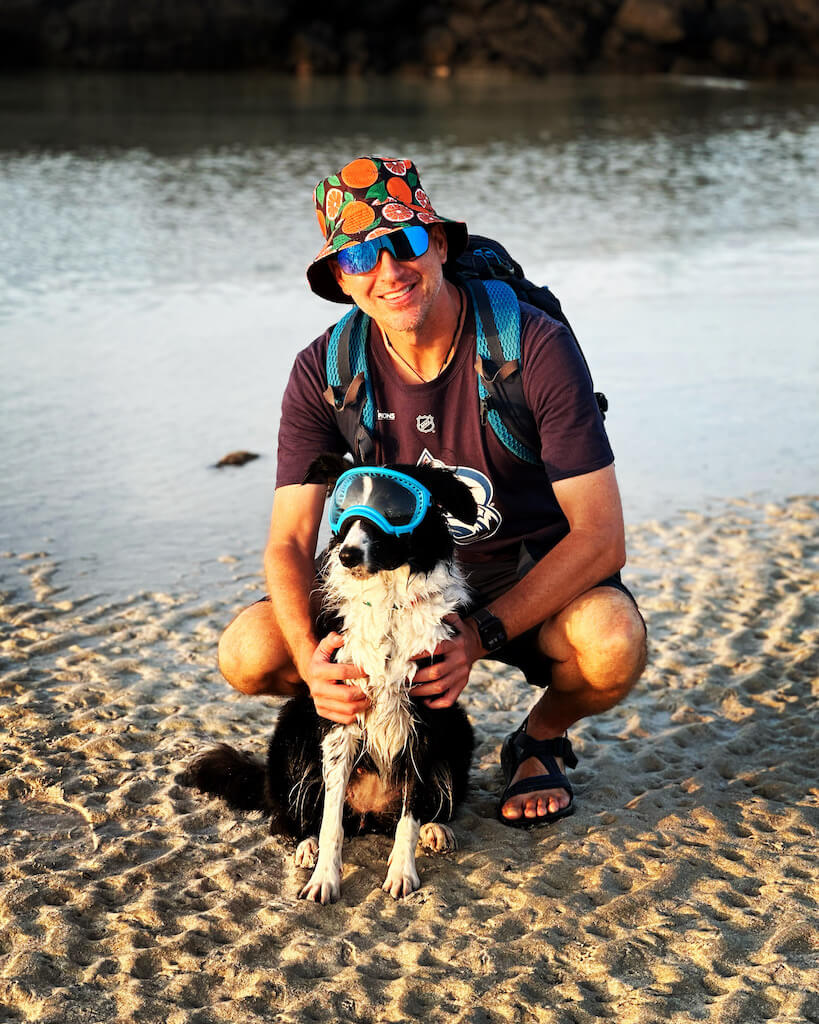Planning a Sapa Vietnam self guided travel adventure? In this detailed itinerary, we’ll help you explore Sapa without a tour, covering trekking routes, Fansipan Peak, and Cat Cat Village.
🌾 Why Explore Sapa Without a Tour?
Yes, you can absolutely explore Sapa without a tour. My wife and I spent three nights in town and saw everything we wanted to, on our own terms, without a guide or fixed itinerary.
Whether you’re trekking through the Muong Hoa Valley, riding the Fansipan cable car, or wandering Cat Cat Village, Sapa is surprisingly doable as a self-guided trip. This guide walks you through how we did it, including maps, tips, and itinerary suggestions for every season.
We opted out of tours after a crowded Ha Long Bay experience and a bout of flu that had us rethinking group settings. That decision turned out to be a good one. Going solo let us move at our own pace, adapt to the weather, and build in plenty of noodle breaks without anyone rushing us.
And yes, we stayed on budget, even with a nicer hotel thrown in.
Quick heads up: This post may contain affiliate links to gear, hotels, flights, or experiences I’ve used — or genuinely recommend. If you book through one, I may earn a commission at no extra cost to you. Full disclosure here.
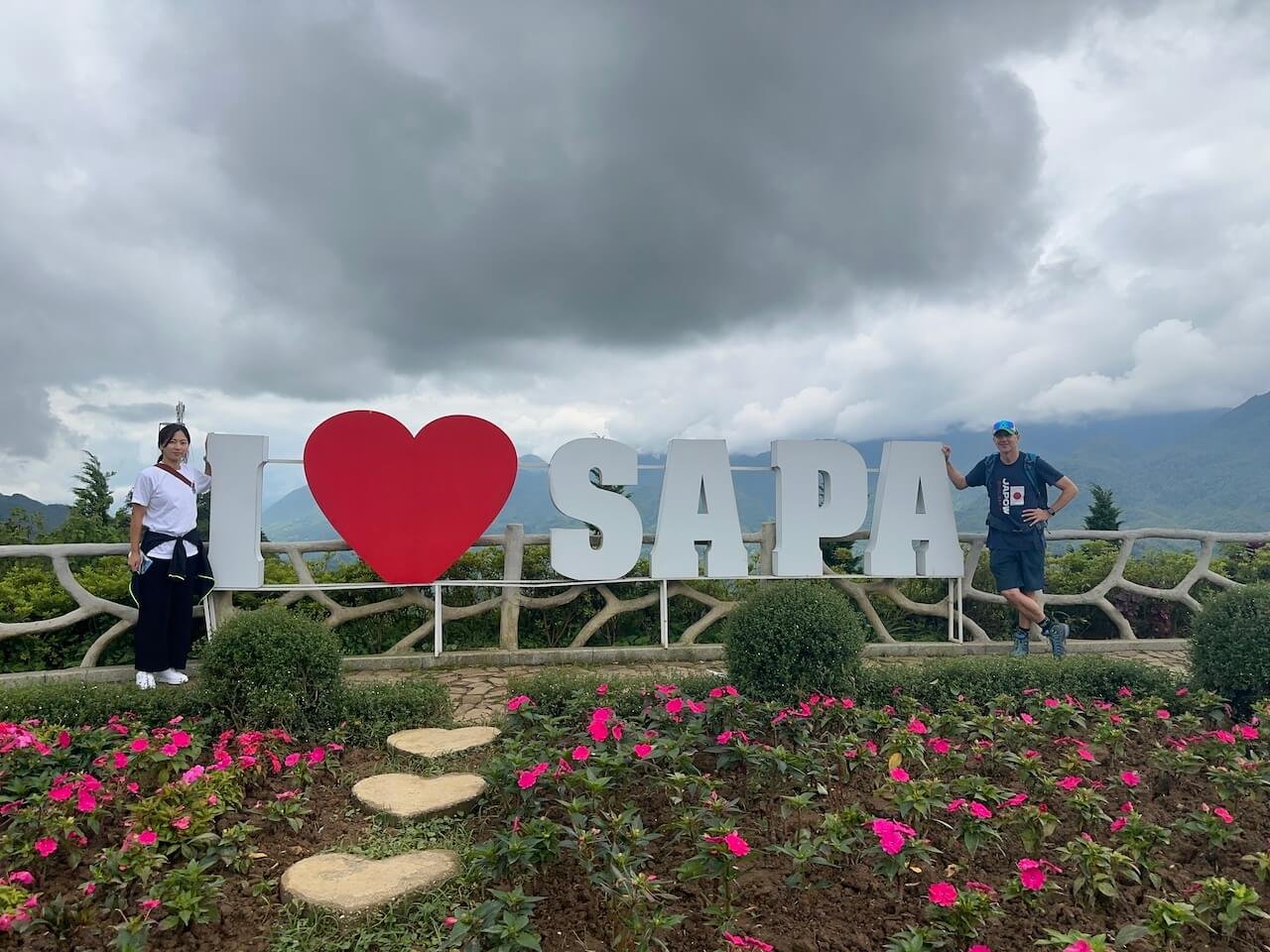
👉 Looking for a quicker read focused on our 3-day itinerary?
This detailed itinerary walks you through how we spent our three nights in Sapa. It includes trekking through the Muong Hoa Valley, visiting Fansipan Peak, and wandering Cat Cat Village, all without a guide or fixed schedule.
🌍 My Travel Style and Why We Skipped the Tours
In Korean, the word saram means “person.” So “Colorado Saram” simply means “Colorado person.” I grew up in the ski town of Vail, Colorado, but I’ve spent the last several years living and teaching in South Korea. In case you’re wondering why I bring that up, take a look at the site name in your browser tab.
These days, I use South Korea as a home base to explore Asia, usually with my wife, a backpack, and a loose plan built around trekking, food, and places that aren’t overrun.

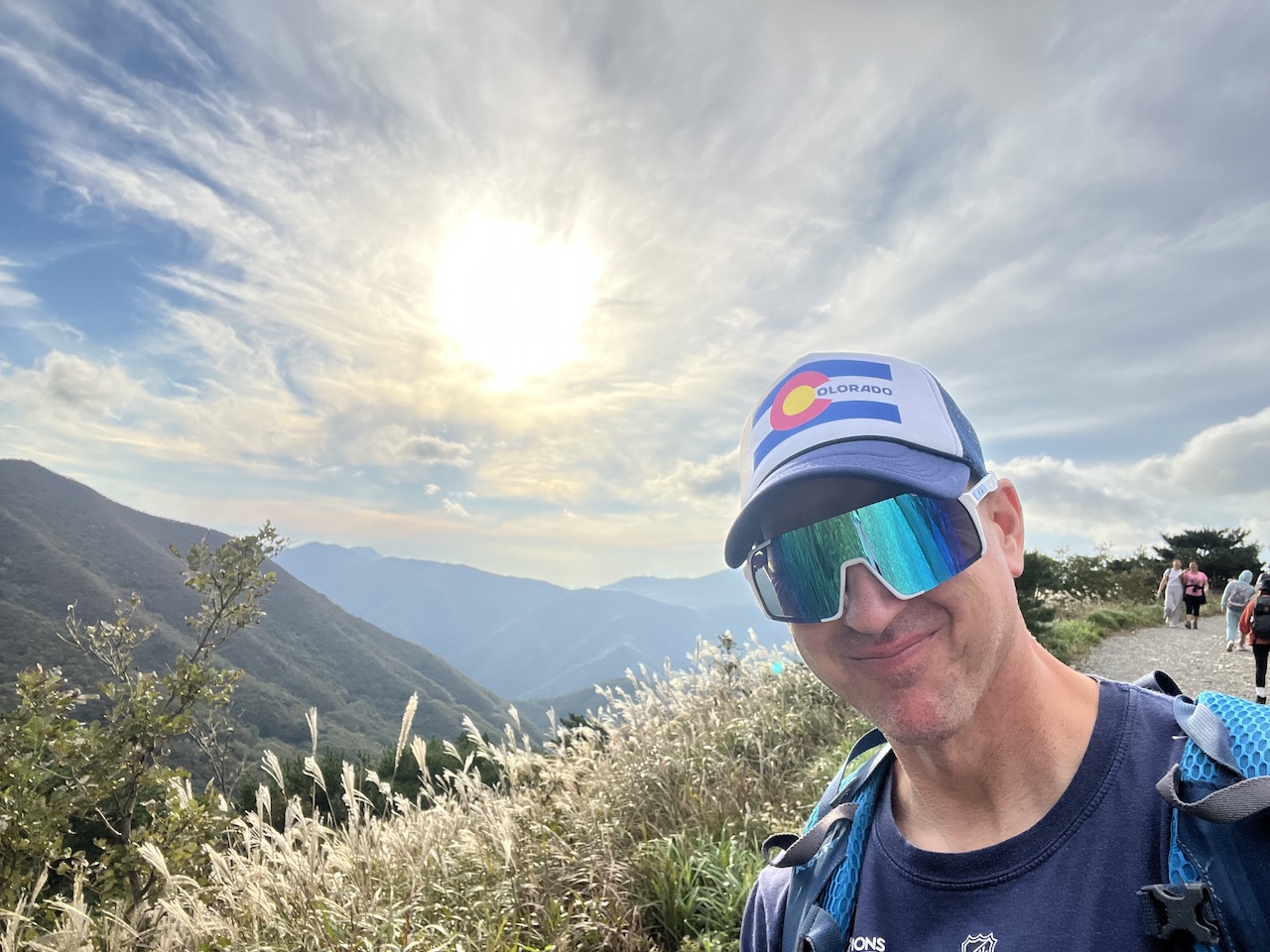
Sapa had been on my radar since I moved to Korea in 2007. As an outdoor enthusiast, I’d long wanted to see the rice terraces and mountain valleys for myself. I finally made it happen after a stretch of travel through northern Vietnam.
My travel style has changed over the years. The dirtbag backpacker days are mostly behind me. I still travel on a budget, but I also care about comfort. That might mean booking a nicer hotel when it matters or choosing a shared minivan instead of the cheapest bus.
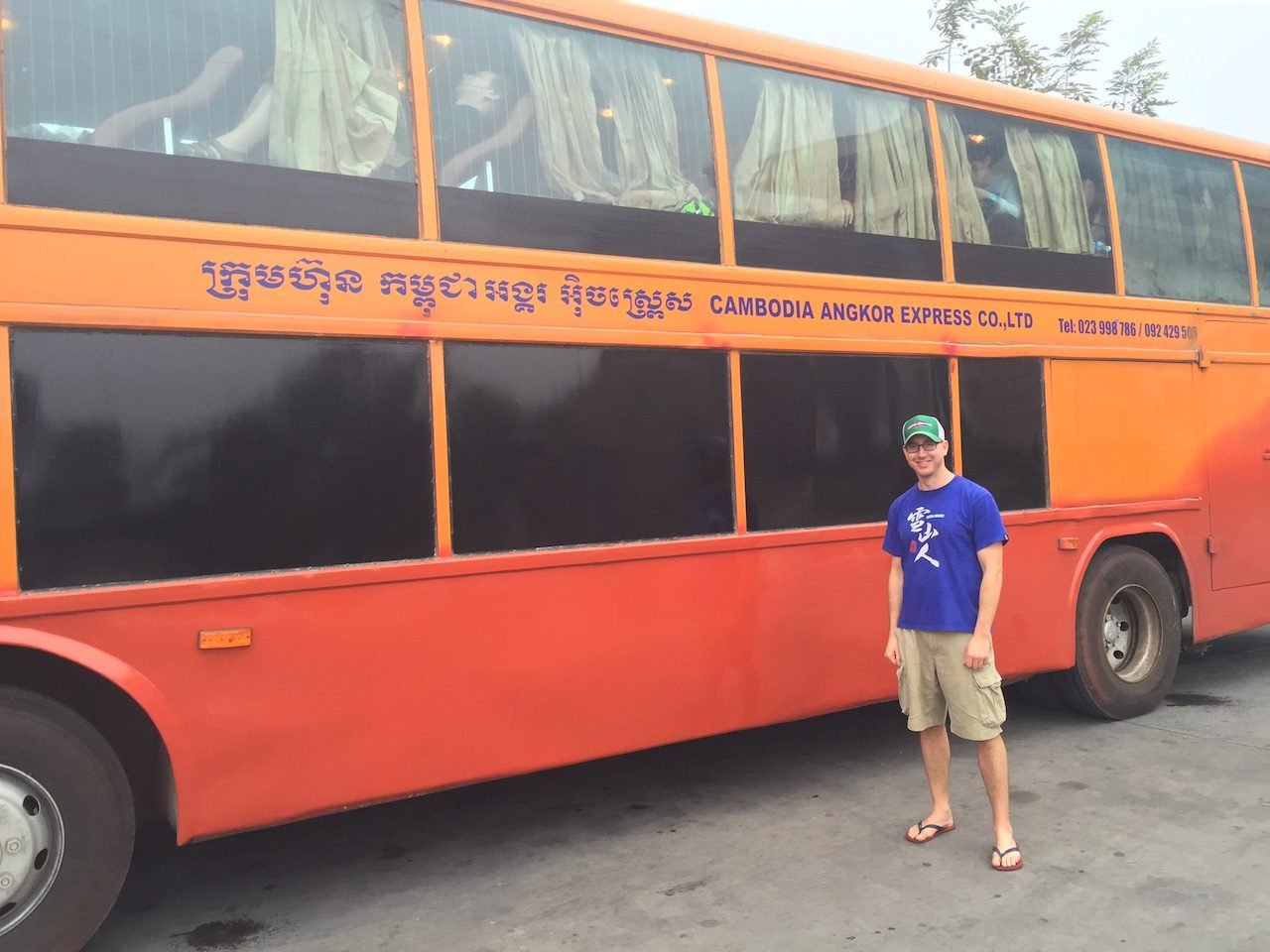
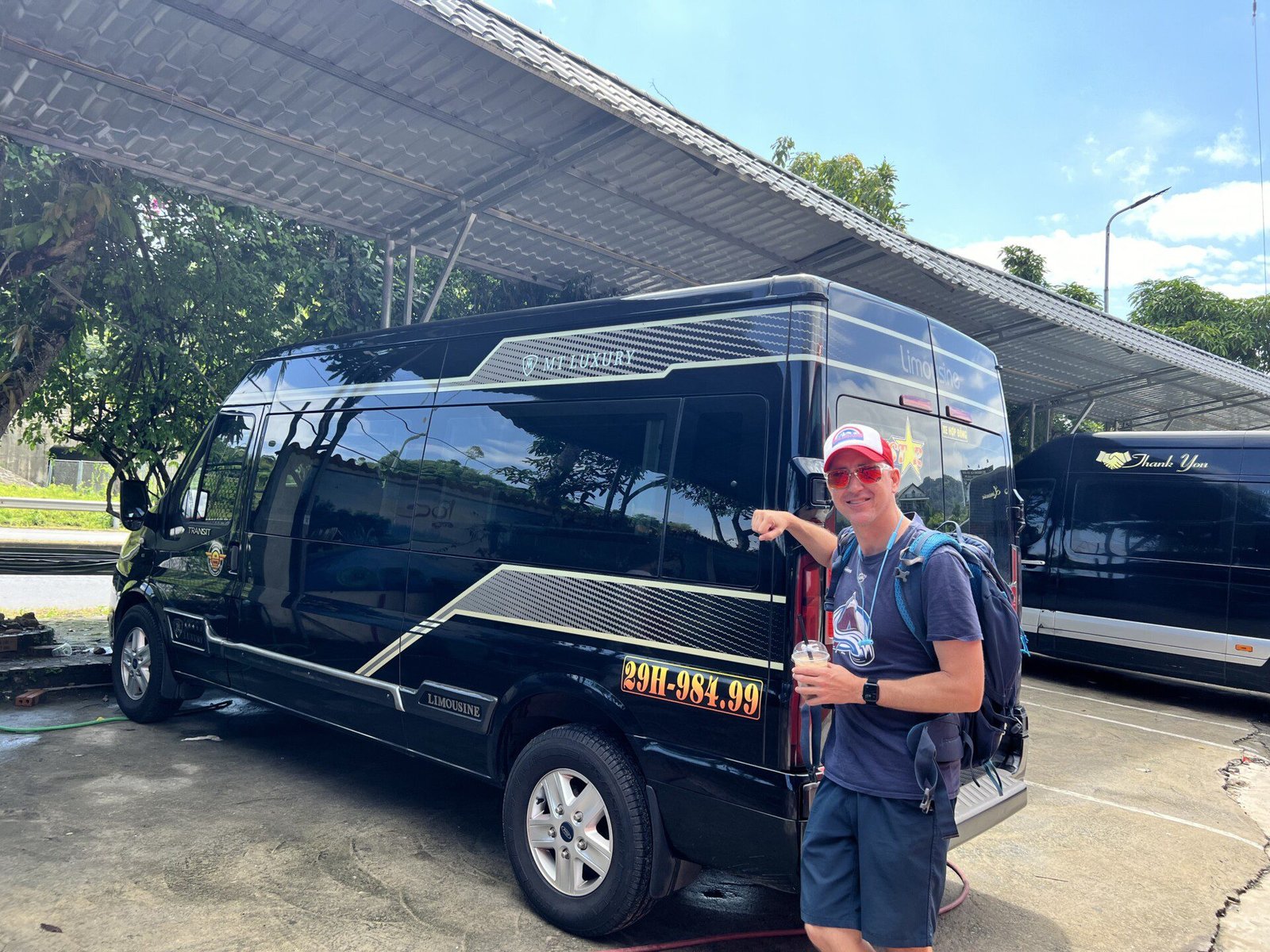
My wife and I also don’t drink anymore, so nightlife isn’t really part of our trips. Instead, we’re usually looking for quiet cafés, scenic routes, and time to slow down.
That mindset is what led us to skip the organized tours in Sapa. After our packed Ha Long Bay cruise, where tourists were shoulder to shoulder inside a cave, I came down with something that felt like the flu — possibly of the variety that ends in “19.”
So, we decided to avoid group settings for a few days and just do our own thing.
In the end, going self-guided turned out to be the best choice. We had full control over where we went, how fast we moved, and when we stopped. We adjusted our days around the weather, lingered longer when we found a good view, and still managed to see everything we came for.
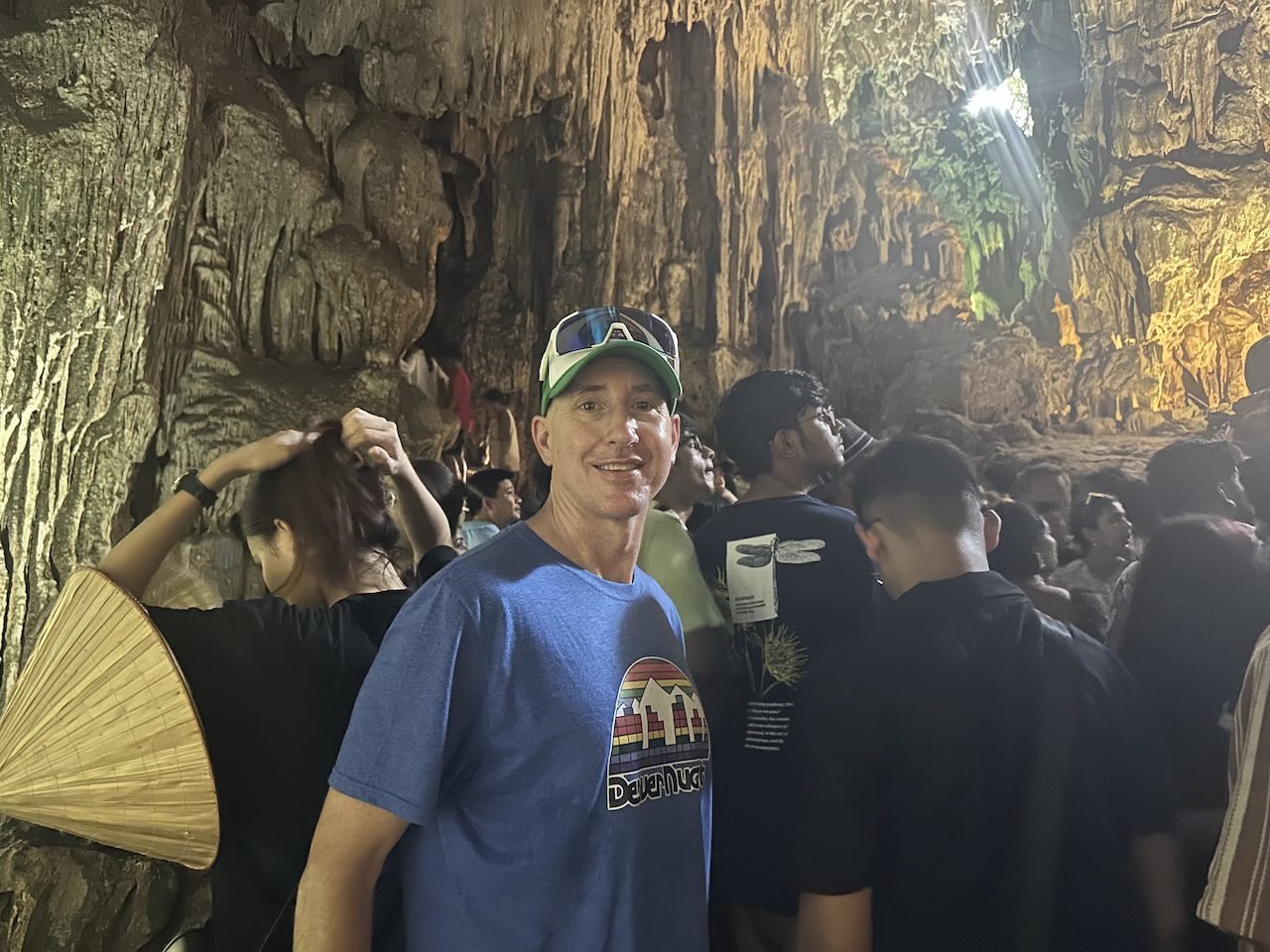
🏔️ Sapa, Vietnam Travel Guide: What to Know Before You Go
Here’s a quick overview of Sapa’s geography, town layout, main landmarks, and what to expect when exploring on your own.
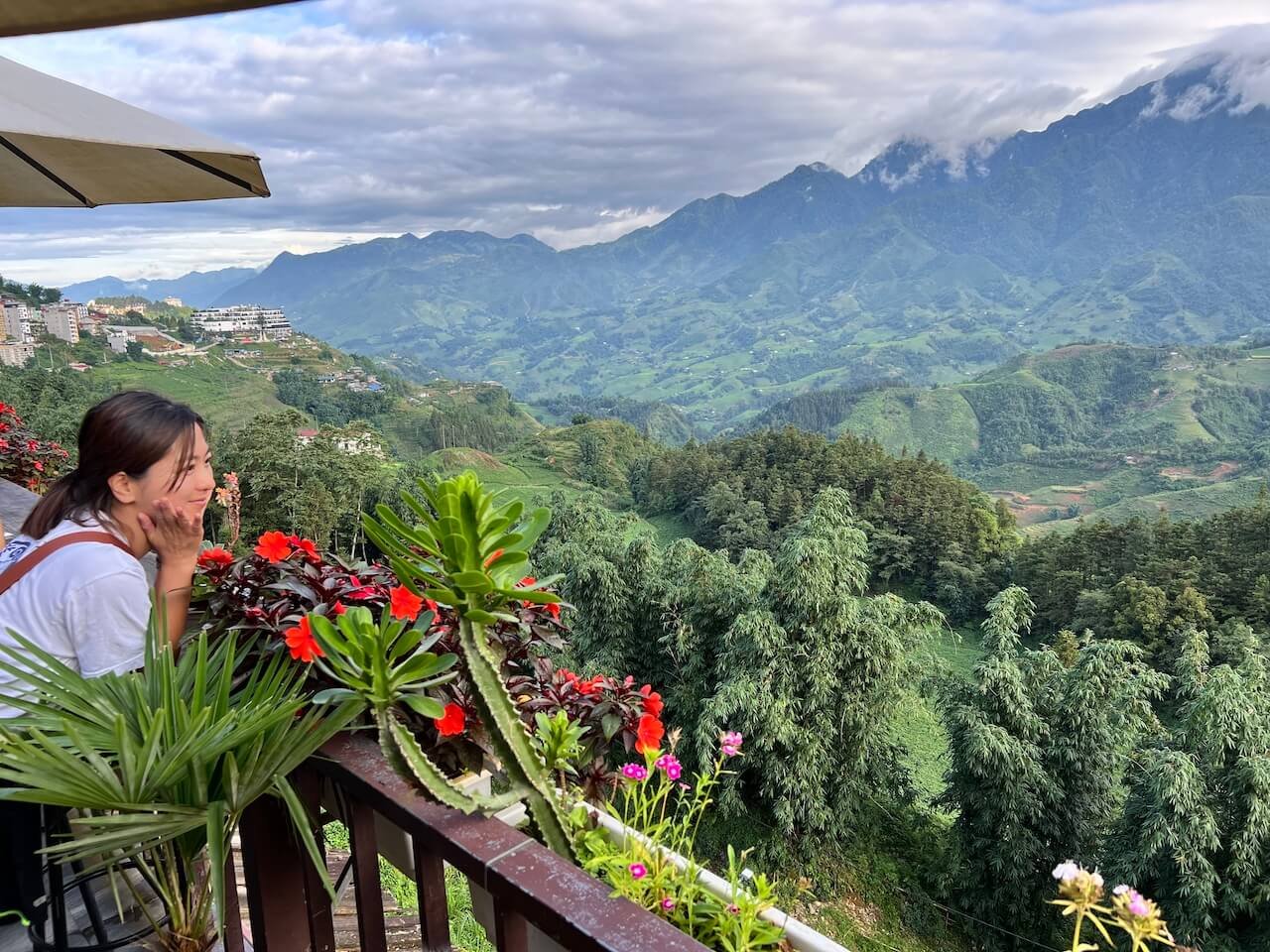
Where Is Sapa, Vietnam? (And Why It’s Worth Visiting)
Sapa, located in the Hoàng Liên Son mountains of northern Vietnam, about 315 kilometers northwest of Hanoi, is famous for its breathtaking rice terraces, vibrant hill-tribe cultures, and cool mountain climate.
Dominating the region is Fansipan Peak, often called the “Roof of Indochina.” It’s a must-see for adventurers and casual sightseers alike.
While trekking is the main draw for most visitors, Sapa also caters to those who prefer a slower pace. Whether you’re wandering through bustling local markets, savoring the region’s unique culinary offerings, or riding the iconic Fansipan cable car, there’s no shortage of ways to soak in the area’s charm.
👟 How to Get Around Sapa Town on Foot (Or Not)
Sapa Town is easily explored on foot, with its main entrance marked by a decorative archway across from Sun Plaza and Sapa Station. This gateway leads downhill into the heart of the town, where narrow streets are lined with shops, restaurants, and bars. The iconic Sun Plaza clocktower and Town Square sit atop the hill, making them a great starting point for your adventure.
If your hotel is centrally located, you’ll be within walking distance of Sapa’s lively streets, lined with shops, restaurants, and bars. However, some of the most scenic accommodations are farther out, requiring transportation to reach the town center.
We stayed at Pao’s Sapa Leisure Hotel, which sits on the lower end of the hill—just outside the chaotic town center but still within walking distance. Its location also made it a convenient starting point for our self-guided Sapa trek.
I’ll dive deeper into additional hotel options later in the post.
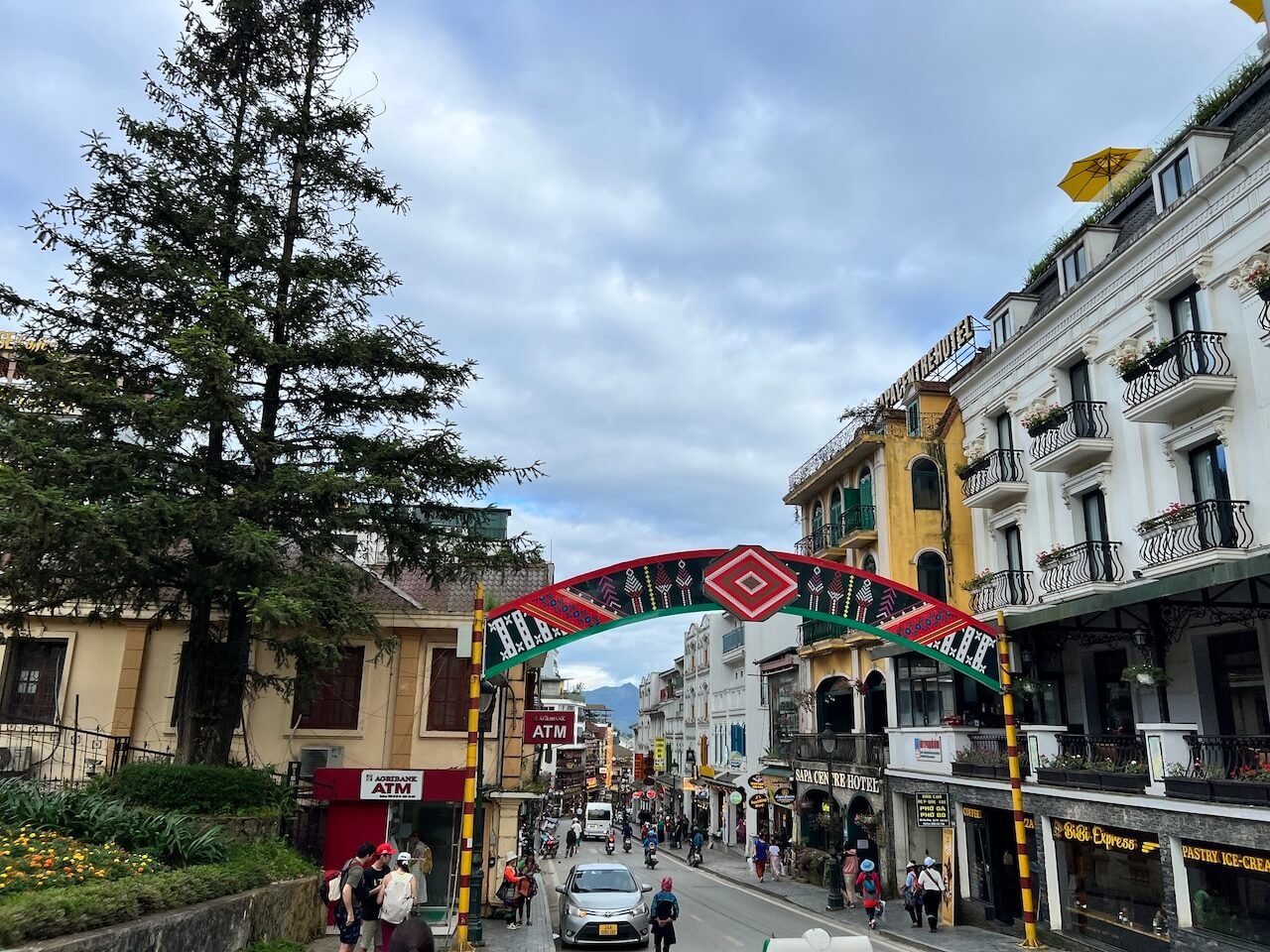
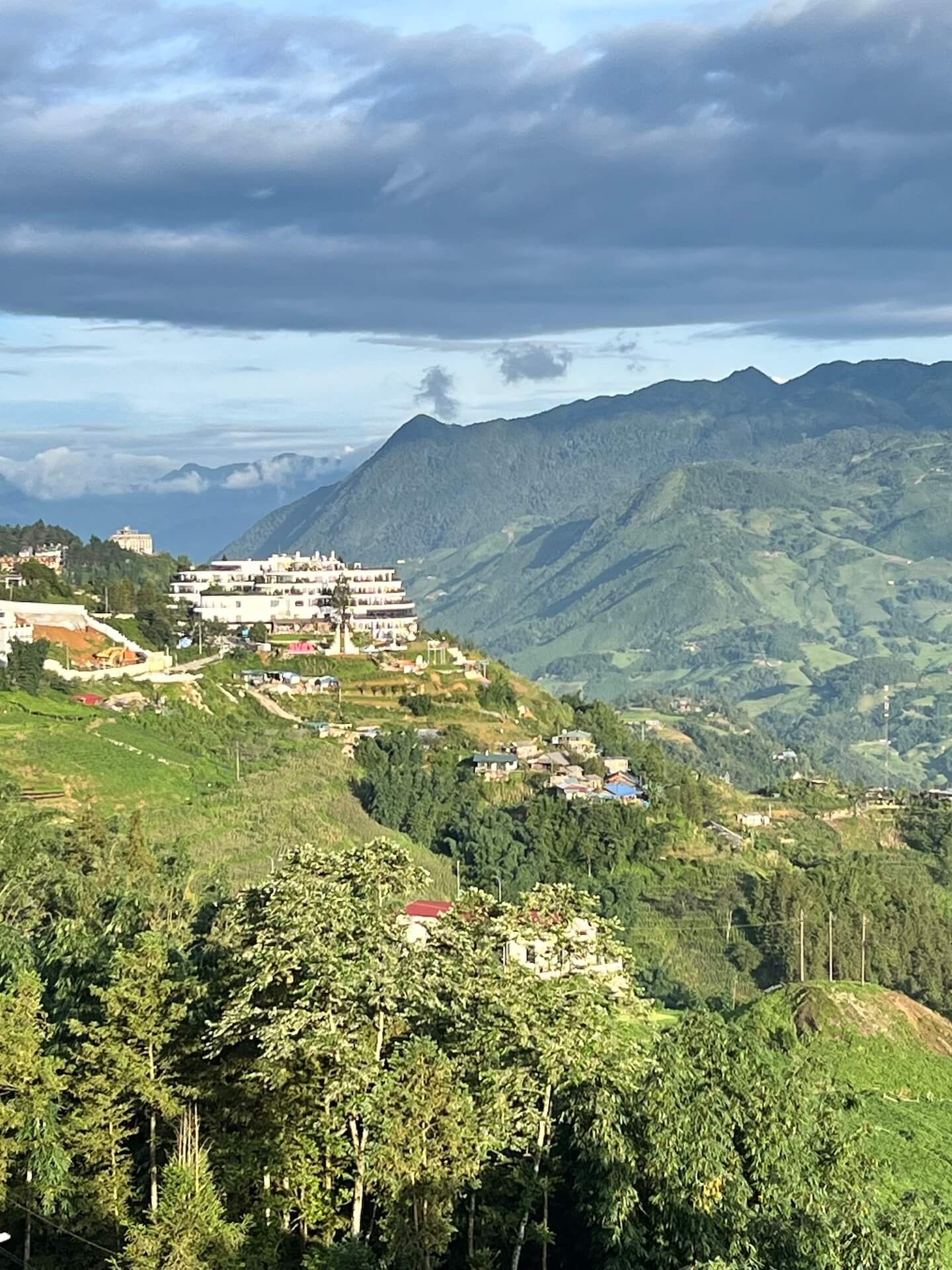
ATMs in Sapa: Where to Find One (Without Stress)
If you need cash, there’s a safe and convenient ATM right across from Sun Plaza (pictured top left). While Sapa generally feels safe, having this ATM in an open, visible location was a relief after some late-night misadventures searching for cash in Hanoi’s Old Quarter.
Sun Plaza, Sapa Station & Town Square: Central Landmarks
The centerpiece of Sapa Town is the iconic Sun Plaza building. With its intricate clock tower and bold yellow facade, it’s impossible to miss. Sun Plaza also houses Sapa Station, where visitors can catch a train to the Fansipan cable car station—a gateway to the mountain’s peak.
Sun Plaza is impossible to miss—it towers above Sapa’s steep streets, which make San Francisco seem tame by comparison. The building’s design evokes a Hill Valley clock tower vibe, reminiscent of Back to the Future.
Across the street, Sapa’s bustling Town Square serves as a meeting point for tourists. From here, you can head downhill to explore the vibrant downtown, brimming with shops, restaurants, and trekking services.
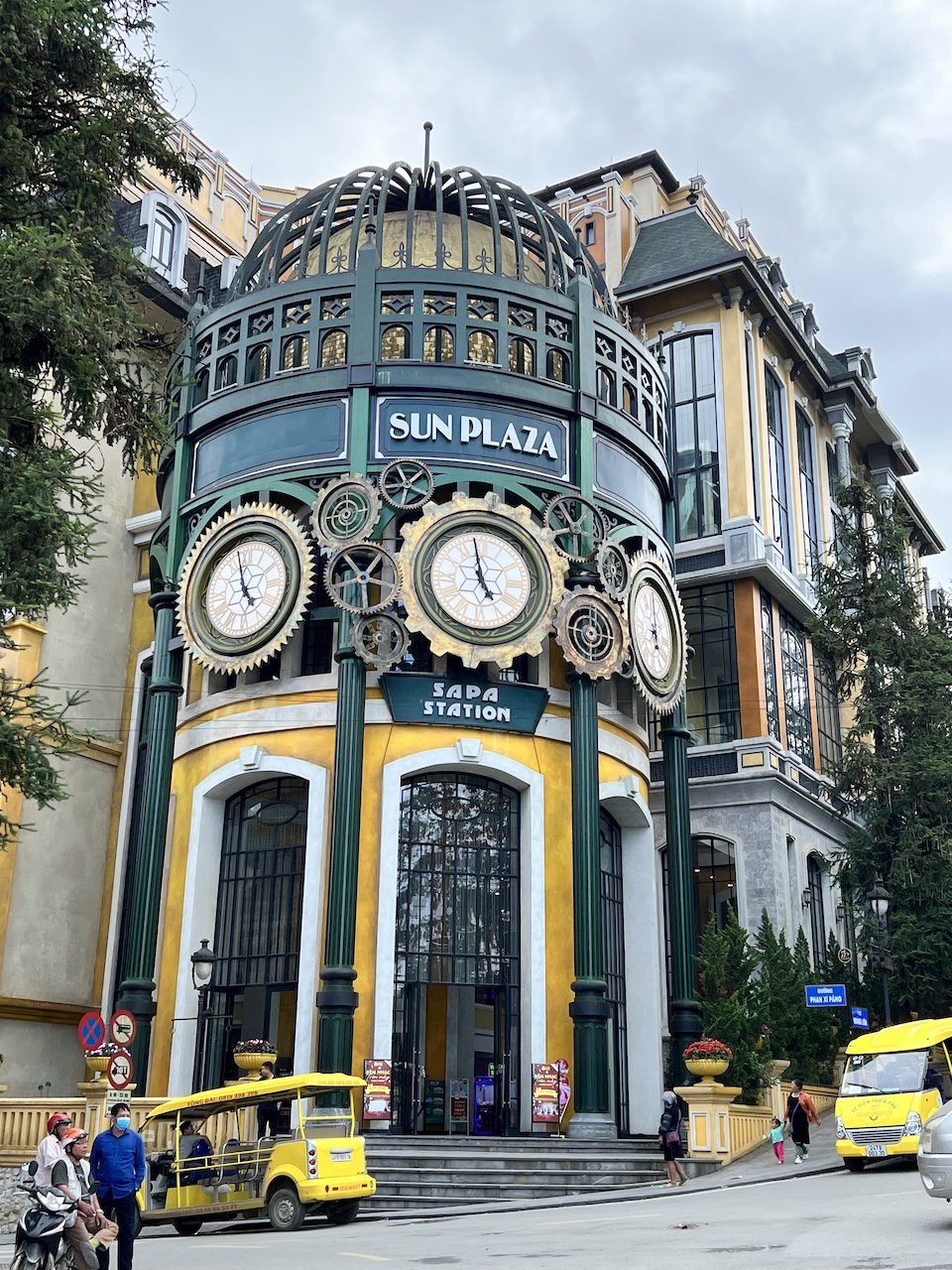
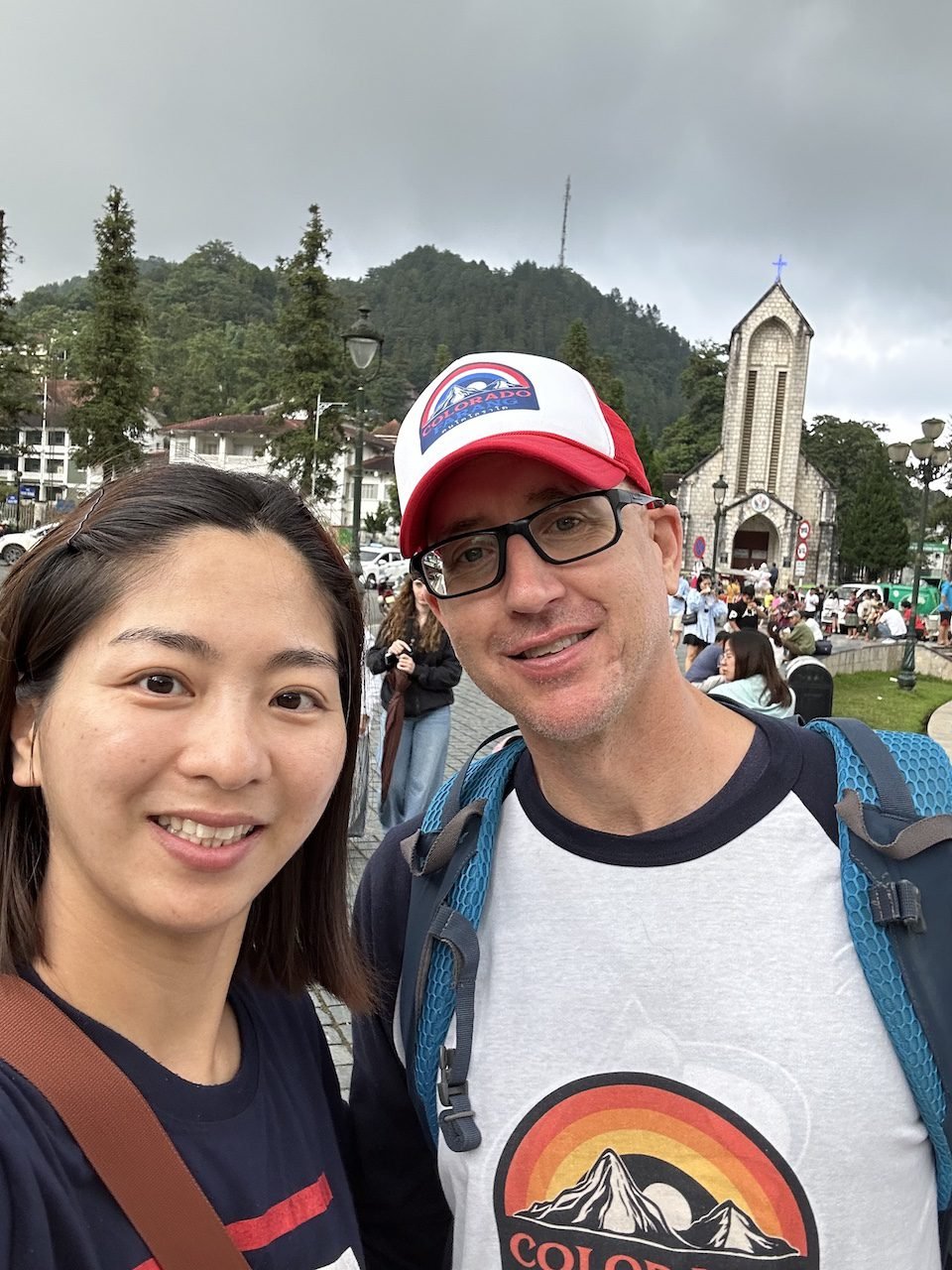
What to Expect in Sapa Town: Shops, Cafés & Night Markets
Like many trekking hubs worldwide, Sapa Town serves as the heart of the action. It’s packed with accommodations, restaurants, trekking guides, and shops selling outdoor gear—often knock-off brands, but useful if you need last-minute supplies.
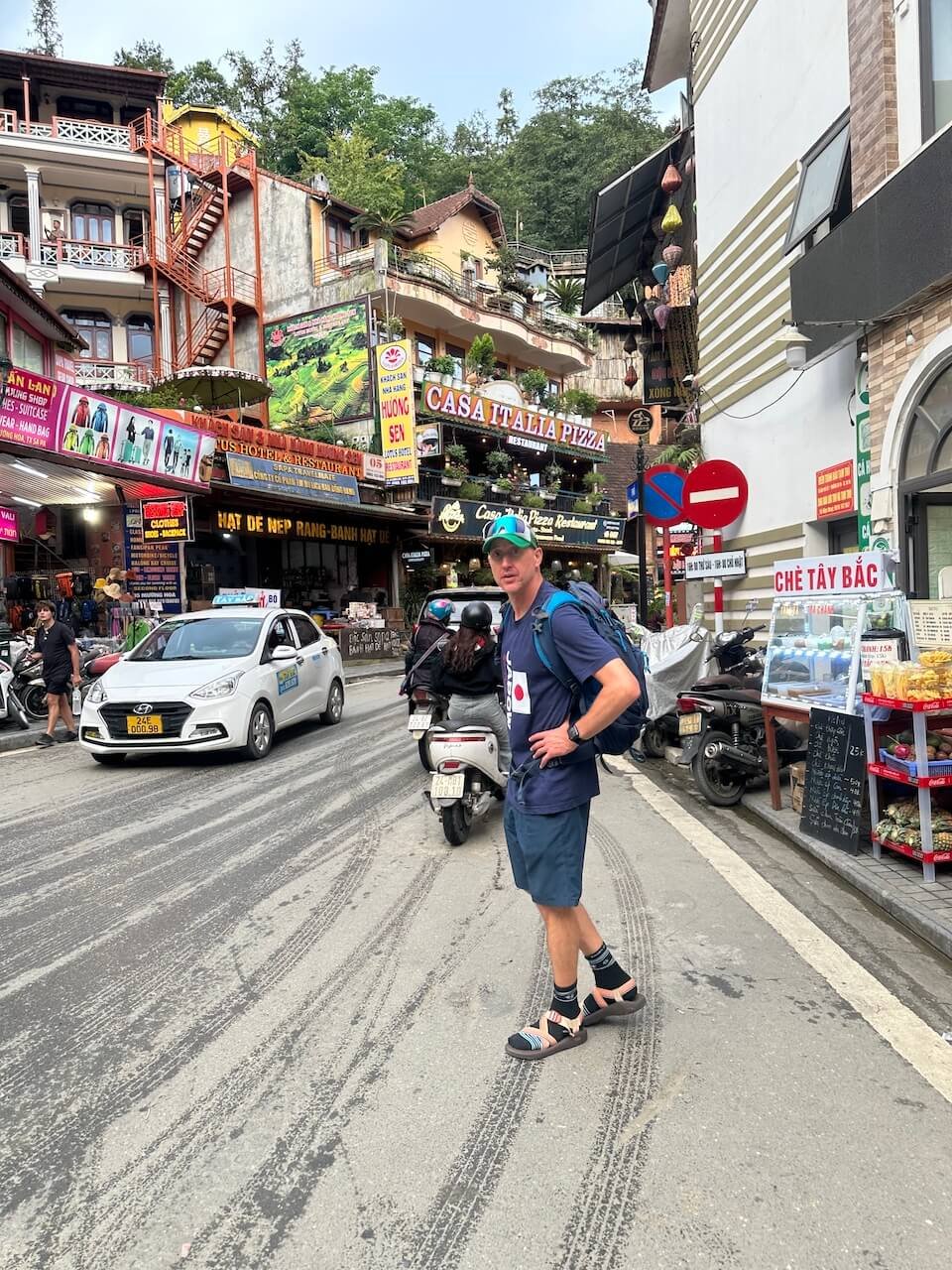
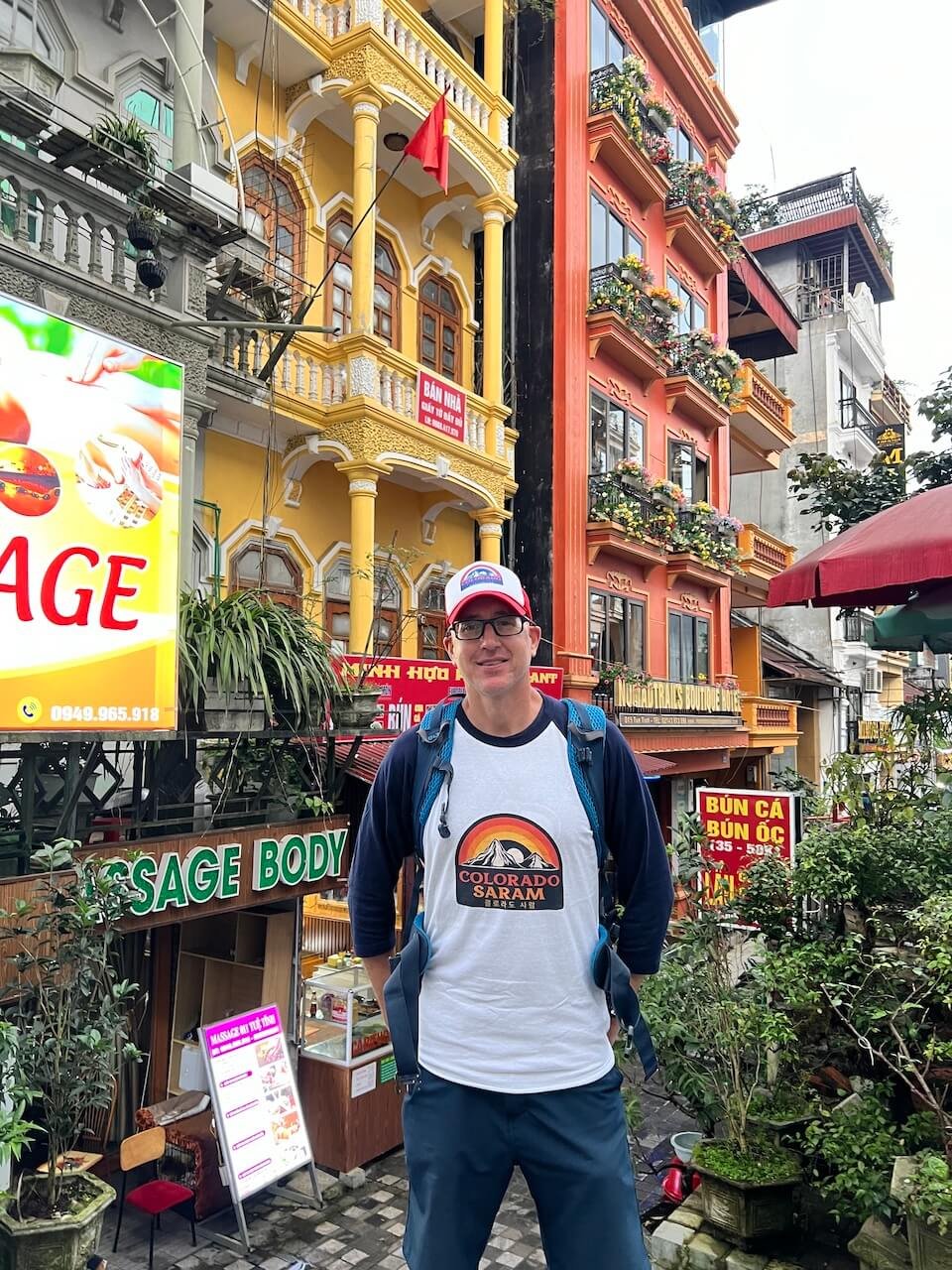
The main streets are lively, lined with a mix of Vietnamese and international restaurants, cozy cafés, and bars catering to both locals and tourists. You’ll find everything from traditional hotpot spots to Western-style bakeries and rooftop lounges with stunning mountain views. The town also has a handful of convenience stores, small supermarkets, and pharmacies, which can be helpful for grabbing essentials before heading into the mountains.
Evening brings a different energy, with bustling night markets offering handmade textiles, souvenirs, and local street food. Some bars and lounges feature live music, making it easy to unwind after a long day of trekking. While Sapa isn’t a wild party town, there’s definitely a social scene, especially around the central square and along the main roads leading to Sun Plaza.

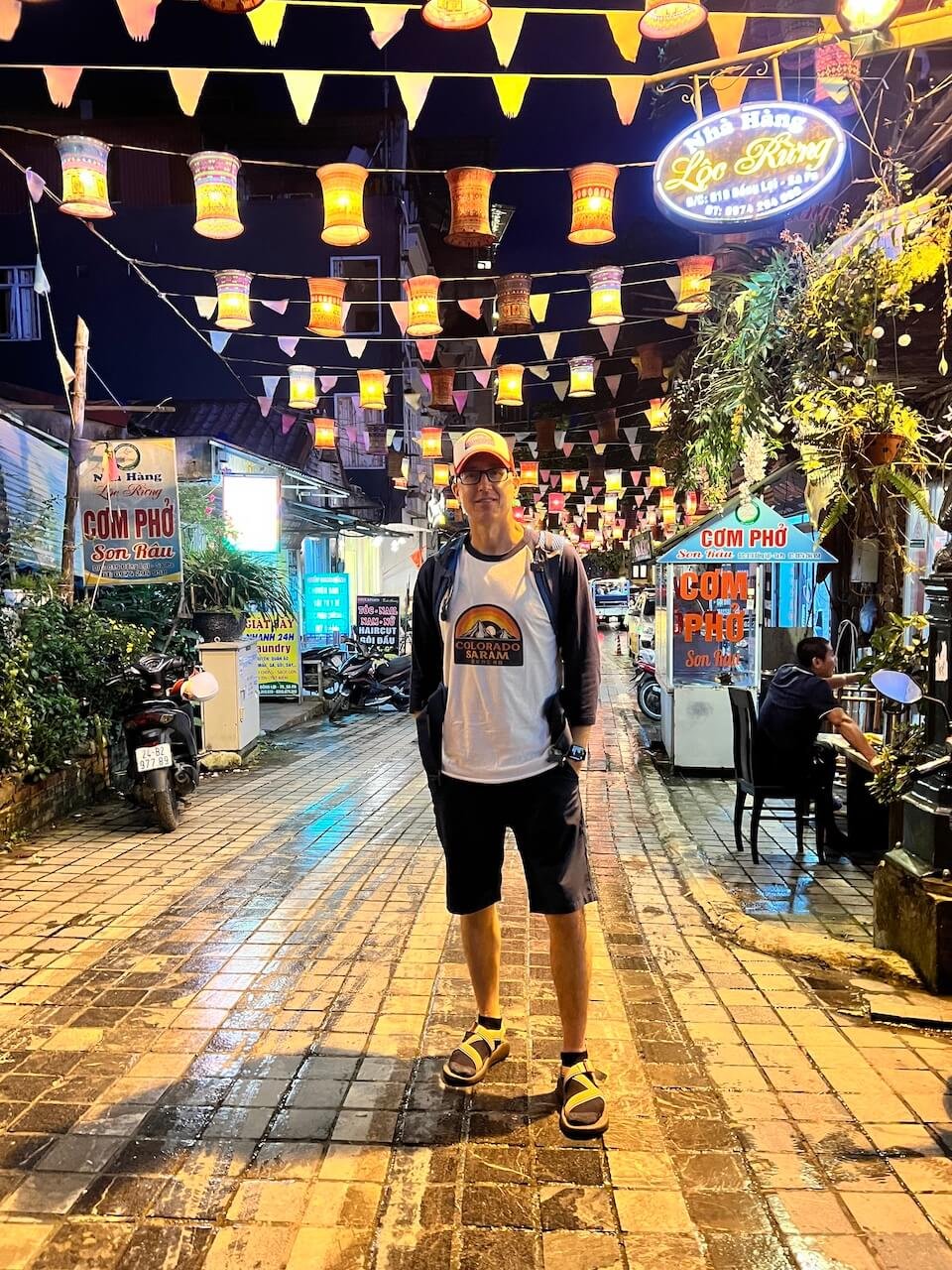
Sapa’s night markets light up with colorful lanterns, busy street food stalls, and a lively atmosphere. Whether you’re shopping, grabbing a bite, or just taking it all in, there’s a cool vibe to the town at night. And for the record—despite what these pictures may suggest, I’m not actually a giant compared to my wife!
🚕 How to Get Around Sapa: Transportation Tips for Travelers
Sapa’s charm lies partly in its remote location, nestled high in Vietnam’s northern mountains. Reaching this “town in the clouds” involves a winding journey—whether by bus, van, or train—up steep mountain roads.
Sapa Town itself is perched on a hillside, with steep terrain that makes navigating its narrow streets a chaotic experience for vehicles. Traffic frequently grinds to a standstill, and walking can be just as challenging as driving.
For most visitors who aren’t driving (likely the majority reading this), navigating Sapa shouldn’t be too much of a concern. However, walking the streets requires patience and a willingness to yield to oncoming traffic, which often nudges pedestrians aside or into nearby alleys.
🛵 Motorcycle Taxis: Fast, Cheap & Fun
Motorcycle taxis are my top recommendation for getting around Sapa. They’re affordable, efficient, and, honestly, a lot of fun. While they may seem intimidating at first, the drivers are skilled, and the rides offer a thrilling way to explore the area.
Once you dip your toe into the world of “easy riding,” you won’t want to go back to regular taxis!
Golf Cart Taxis: A Slower, Scenic Alternative
If motorcycles aren’t your thing, Sapa has plenty of golf cart-style taxis buzzing around town. Many hotels also provide shuttle or golf cart services—ask about fees and schedules when checking in, as some may be complimentary.
🚙 Using Grab in Sapa: What to Know
If you’ve traveled in Southeast Asia before, you’re probably familiar with Grab. If not, it’s worth downloading the app before your trip—it’s the region’s go-to ride-hailing service and a much safer, more convenient alternative to relying on local taxis.
With Grab, fares are set in advance, so there’s no need to haggle or worry about being overcharged or taken on an unnecessarily long route.
Often called the Uber of Southeast Asia, Grab offers more than just taxis. Through the app, you can book cars, motorcycle taxis, and larger vehicles for groups. It also provides food delivery, which you probably won’t need in Sapa, but is good to know about for the rest of your travels.
If you’re traveling to Vietnam, Thailand, or other nearby destinations, getting familiar with Grab is a must.
In Sapa, we only used Grab once—at the end of our solo trek—when we needed a ride back to our hotel. Our driver, who claimed to be the only female Grab driver in Sapa, expertly navigated the rainy, mountain roads to get us back quickly after a long day.
A little too quickly, if you ask me.
Tip: Make sure you have an eSIM or another way to stay connected, as you’ll need mobile data to book a ride through the app.
📶 Staying Connected in Sapa: Best Mobile Data & eSIM Options
If you’re planning to call a Grab taxi, navigate your trekking routes, or explore Fansipan Peak and Cat Cat Village, having a reliable mobile connection is essential. While most hotels, restaurants, and cafés offer WiFi, coverage can be spotty—especially in more remote areas.
Why I Recommend Airalo for Sapa & Beyond
For this trip, I used an Airalo eSIM, which provided seamless, high-speed internet access throughout Sapa. Whether I was calling a Grab from a small village, checking online maps mid-trek, or looking up information at the top of Fansipan Peak (3,143 m / 10,326 ft), my eSIM worked flawlessly.
👉 Check out my full Airalo eSIM guide written after my three-week trip to Vietnam, to learn more and get connected before you go!
👉 Get your Vietnam Airalo eSIM here!
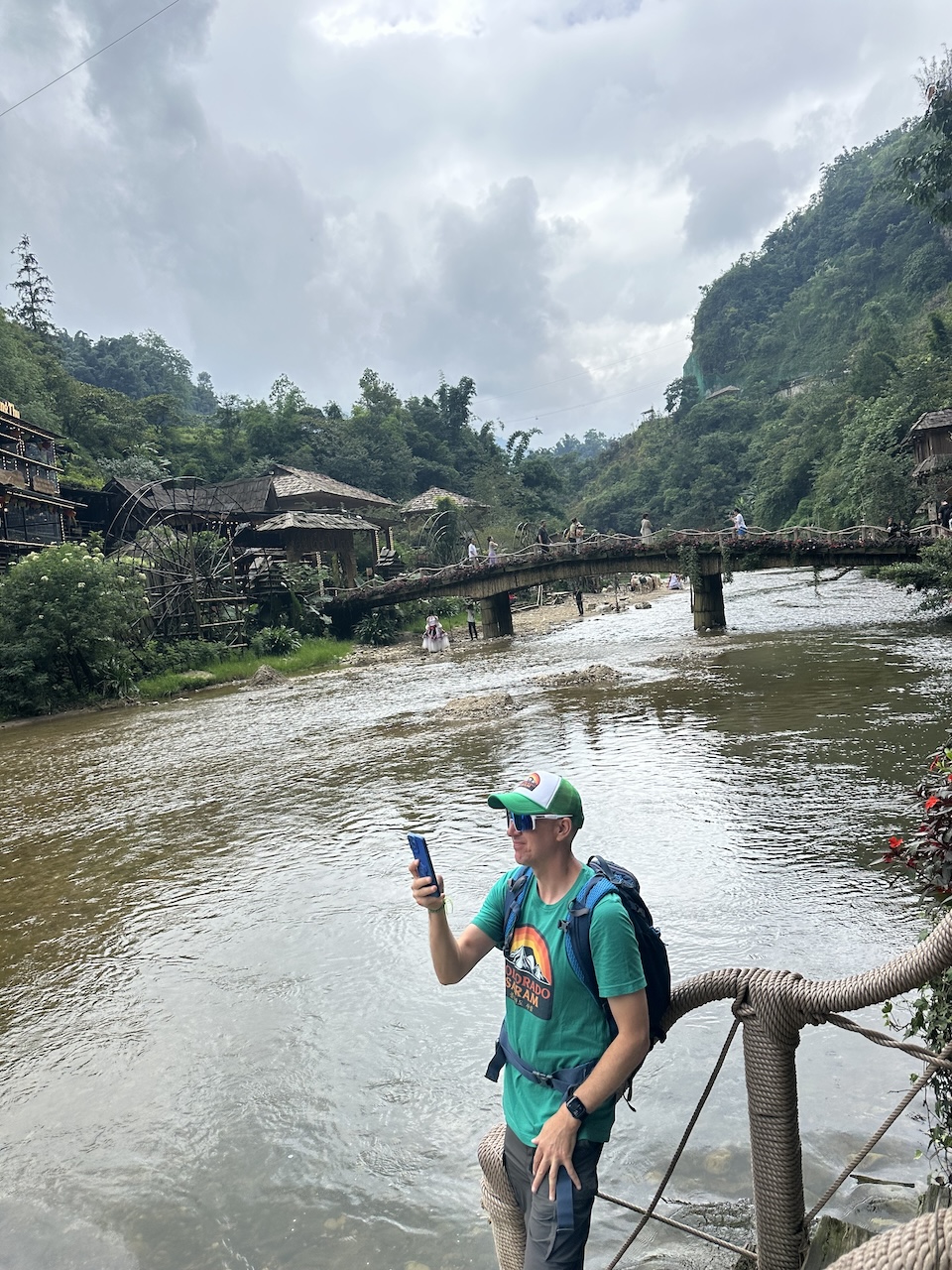
An Airalo eSIM keeps you connected without the hassle of swapping SIM cards or searching for WiFi. If you’re traveling to Sapa or anywhere in Vietnam, I highly recommend setting one up before your trip.
🛣️ How to Get to Sapa: Trains, Buses, & Mini-Vans from Hanoi
Sapa’s remote mountain location is part of its appeal, but getting there takes a bit of planning. There’s no airport nearby, so all roads lead up—literally.
Fortunately, you’ve got options: comfortable mini-vans, budget sleeper buses, and nostalgic overnight trains.
If you’re just here for the transport logistics, I’ve also written a dedicated guide to getting from Hanoi to Sapa, with more detail on pricing, travel time, and booking tips.
Here’s how to choose the one that fits your travel style (and your wallet).
🚐 Shared Mini-Vans – The Best Combo of Comfort & Convenience
Our Top Pick ✅

If you’re wondering how to get to Sapa from Hanoi without the chaos of a budget sleeper bus, I can’t recommend the shared “limousine” mini-vans enough. It’s what we used—and I’d do it again in a heartbeat.
For around $20 USD per person, each way, these rides offer a perfect mix of comfort, reliability, and ease.
- Hotel pick-up in Hanoi + drop-off near Sapa center
- Reclining seats with massage settings (!), chargers, AC
- Friendly English support via messaging apps like Kakao or WhatsApp
- Easy booking through Klook—no haggling or paper tickets
👉 Book your tickets on Klook here
The journey took just over five hours with two rest stops. Our driver didn’t speak English, but everything was smooth thanks to the support rep we dubbed “The Troubleshooter” — who answered all our questions via chat.
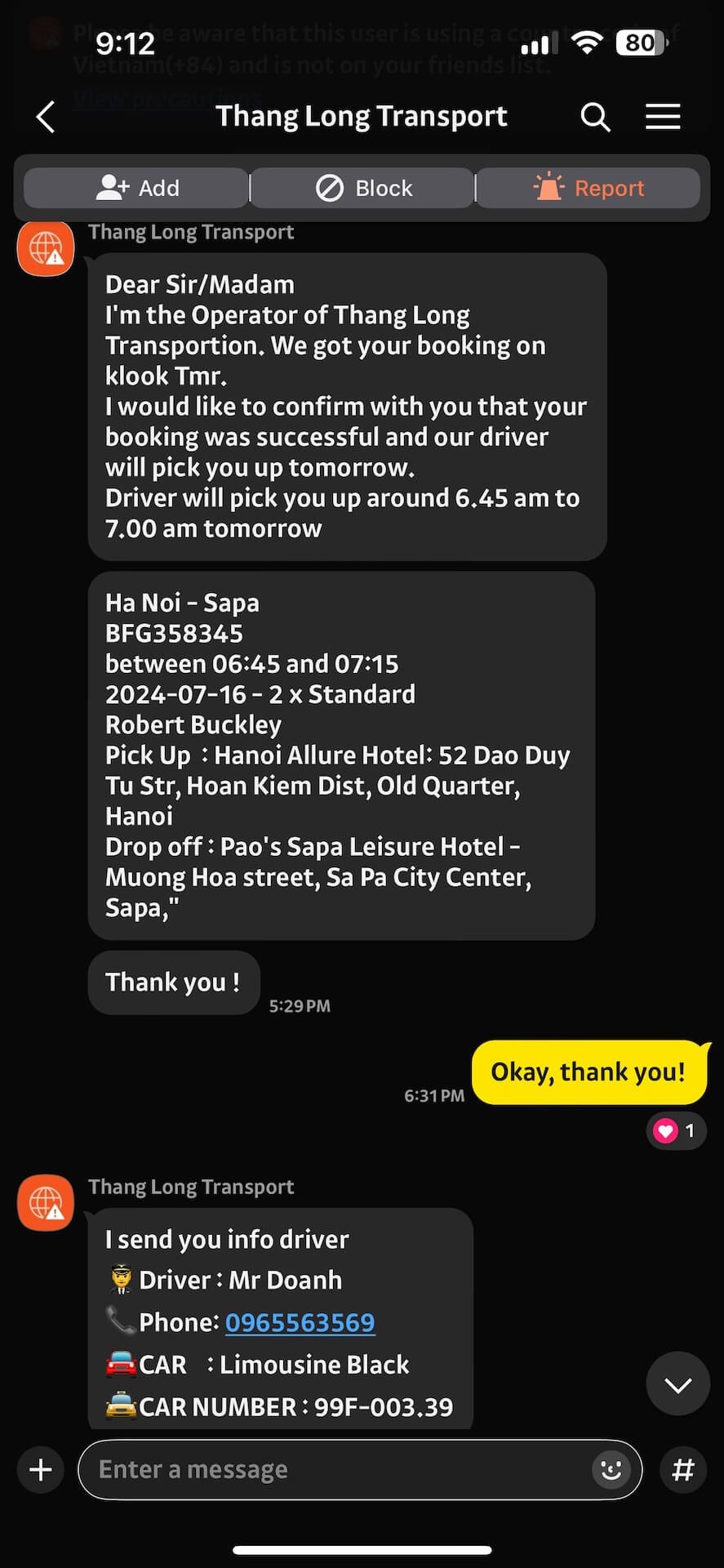
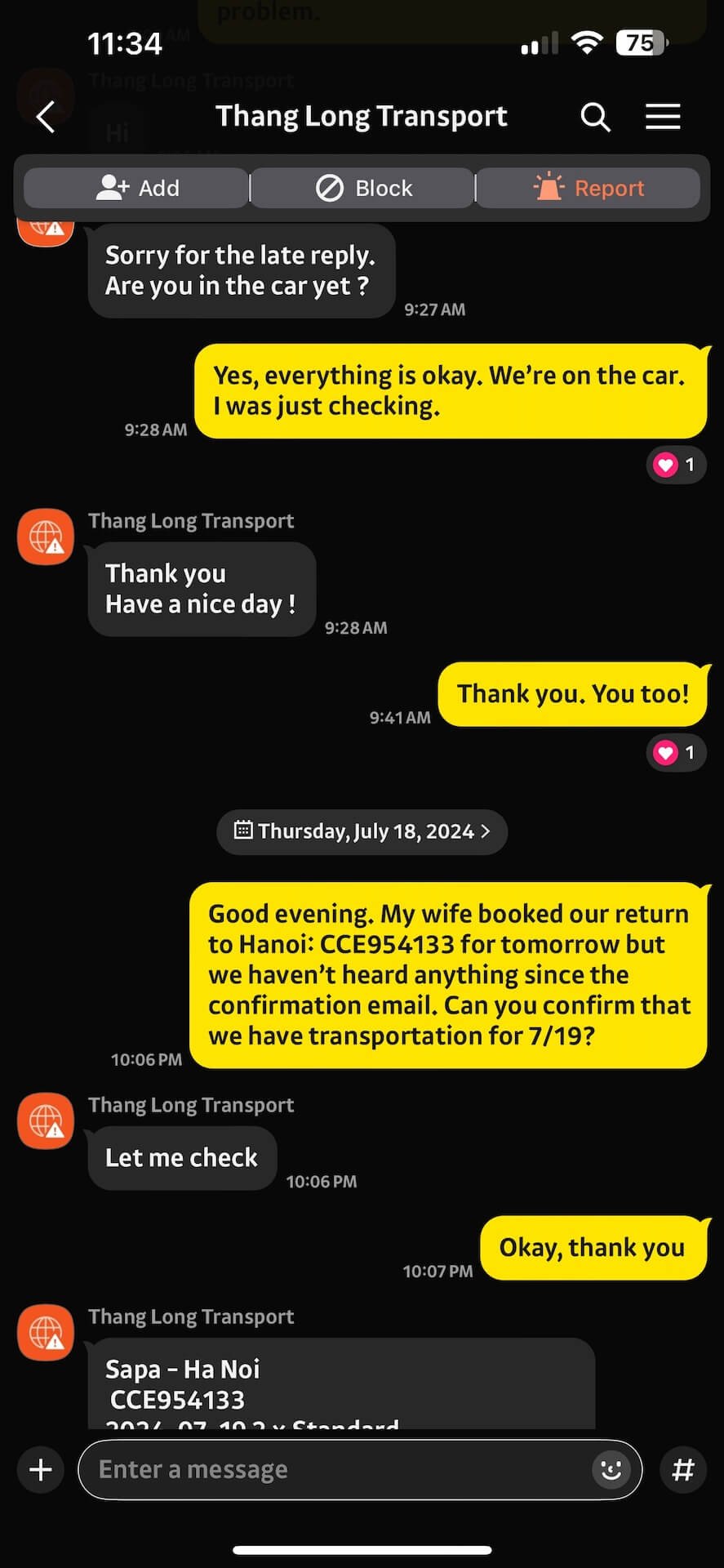
Watch🎥: Our Mini-Van Ride from Hanoi to Sapa
💡 Tip: Avoid the back row if you want a fully reclining seat.
🚌 Sleeper Buses – Budget-Friendly & Backpacker-Approved
If you’re looking to save a few bucks, sleeper buses are your cheapest option. You’ll find tickets starting at $9.99 USD, with multiple daily departures from Hanoi.
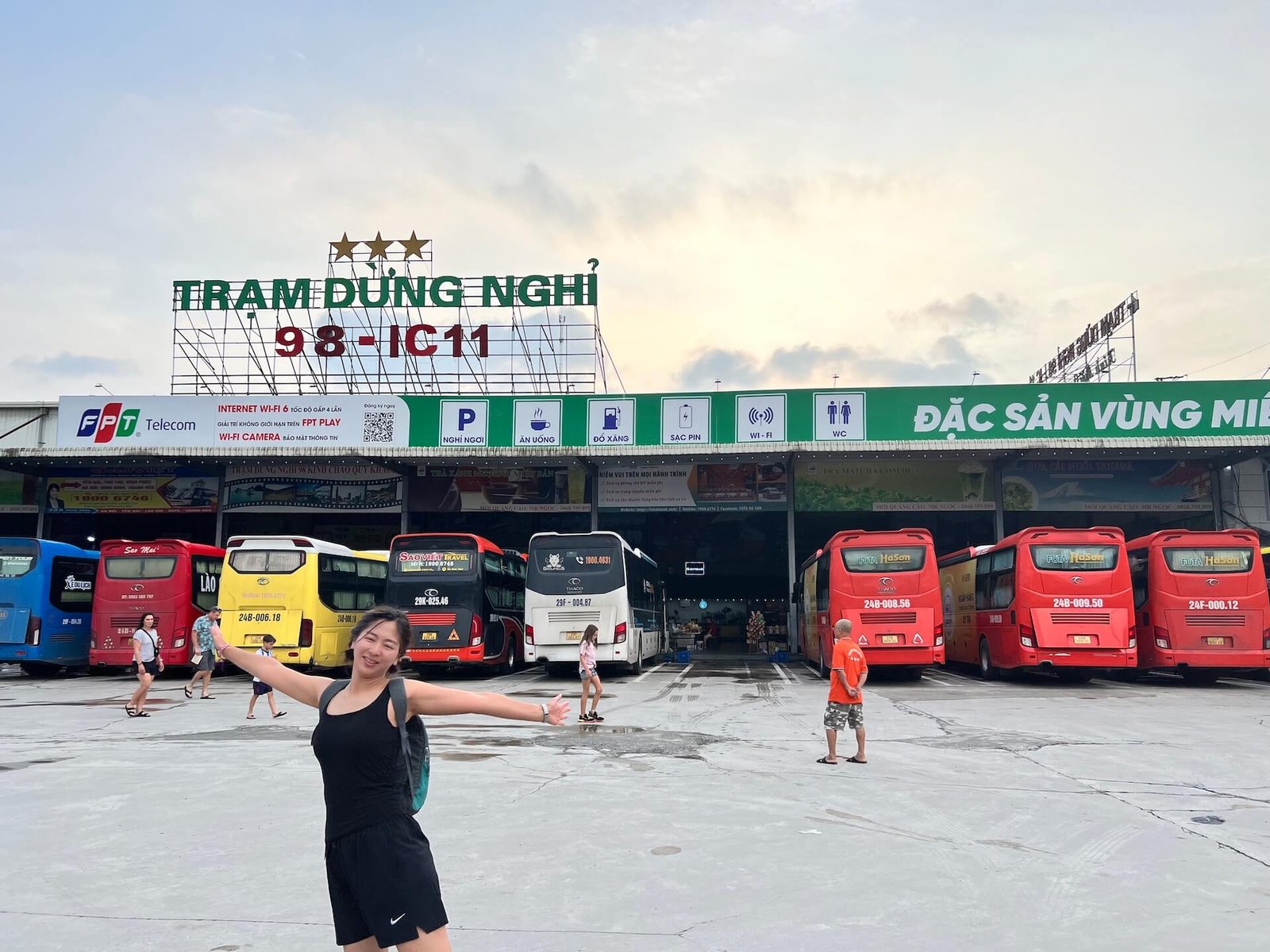
These buses offer: • Reclining beds or capsule-style pods
- AC, charging ports, WiFi, and blankets
- 6–7 hour journey, usually overnight
- Convenient drop-offs near central Sapa
👉 Book your tickets on Klook here
Just be warned: mountain roads = bumpy rides. If you’re prone to motion sickness, come prepared with meds or ginger candies.
There are two styles:
- Standard sleeper – bunk bed setup
- Cabin buses – private sleeping pods (more comfort, slightly higher price)
While you won’t find luxury, it’s a solid choice for budget travelers who want to maximize their funds.
🚂 Overnight Train to Lao Cai – Slow Travel with a Side of Nostalgia
Want a more romantic (if less convenient) journey? Try the overnight train from Hanoi to Lao Cai.
You’ll board in Hanoi, spend the night in a sleeper cabin, and arrive at Lao Cai Station in the morning. From there, it’s a 45-minute taxi or shuttle to reach Sapa.
- 7–8 hour ride
- Sleeper cabins with beds and privacy
- Great for slow travel lovers or train fans
👉 Book your Sapaly Express train to Sapa here
⚠️ Heads up: trains run at night, so you won’t see much scenery.
While I didn’t take this train on this trip, I’ve done similar journeys elsewhere in Southeast Asia—and it was a memorable experience. If you’re not in a rush and love the idea of train travel, this could be your ticket.
Which Option Should You Choose?
Quick Comparison Guide:
| Method | Time | Cost (USD) | Best For |
|---|---|---|---|
| Mini-Van 🚐 | 5 hrs | ~$20 | Comfort + convenience |
| Sleeper Bus 🚌 | 6–7 hrs | ~$10 | Backpackers, tight budgets |
| Train 🚆 | 8+ hrs | ~$25–35 | Slow travel, nostalgia fans |
Thinking about a trip to Sapa?
First, you have to get to Hanoi. Start your journey here — search flights to Hanoi from your closest airport using this quick tool:
🌦️ When to Visit Sapa: Seasonal Guide & Rainy Season Tips
Before we dive into our trekking routes and cable car views, let’s talk about Sapa’s weather — because you might notice we look a bit (or very) wet in some of the photos.
We visited during Vietnam’s rainy season in mid-July, and while it brought a few downpours, it didn’t stop us from loving the experience. If you’re okay getting muddy, you’ll still have a great time — but timing your visit does make a big difference.
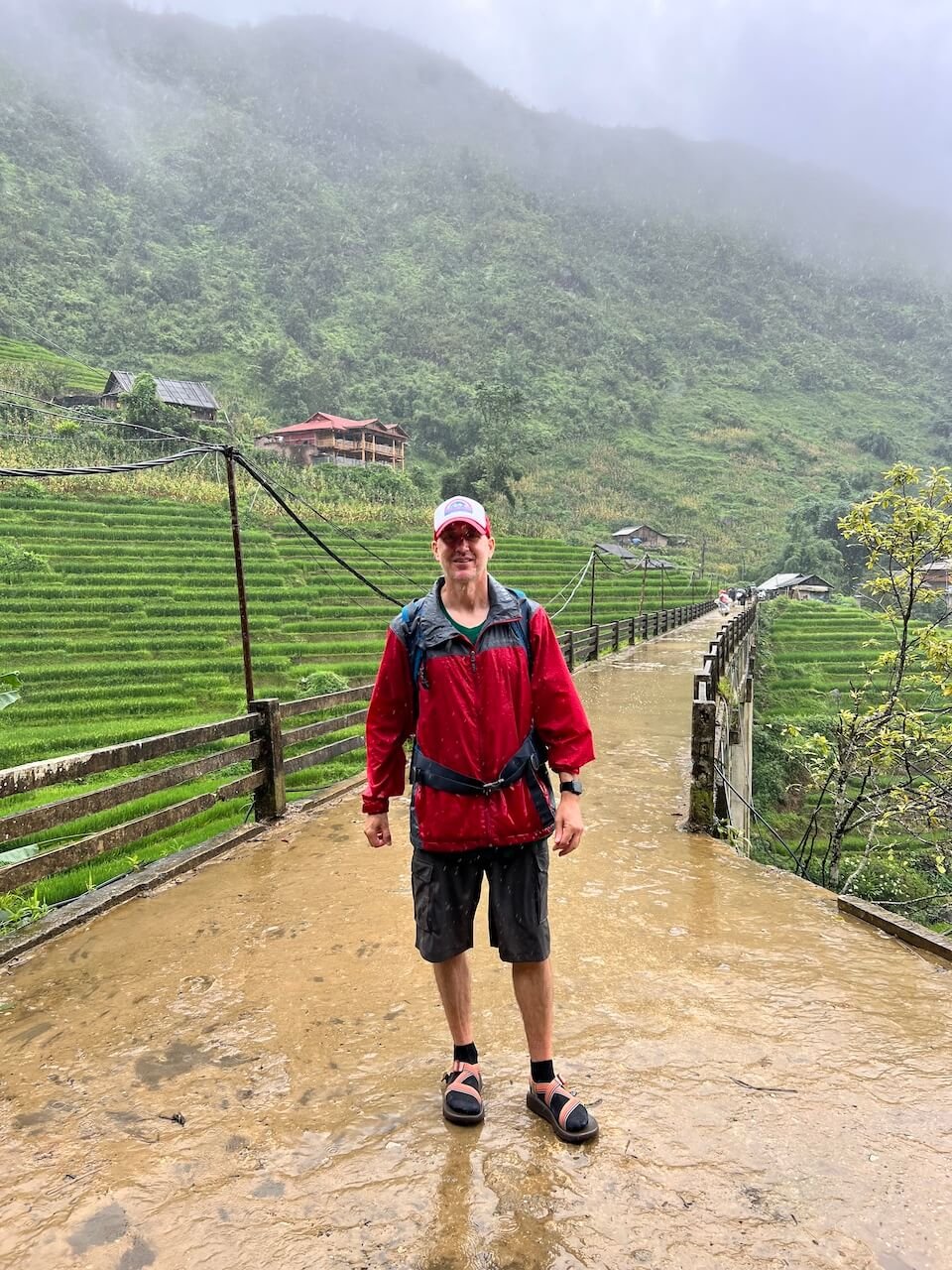
After living in Asia for over 15 years, Sapa had remained an unchecked box on my mental bucket list. So, despite my wife’s better judgment, I decided to press ahead with our plans to visit in mid-July—Vietnam’s peak rainy season.
It’s rare for me to take an “L” when it comes to travel planning, but looking back, she might have been right. She had been pushing for Bali (which, ironically, we visited during its rainy season a few years ago).
In retrospect, our Bali trip made me confident that a few daily showers wouldn’t ruin Sapa. Let’s just say we were both kind of right.
We got wet, but we still had fun!
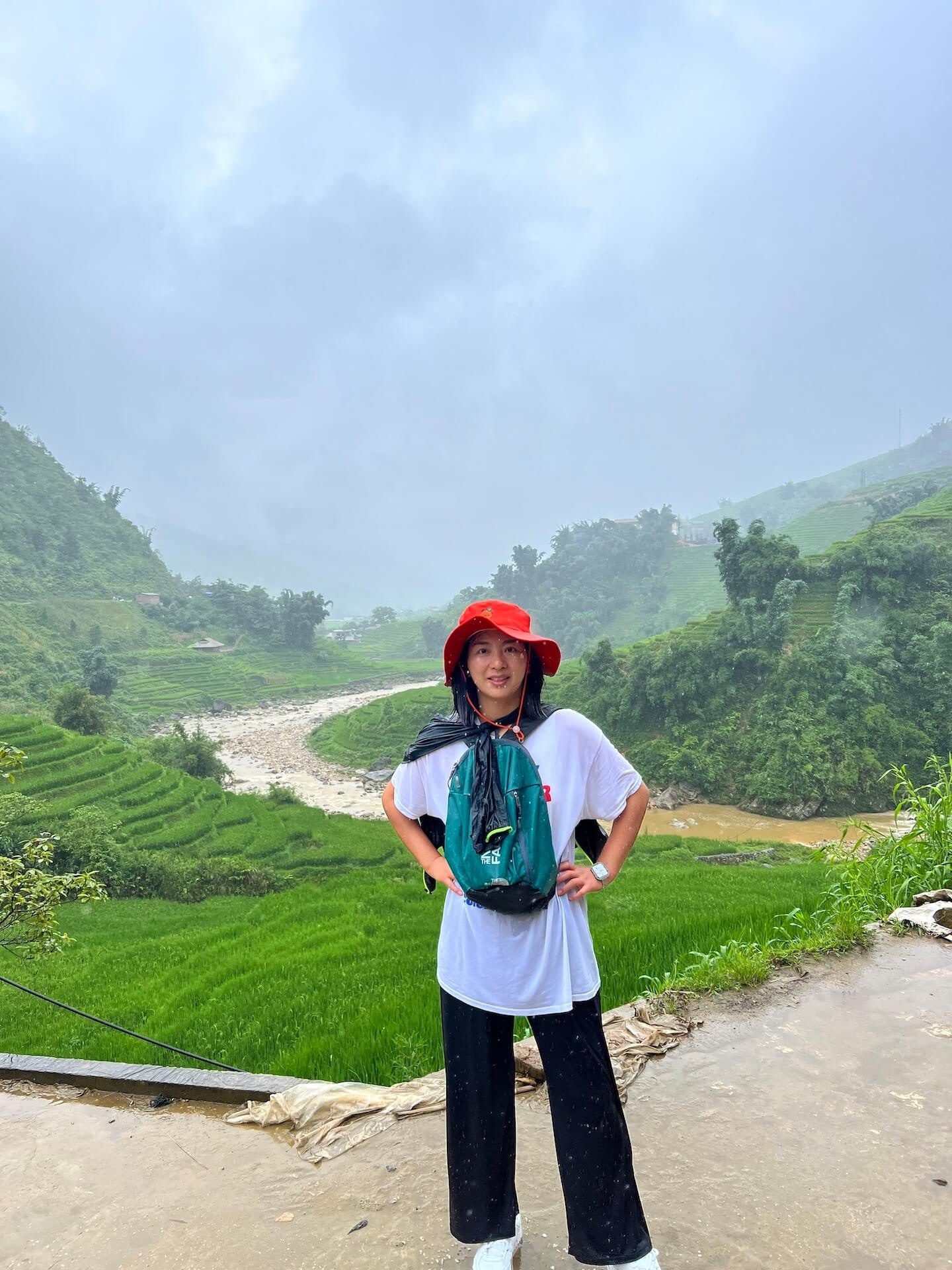
Sapa Weather by Season: What to Expect
Sapa has four distinct seasons, and each brings a totally different vibe. Here’s a quick breakdown to help you choose the best time for your travel style:
Spring (March to May)
Dry, mild, and bursting with color. Temps range from 15°C to 25°C (59°F to 77°F), making it perfect for trekking. Expect clear skies, blooming flowers, and farmers prepping the terraces.
Summer (June to August)
Welcome to the rainy season. Expect dramatic mist, vivid green rice terraces, and heavy (but often short-lived) downpours. Trekking can get muddy, and landslides may impact some areas — but the photos? Unreal.
Autumn (September to November)
Peak season. Cool, dry, and golden. This is when the rice fields glow with color and trail conditions are ideal. Temps range from 10°C to 20°C (50°F to 68°F). It’s the sweet spot for most visitors.
Winter (December to February)
Cold and crisp — sometimes even snowy. Nights can dip below freezing. Great for sipping hot coffee and exploring town, but trekking may be limited due to icy trails or closures.
🌧️ Is Sapa Worth Visiting in the Rainy Season?
In short: yes — if you’re prepared.
If your travel schedule is flexible, shoot for spring or autumn. But if the rainy season is the only time you can go (like it was for us), don’t write it off.
You’ll get wet. You’ll get muddy. But you’ll also get:
- Fewer crowds
- Cheaper hotel rates
- Empty trails and epic valley views
- A moody, mystical version of Sapa that feels like something out of a Studio Ghibli movie
We stayed in a luxury hotel for less, trekked right out the front door, and rode the Fansipan cable car with zero wait time and a cable car to ourselves — perks you probably won’t get in October.
Our Experience: Soaked, Smiling & Still Trekking
Despite the rain, we had a blast. The clouds weaved through the peaks, the rice terraces were electric green, and the energy in town was still lively — not deserted.
Was it muddy? Yes.
Did we hike through puddles and switch to sandals halfway through? Also yes.
Did we regret it? Not for a second.
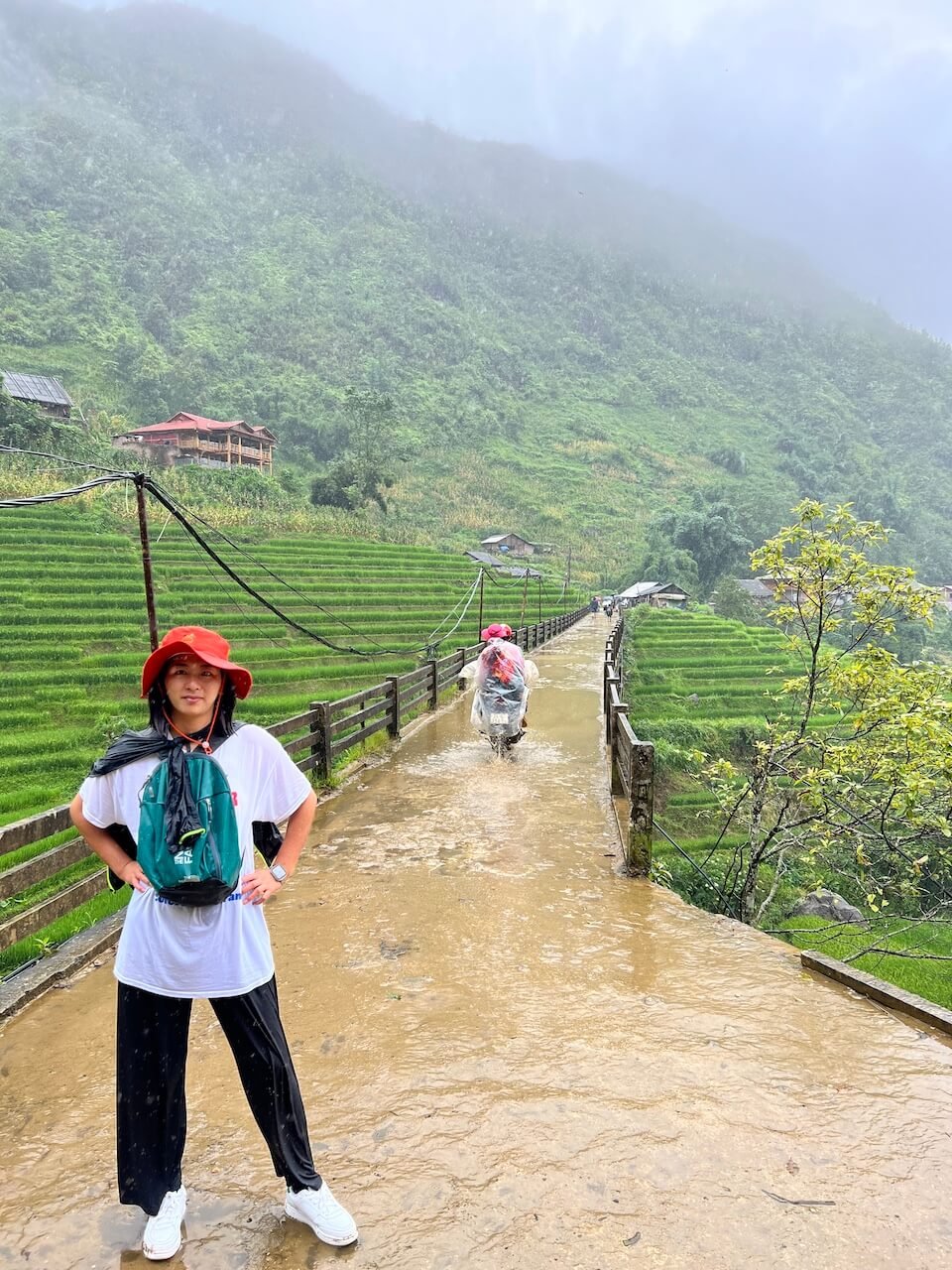
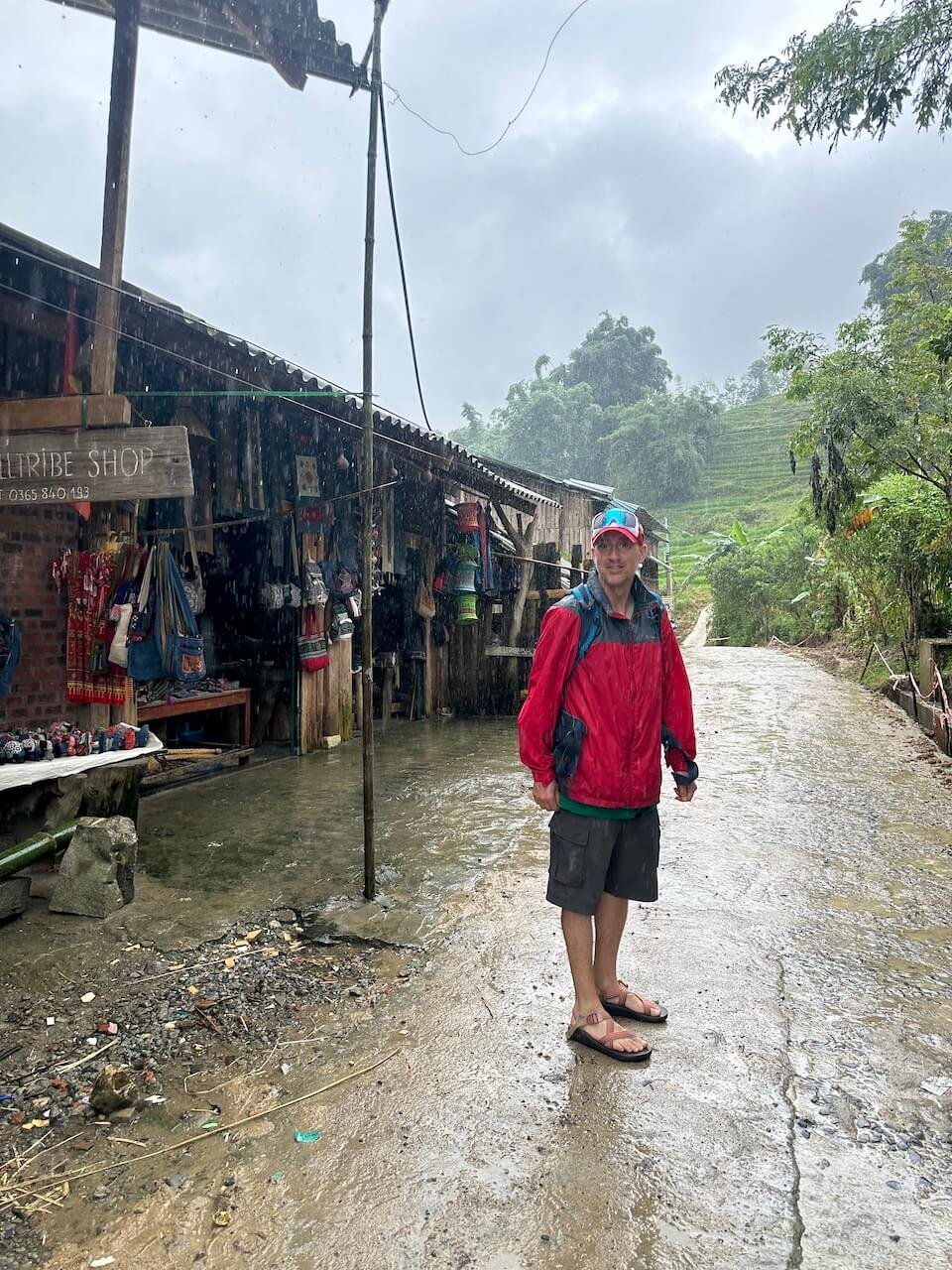
🎥 Watch: Trekking in Sapa During the Rainy Season
Check out our hike, complete with fog, sandals, and some seriously dramatic landscapes. Spoiler: I ditched the boots and went full-Coloradan with my Chacos.
🛏️ Where to Stay in Sapa: Best Hotels, Homestays & Our Top Pick
Sapa offers a wide range of accommodations — from luxurious retreats with misty mountain views to cozy homestays nestled among rice terraces. Whether you’re looking to treat yourself or stick to a backpacker budget, there’s a perfect place to stay that fits your style.
In this section, I’ll share:
- My honest review of Pao’s Sapa Leisure Hotel, where we stayed
- Three other hotels I seriously considered
- Budget-friendly guesthouses and hostels
- A few standout homestay options for deeper cultural immersion
Let’s dive in.
🏨 Midrange & Luxury Hotels in Sapa
These are the hotels I either stayed at or seriously considered — all with beautiful views, excellent amenities, and options for different budgets if you’re looking for more comfort.
🌄 Pao’s Sapa Leisure Hotel – Scenic Luxury Near Town
I wanted our time in Sapa to feel a little special, so I splurged a bit on a stay at Pao’s Sapa Leisure Hotel — and honestly, no regrets.
Perched on its own hillside just outside town, the hotel overlooks the stunning Muong Hoa Valley. We had sweeping views of terraced rice fields right from our balcony and were still just a 10-minute walk from Sapa’s main streets.
Here’s what stood out:
- Unbeatable views from mountain-facing rooms
- Spacious, spotless rooms with subtle local touches
- An incredible breakfast buffet with a view (Vietnamese coffee lovers, you’re in luck)
- Helpful staff and concierge who can assist with activities and transfers
- Quiet location just outside town — close, but peaceful
👉 Check rates and availability for Pao’s Sapa Leisure Hotel

Here’s what made Pao’s the perfect choice:
Mountain Views from Pao’s Sapa – Worth the Upgrade?
Sapa is all about the views, and Pao’s delivers in spectacular fashion. Perched on its own hillside high above the valley, the hotel offers stunning scenery from every floor—as long as you book a mountain-facing room. I’ll let the photos and video below do the real talking, but trust me, waking up to that landscape never got old.
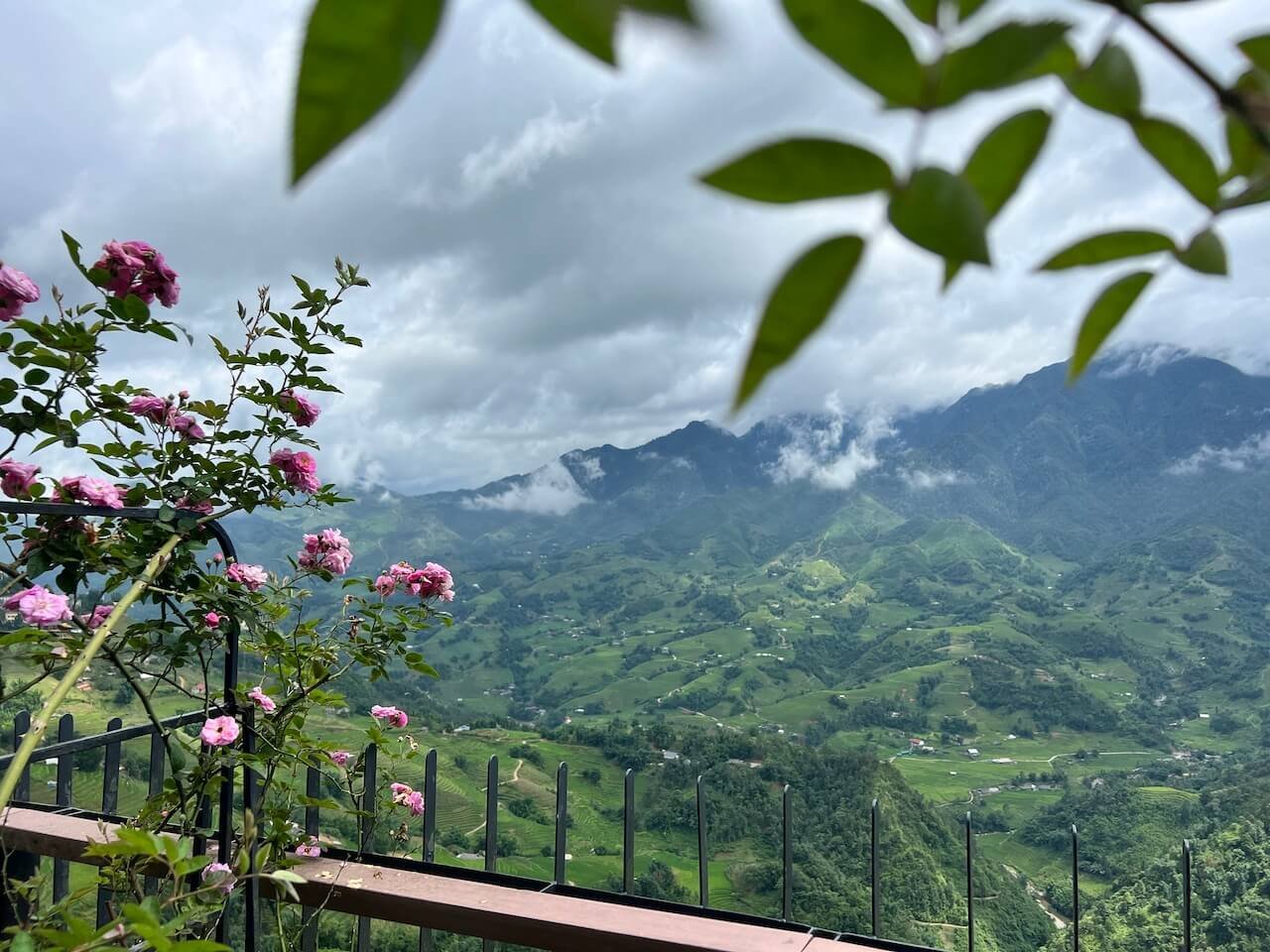
Initially, I considered properties further outside of town with equally amazing views, like Maison de Lao Chai (listed below). However, I ultimately decided I wanted to be close to Sapa Town without being in the thick of the backpacker scene. Pao’s was the perfect balance—just on the outskirts, a 5–10 minute walk to the main area, with some excellent restaurants and cafés just steps away.
Inside the Rooms at Pao’s: Comfort, Cleanliness & Style
I wanted a spacious, clean room—modern wasn’t a necessity, but I wasn’t looking to “rough it” either. Pao’s struck a great balance. While you can find more rustic, traditional stays, the hotel does a nice job incorporating local culture through decor and staff uniforms.
The room itself was exceptionally clean, the bed was massive and comfortable, and the staff went out of their way to accommodate requests and help arrange activities.
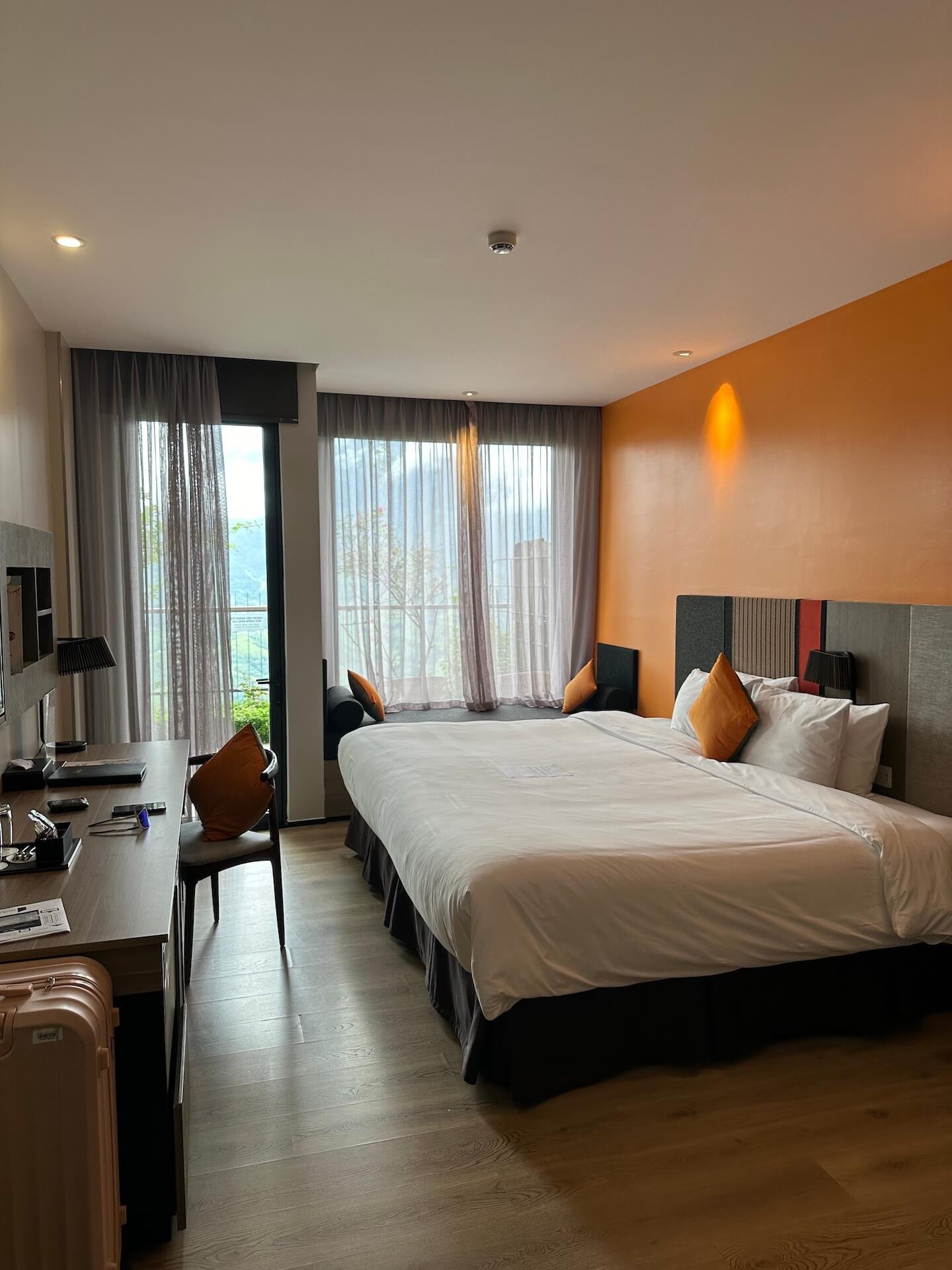
Breakfast at Pao’s Sapa: Views, Vietnamese Coffee & More
My second half wouldn’t have left Sapa happy without an amazing breakfast buffet, and Pao’s more than delivered. The dining room overlooks the valley, making it the perfect spot to start the day—and to make your friends jealous back home.
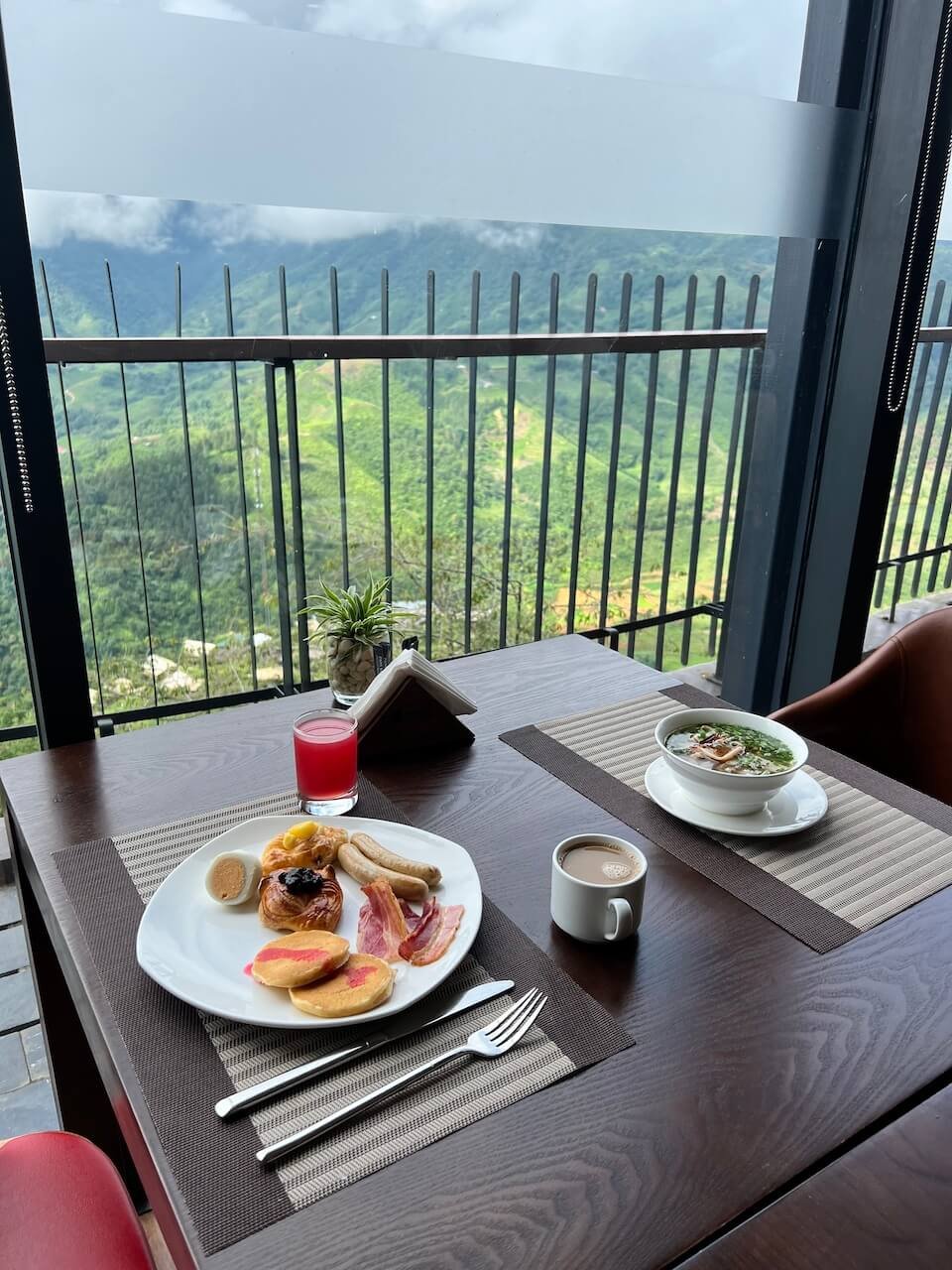
The buffet had everything from Western-style breakfast staples to local Vietnamese dishes and desserts galore. As a dedicated Vietnamese coffee fan, I also drank more than is probably recommended by taking advantage of the unlimited supply.
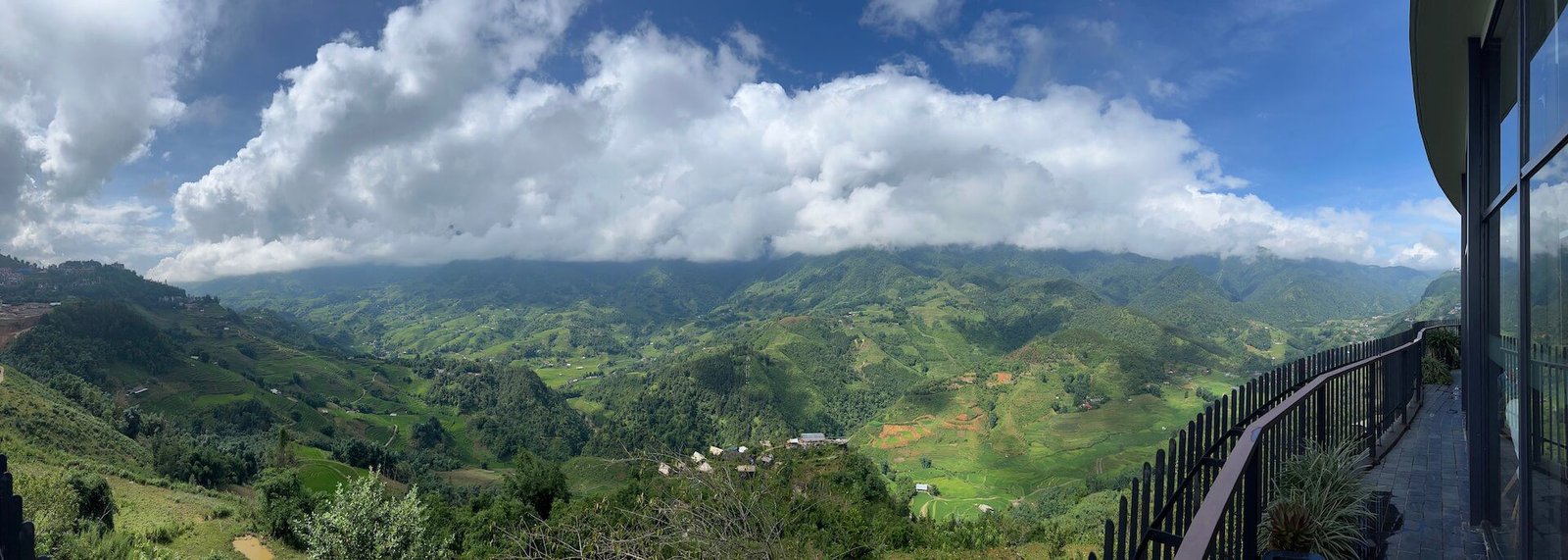
Other Amenities at Pao’s (Pool, Gym, Concierge)
If there’s one thing Pao’s Sapa Leisure Hotel lacks, it might be a standout swimming pool. Some of the other hotels I considered—like Bamboo Sapa Hotel (see below)—boast stunning infinity pools with breathtaking views. While Pao’s does have a heated indoor pool, we never felt particularly drawn to using it.
We also didn’t take advantage of the fitness center, children’s services, or rooftop bar—not because they aren’t great perks, but because we’re child-free, I’m newly sober, and neither of us are gym rats. That said, for those who are, Pao’s has you covered.
The concierge service was also exceptionally helpful, offering tour bookings and guided experiences. But, as is the theme here, we preferred to chart our own path through Sapa. That said, I wouldn’t hesitate to recommend this service for those who like a bit more structure in their travels.
🎥 Watch: Our Pao’s Experience
If you’re looking for a comfortable, scenic, and well-located stay in Sapa, I highly recommend Pao’s Sapa Leisure Hotel. Check out the YouTube Short below for a quick look at our experience!
Is Pao’s Sapa Leisure Hotel Worth It? Final Thoughts
Pao’s Sapa Leisure Hotel was the perfect choice for our stay, offering a peaceful retreat with breathtaking mountain views, a prime location just outside the busy town center, and excellent amenities.
It also served as a convenient starting point for our self-guided trek. From the hotel’s front door, we simply stepped outside to begin our descent into Muong Hoa Valley, leading to Lao Chai Village.
Of course, Pao’s wasn’t my only consideration. Below, I’ll introduce three other standout hotels—Maison de Lao Chai, Bamboo Sapa Hotel, and Silk Path Grand Sapa—that I seriously considered before settling on Pao’s. Each has something unique to offer, and I’ll share why they made my shortlist.
To help you choose the best option for your stay, I’ve also included an interactive lodging map at the end of this section.
🌾 Maison de Lao Chai – A Secluded Stay Among the Rice Terraces
Originally, I booked Maison de Lao Chai — a boutique hotel tucked deep in Lao Chai Valley. It’s perfect for travelers looking to get away from it all and immerse themselves in nature.
We ended up walking past it on our self-guided trek, and wow — the views and atmosphere were stunning. I only switched because I decided I wanted to be closer to town.
- Serene location among rice terraces
- Rustic-luxe design and open-air mountain views
- Family-run vibe with warm service
- Taxi service to/from Sapa Town arranged by the property
- 👉 See more photos and book Maison de Lao Chai
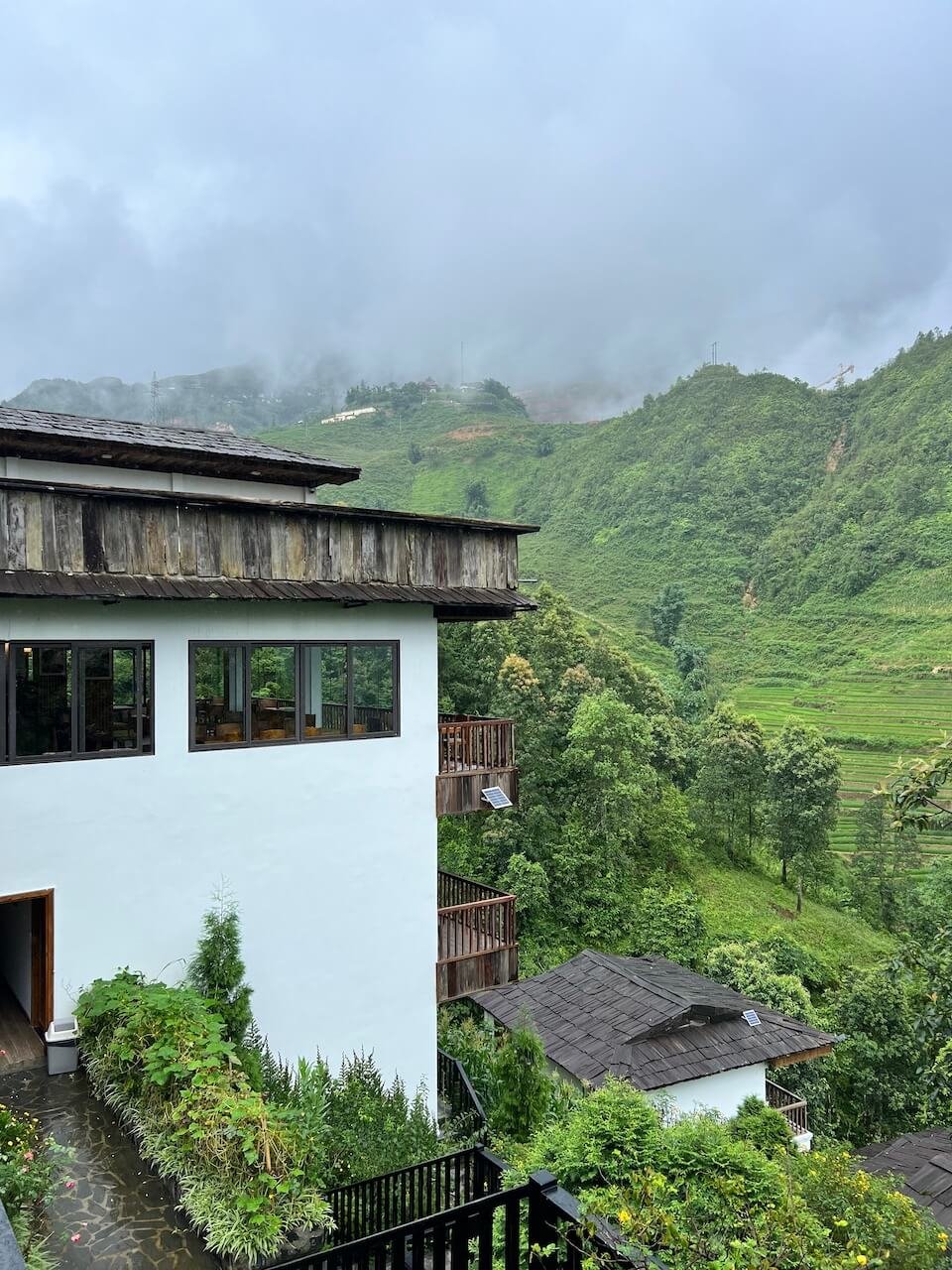
🏞️ Bamboo Sapa Hotel – Infinity Pool Views Without the Luxury Price
If you want killer views but don’t want to splurge, Bamboo Sapa Hotel is a solid midrange option.
This was high on my shortlist thanks to its central location and that show-stopping infinity pool overlooking the valley. It’s close to everything — food, markets, trekking routes — but still offers a peaceful atmosphere.
- Panoramic views from the pool and rooms
- Central location in Sapa Town
- On-site restaurant, bar, and helpful tour desk
- Stylish, comfortable rooms with a boutique feel
👉 Check rates and availability for Bamboo Sapa Hotel
🏔️ Silk Path Grand Sapa Resort & Spa – Five-Star Comfort in the Clouds
Want to go all out? Silk Path Grand Sapa Resort & Spa is the most luxurious option I considered.
This five-star property blends traditional Vietnamese design with elegant modern finishes. It’s a bit outside of town, but they offer shuttle service so you can enjoy the best of both worlds.
- Lavish rooms with balconies and mountain views
- On-site spa, indoor pool, and fine dining
- Shuttle service into town
- A quiet and serene atmosphere for unwinding after treks
👉 View more details and book Silk Path Grand Sapa Resort
💸 Budget Guesthouses & Hostels in Sapa
If you’re traveling on a budget, don’t worry — Sapa has tons of affordable stays that don’t skimp on charm or comfort. Here are a few great-value places I came across in my research:
🌿 Eco Rice Fields House – Peace & Nature on a Budget
A peaceful stay surrounded by rice terraces? Yes, please.
Eco Rice Fields House offers traditional Vietnamese design in a tranquil rural setting. Perfect for those wanting to get away from the crowds and soak up the scenery.
- Serene location in the hills
- Cozy wooden bungalows with mountain views
- Close to trekking trails
- Great for solo travelers or couples
🛋️ Pea Hostel – Chill, Clean & Central
Pea Hostel is a great option if you want to be in the middle of everything without sacrificing comfort.
This hostel gets high marks for cleanliness and social vibes. It’s centrally located near restaurants and shops — great for meeting fellow travelers.
- Dorm and private room options
- Social atmosphere and common areas
- Clean facilities and helpful staff
- Steps from Sapa’s main drag
👉 Check Pea Hostel availability
🎒 Sapa Backpacker Hostel – Tried & True Budget Pick
Looking for the classic budget backpacker setup? Sapa Backpacker Hostel delivers.
Simple, central, and ultra-affordable, this hostel is ideal for solo travelers, digital nomads, or anyone who just needs a clean bed and a friendly vibe.
- Dorm beds with lockers
- Communal lounge & tour desk
- Basic but clean and reliable
- Walking distance to markets and cafes
🏡 Homestays in Sapa – Connect with Local Life
For a more immersive experience, staying in a local homestay is a great way to connect with the ethnic minority communities of the region. Many homestays are family-run and offer home-cooked meals and insight into traditional life. Whether you’re looking for a traditional stay in a Hmong or Dao village or a more modern homestay with added comforts, there are countless options available.
While I opted for a midrange hotel on this trip, I’ve had incredible homestay experiences in places like Borneo and Myanmar. If you’re looking for something with more privacy—like a cabin-style retreat or a home with a kitchen—VRBO also offers listings in Sapa that could be a great fit.
During my research, these three options stood out as excellent choices in Sapa.
As with the guesthouses, I don’t have my own photos of these wonderful homestays, so I encourage you to click the links to see what they have to offer.
🌄 Sapa Eco Homestay – Rustic Charm with Valley Views
Set just outside of town, Sapa Eco Homestay is ideal for nature lovers.
Expect bamboo huts, rice field views, and a super chill atmosphere. Guests rave about the hosts and the food.
- Private bungalows with mountain scenery
- Homemade meals with local ingredients
- Warm, welcoming hosts
- Peaceful, off-the-grid vibe
👉 Check availability for Sapa Eco Homestay
💚 My’s Homestay – A Cultural Experience with Heart
Run by a local Hmong family, My’s Homestay offers a genuine look into Sapa life — along with delicious food and great hiking right from the door.
- Simple but cozy rooms
- Cultural activities and trekking options
- Home-cooked meals and shared dinners
- A great intro to Hmong village life
👉 Book a stay at My’s Homestay
✨ Moc Home Sapa – Design-Forward Meets Homestay Comfort
Want something a little more stylish without losing the homestay feel? Moc Home Sapa blends authentic touches with a boutique vibe.
- Tastefully designed rooms with wood accents
- Friendly family-run environment
- Peaceful setting, yet still accessible to town
- Great for couples or solo travelers
👉 Check rates and book Moc Home Sapa
Compare Sapa Hotels: Price, Location & Best For
Not sure which place to book? Here’s a quick side-by-side look at the standout hotels, homestays, and hostels I considered — including price range, location, and what kind of traveler they’re best suited for.
| Hotel | Price Range | Location | Best For |
|---|---|---|---|
| Pao’s Sapa Leisure Hotel | $$ | Just outside town | Epic views + comfort |
| Maison de Lao Chai | $$ | Deep in the valley | Peace + nature escape |
| Bamboo Sapa Hotel | $$ | Central Sapa Town | Infinity pool views |
| Silk Path Grand Sapa | $$$ | Hilltop, shuttle to town | Luxury resort experience |
| Sapa Backpacker Hostel | $ | Town center | Budget backpackers |
| My’s Homestay | $ | Village outskirts | Cultural immersion |
Quick Picks – Best Sapa Hotels by Travel Style
- Best for epic views + comfort: Pao’s Sapa Leisure Hotel
- Best for a nature retreat in the valley: Maison de Lao Chai
- Best for infinity pool vibes: Bamboo Sapa Hotel
- Best for a luxury splurge: Silk Path Grand Sapa
- Best for budget backpackers: Sapa Backpacker Hostel
- Best for cultural immersion: My’s Homestay
🗓️ 3 Days in Sapa: A Self-Guided Travel Itinerary
As a lifelong traveler, I aim to support local communities while embracing a DIY approach whenever it’s safe and practical.
For our three-night stay in Sapa during the rainy season of summer 2024, my wife and I chose to explore independently instead of hiring a local guide or joining a tour. I was nursing a mild flu (picked up after a crowded Ha Long Bay cave visit), and we were midway through a month-long Vietnam trip — so flexibility was key.
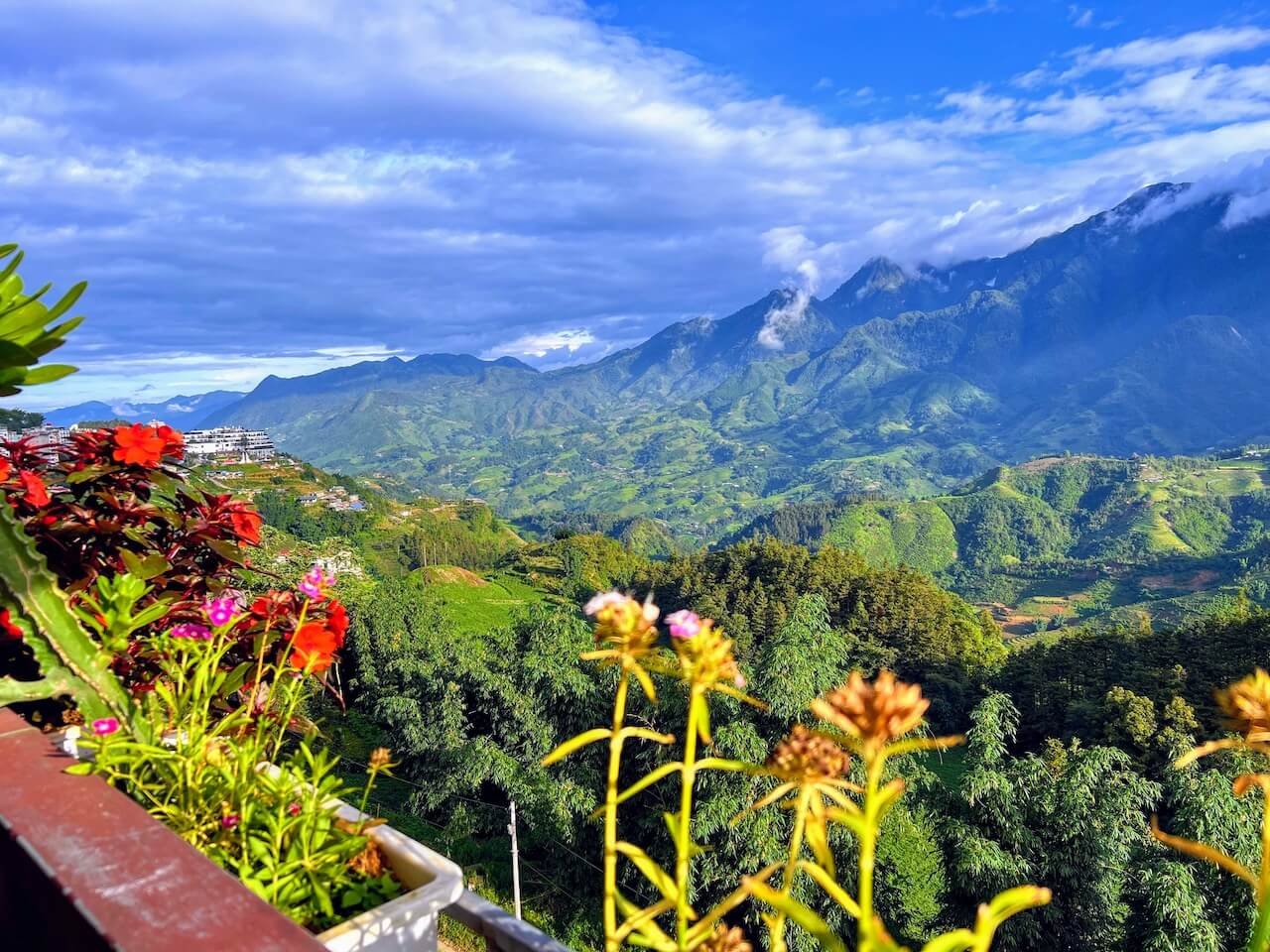
That said, guided treks in Sapa can be a fantastic way to gain cultural insight and support local H’Mong and Dao guides. If you’re curious about those options, you can browse recommended experiences via GetYourGuide or Viator:
👉 Explore top-rated Sapa tours on GetYourGuide
👉 See guided treks, market visits & more on Viator
Affiliate Disclosure: This post contains affiliate links. If you book through them, I may earn a small commission — at no extra cost to you. Thanks for supporting the blog!
Note: The following itinerary reflects how we explored Sapa over three days, but feel free to mix and match based on weather, energy, or personal preference. Each experience stands on its own.
🥾 Day 1 – Self-Guided Trekking in Sapa: Route, Tips & Challenges
Trekking solo in Sapa might sound intimidating, but if you value flexibility over structure, it’s one of the most rewarding ways to explore the Muong Hoa Valley.
You’ll lose the deep cultural storytelling a guide can provide, but you’ll gain total freedom to:
- Linger at viewpoints
- Change your pace
- Embrace spontaneous side trails
The trails are generally well-worn and pass other tour groups, so you’re unlikely to end up alone or lost — especially if you have mobile data or offline maps.
We kept it simple: a half-day, self-guided hike from Pao’s Sapa Leisure Hotel to Lao Chai Village, with stops for photos, food, and scenic breaks along the way. I’ve created a Google MyMaps route (linked above in the map section) with four pins (A–D) to help you follow the same path.
🗺️ Map of Our Self-Guided Trekking Route from Sapa to Lao Chai
Before we get into the route breakdown, here’s a look at the Google MyMap I created, highlighting four key stops along our trek (A–D). You can follow this path if you want a flexible, scenic route from Sapa town to Lao Chai Village — perfect for a half-day adventure without a guide.
📍Pin A – Pao’s Sapa Leisure Hotel
📍Pin B – Sapa Clay House (main trail turnoff)
📍Pin C – Cúc Restaurant & Coffee (midpoint lunch stop)
📍Pin D – The Local Restaurant, Lao Chai (trek endpoint)
This isn’t the most remote trek you can do in Sapa — but it’s a beautiful, beginner-friendly route that still offers incredible views, local encounters, and the joy of discovering the valley at your own pace.
Here’s how the trek unfolded:
📍A: Pao’s Sapa Leisure Hotel
We started our trek right from the hotel’s front steps. A short, steady 20–30 minute walk down the main road brought us to a crucial turnoff: Sapa Clay House.
Watch for traffic (some stretches have no sidewalk), and be prepared to get tailed by overly enthusiastic women offering unofficial “guide” services. Politely decline, and they’ll usually move on.
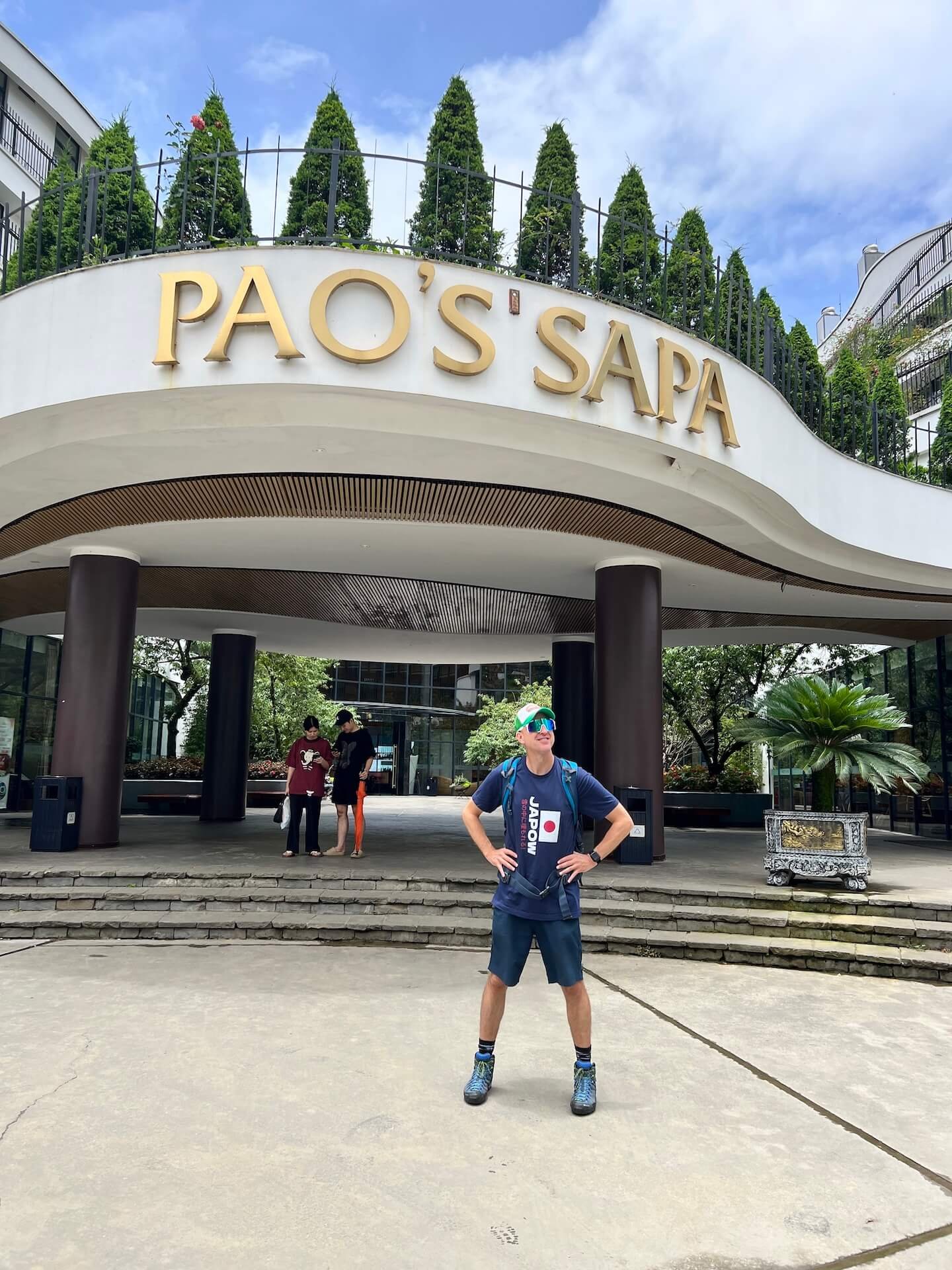
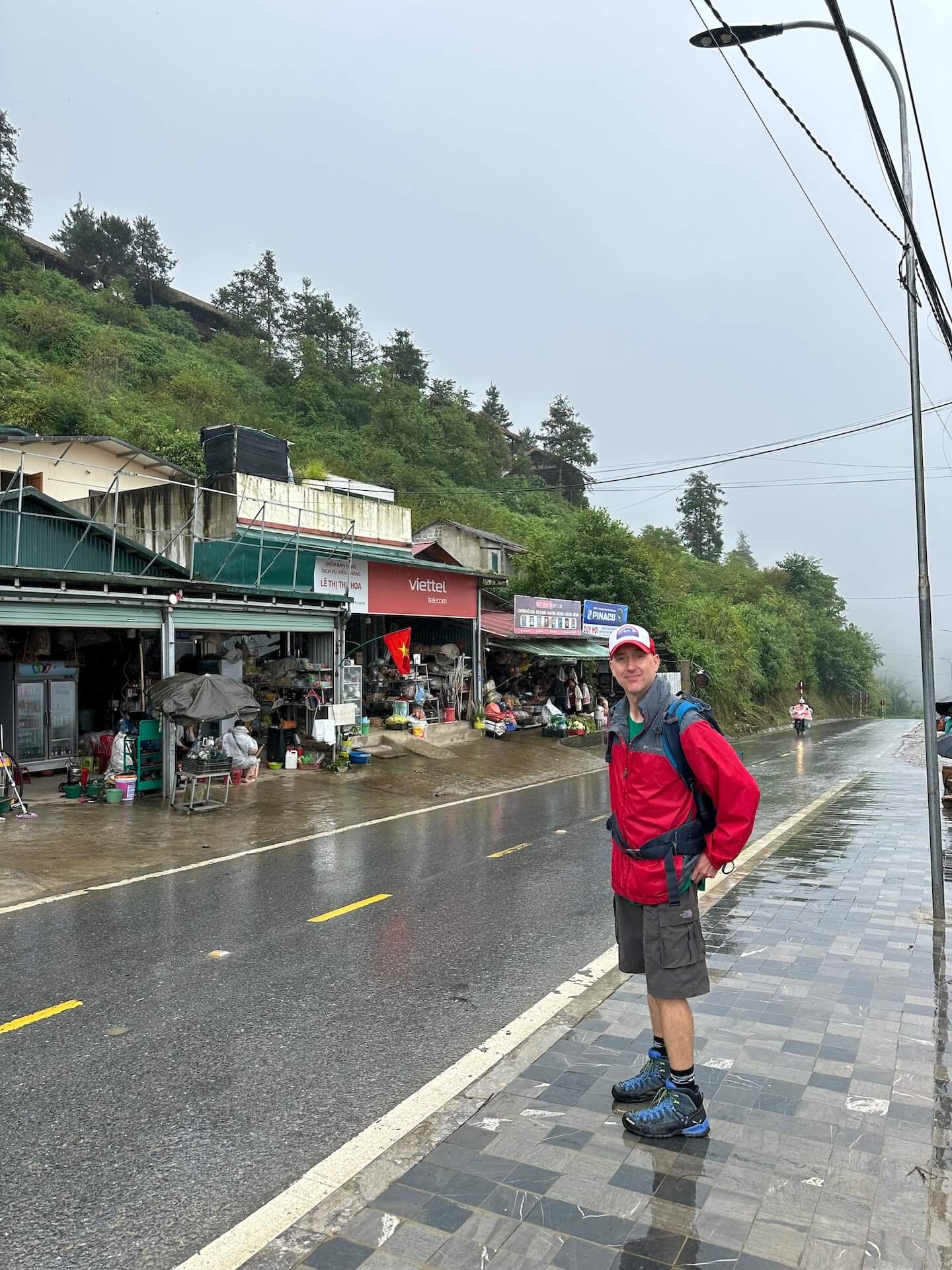
📍B: Sapa Clay House – Turnoff to the Trails
Sapa Clay House marks the transition from road to trail. Look for a small path on the right, near a corner with a blue gate. There’s no big sign — just a subtle turn that many travelers miss.
From here, the route drops into the valley and winds through farmland and hillside villages.
Fun fact: My wife (who’s Korean) recognized Sapa Clay House from Korean travel blogs — it’s a popular eco-lodge with incredible views.
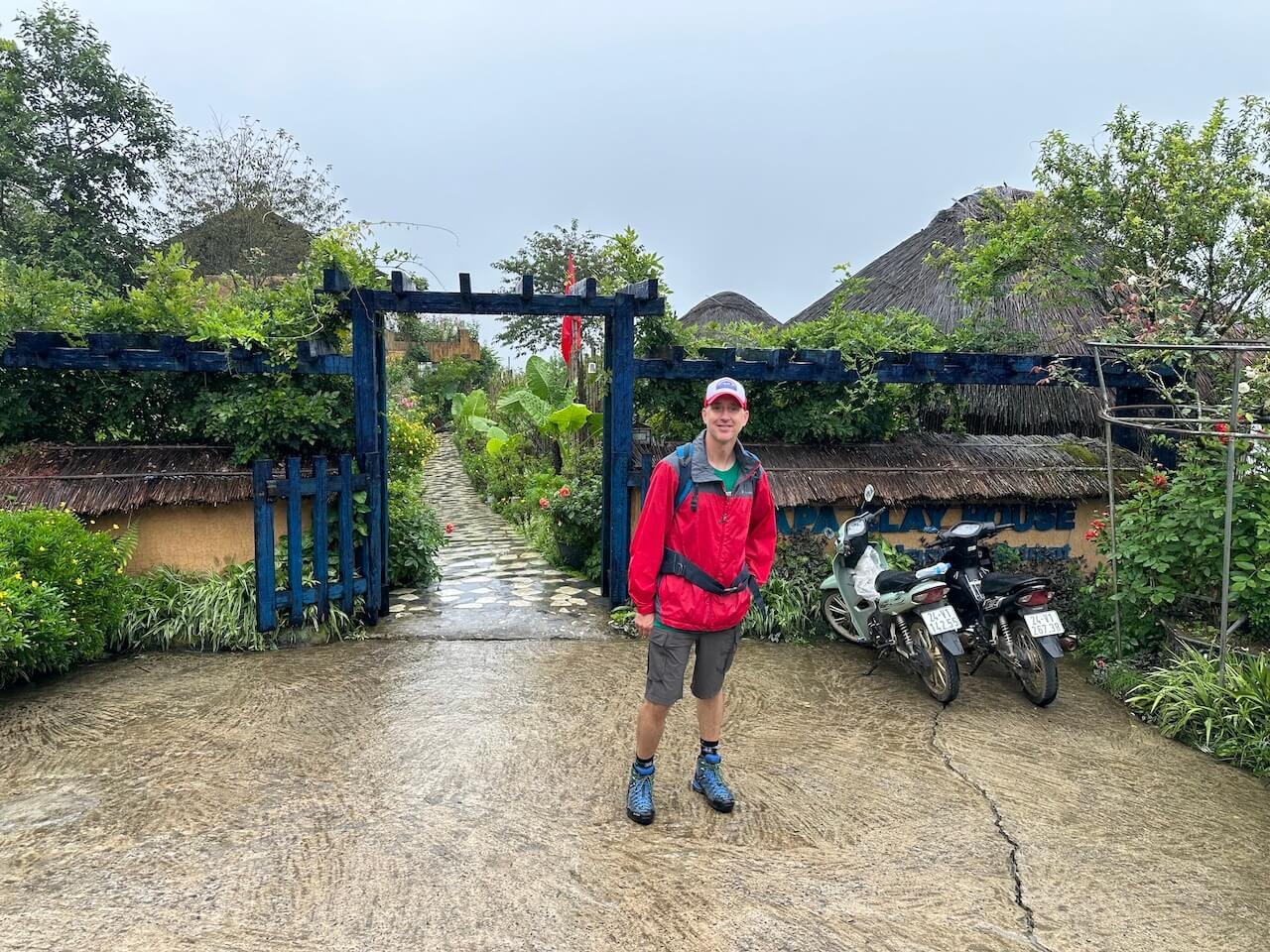
Sticking to the Main Path vs. Exploring Side Trails
Due to rain, we avoided the muddier trails and stuck to the semi-paved road. If you’re lucky with weather, you can branch off onto dirt paths for a more immersive valley experience. Either way, you’ll be rewarded with scenery straight out of a storybook.
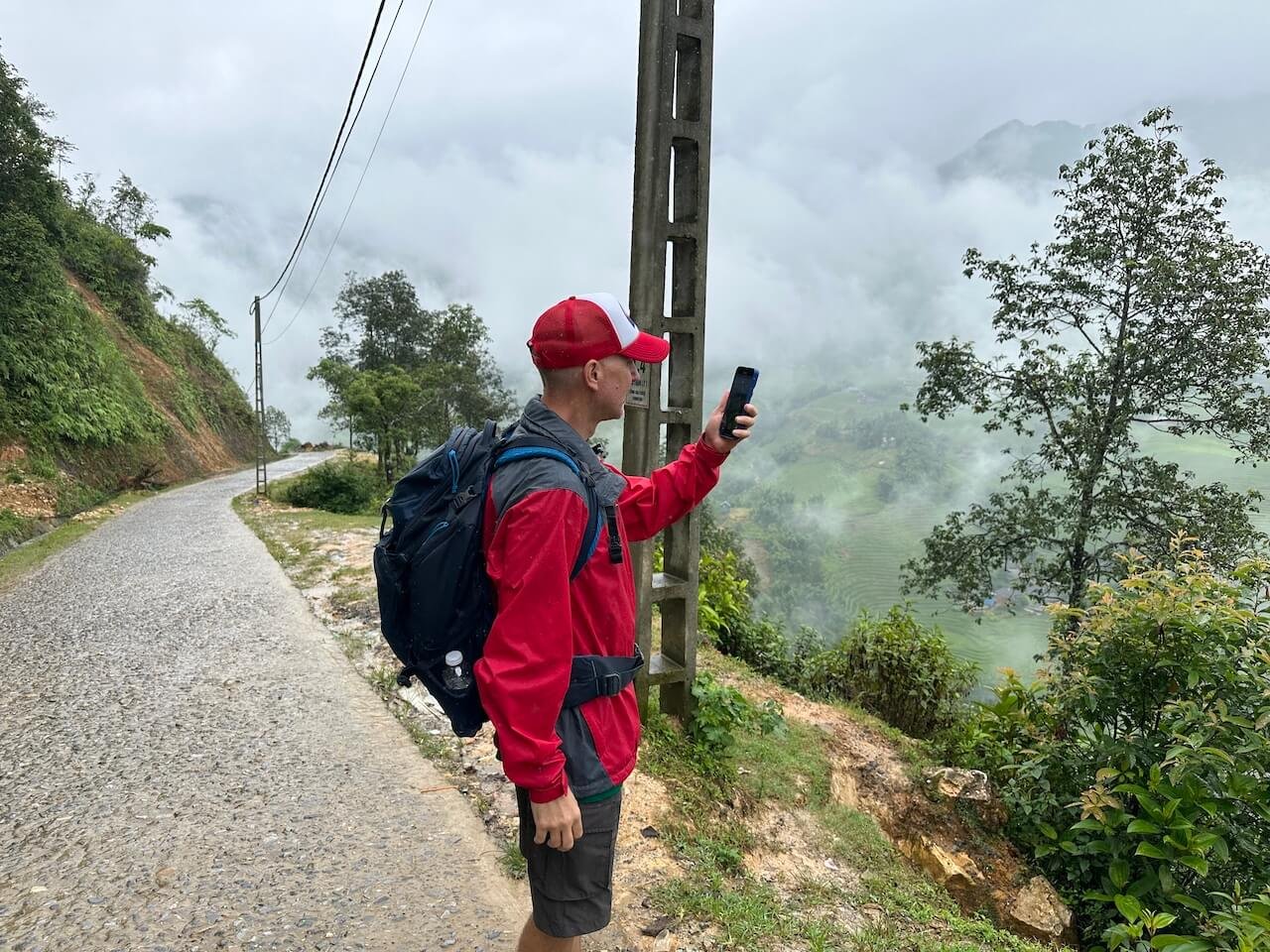
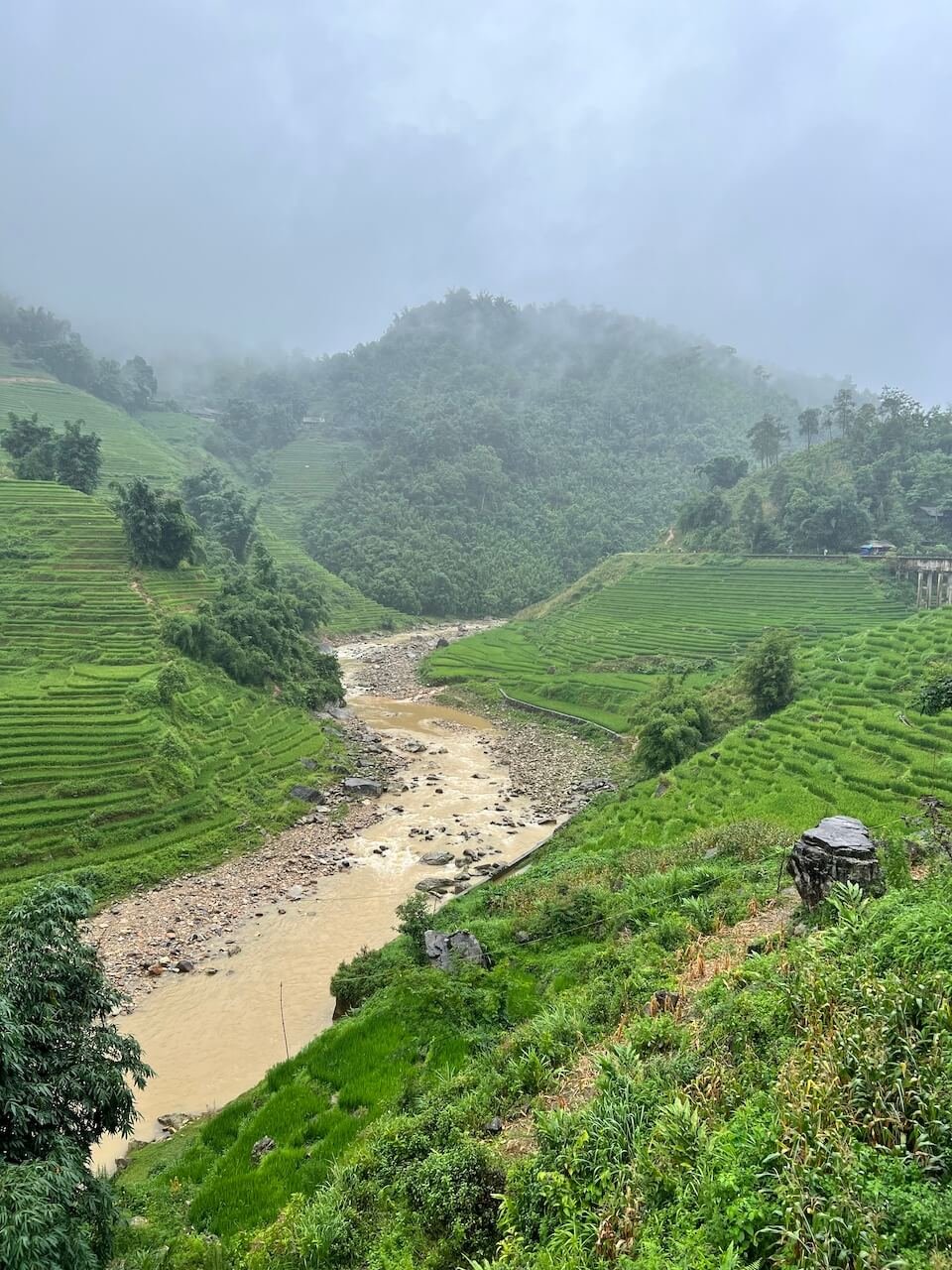
📍C: Cúc Restaurant & Coffee – Cozy Trekker Stop
After a few hours of rain-soaked hiking, we arrived at Cúc — a humble café with hot phở, valley views, and friendly dogs. This spot felt like a hidden oasis and is a perfect midpoint rest stop.
Grab a hot coffee, warm up with noodles, and recharge for the final leg into Lao Chai.

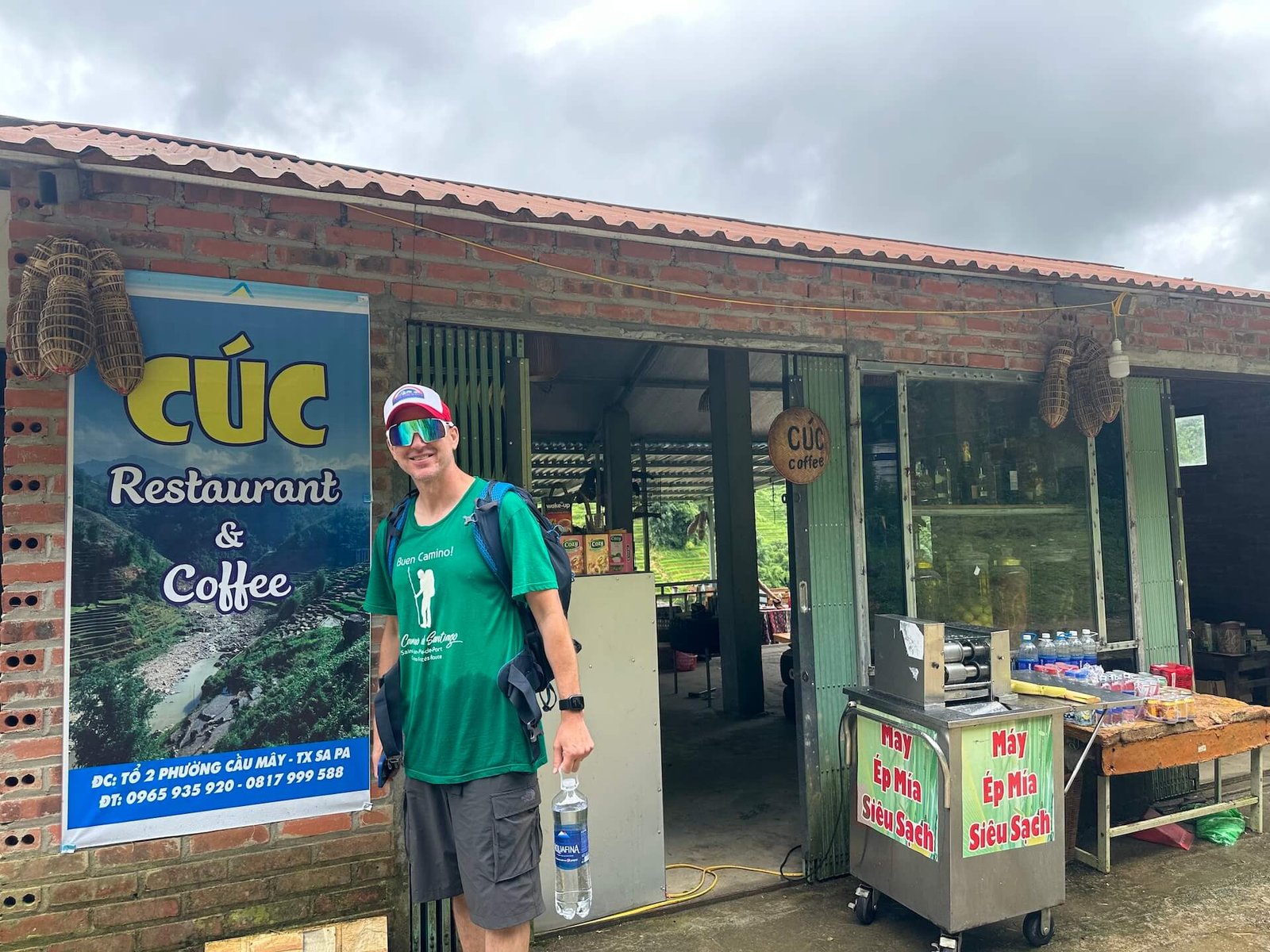
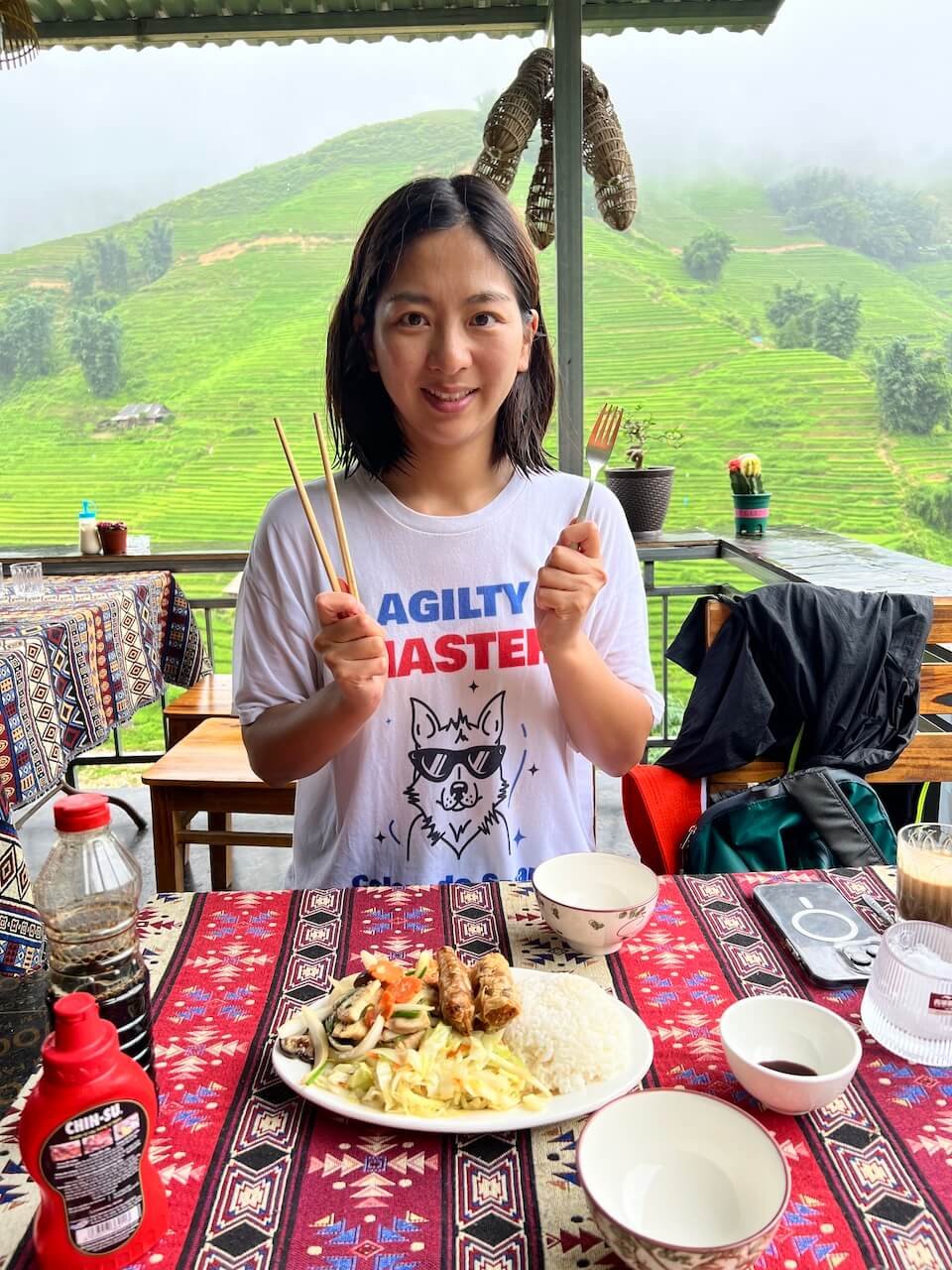
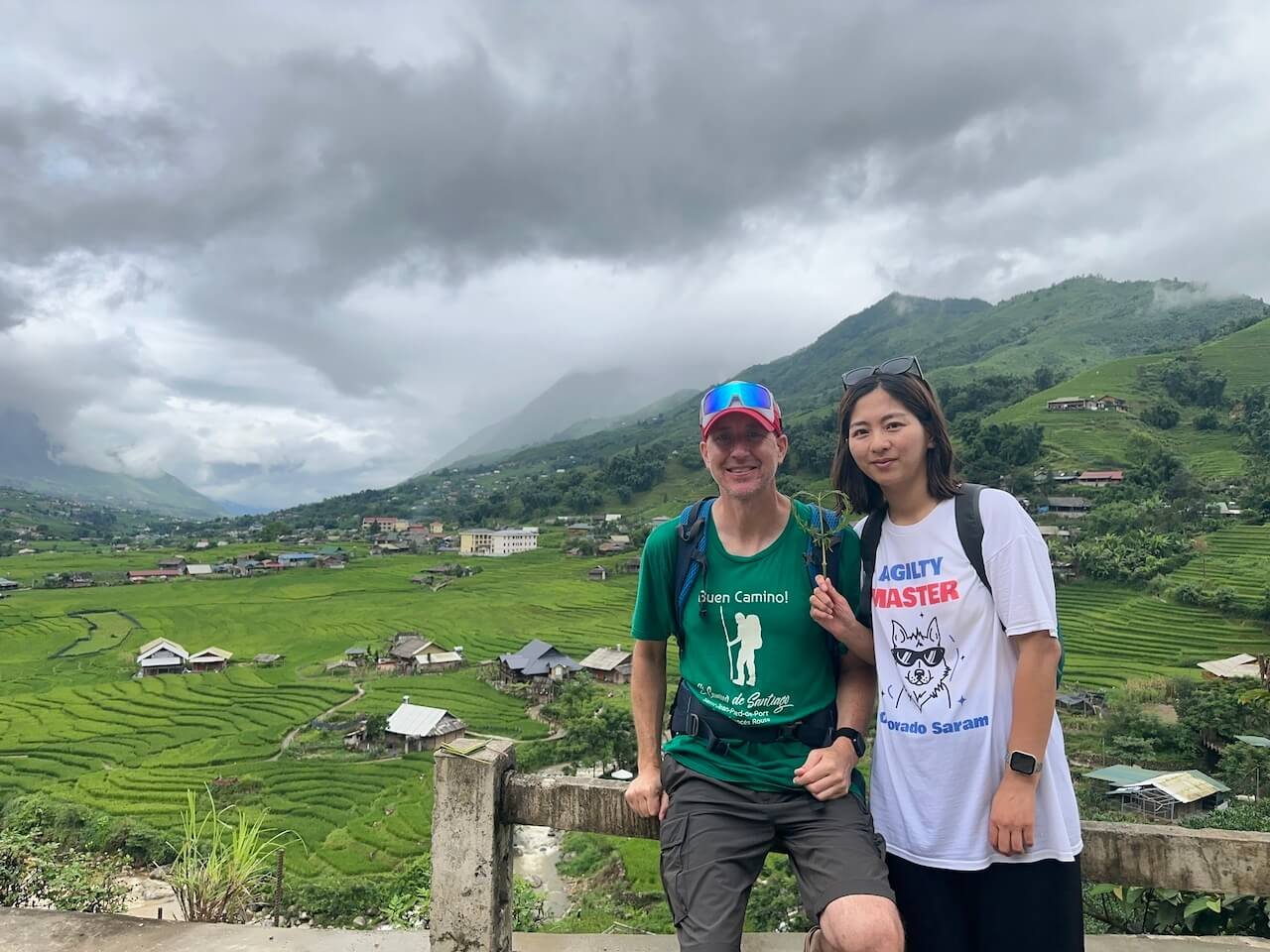
📍D: The Local Restaurant, Lao Chai – Trek’s End
This open-air restaurant sits in the heart of Lao Chai village, overlooking rice terraces and misty peaks. You can stop here for a fresh juice, a full meal, or just a breather.
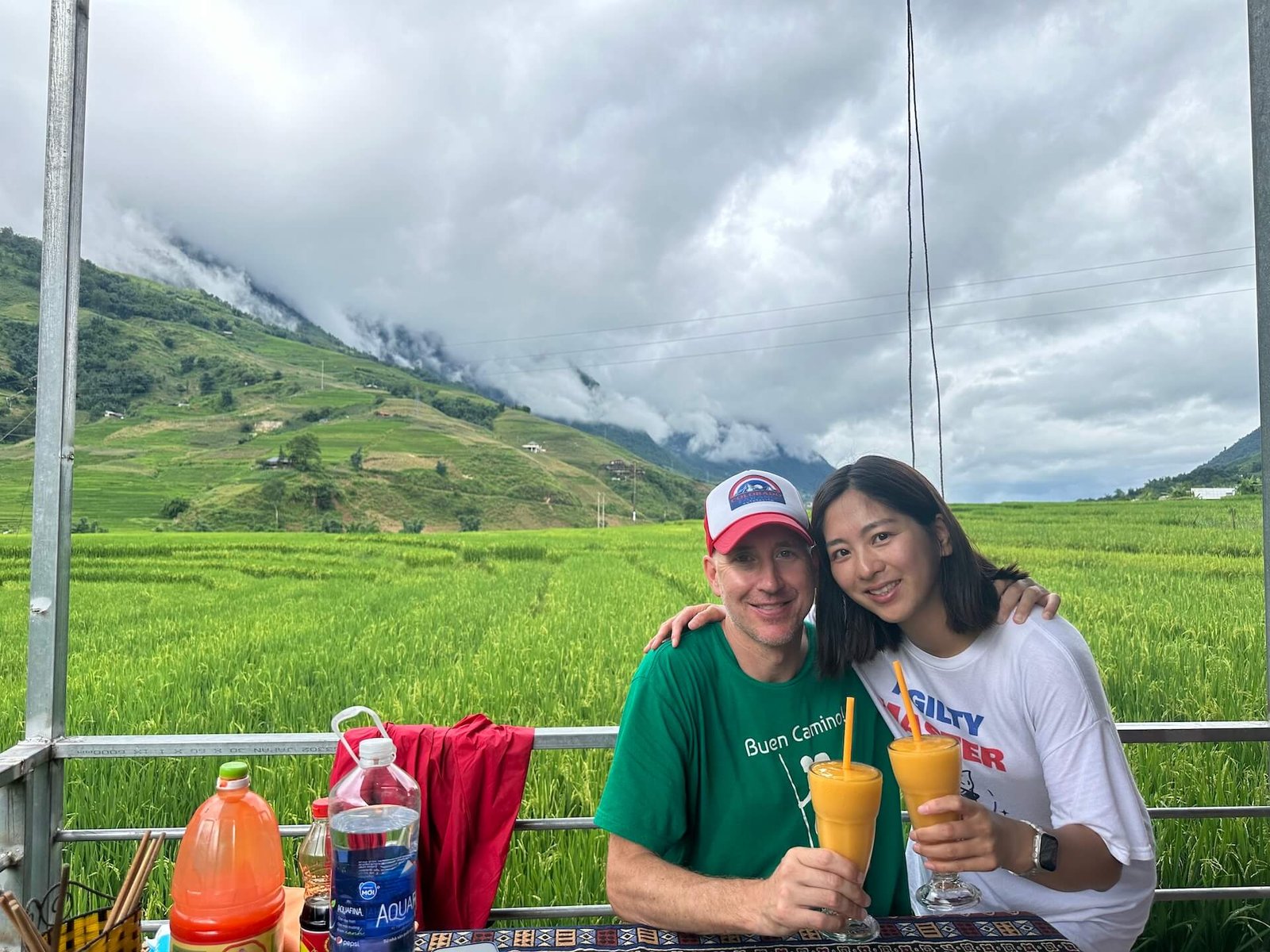
From here, you have three options:
- Keep trekking toward Tả Van Village
- Grab a motorbike or car back to Sapa Town
- Check into a pre-booked homestay in Lao Chai or Ta Van
Exploring Lao Chai Village
Lao Chai is home to the Black H’Mong people and offers a quiet, authentic glimpse into mountain life. Think: stilt homes, free-roaming animals, and handwoven textiles being sold by local artisans.
If you wander deeper into the valley (past the main tourist strip), you’ll discover peaceful paths and scenic pockets that feel a world away from town.
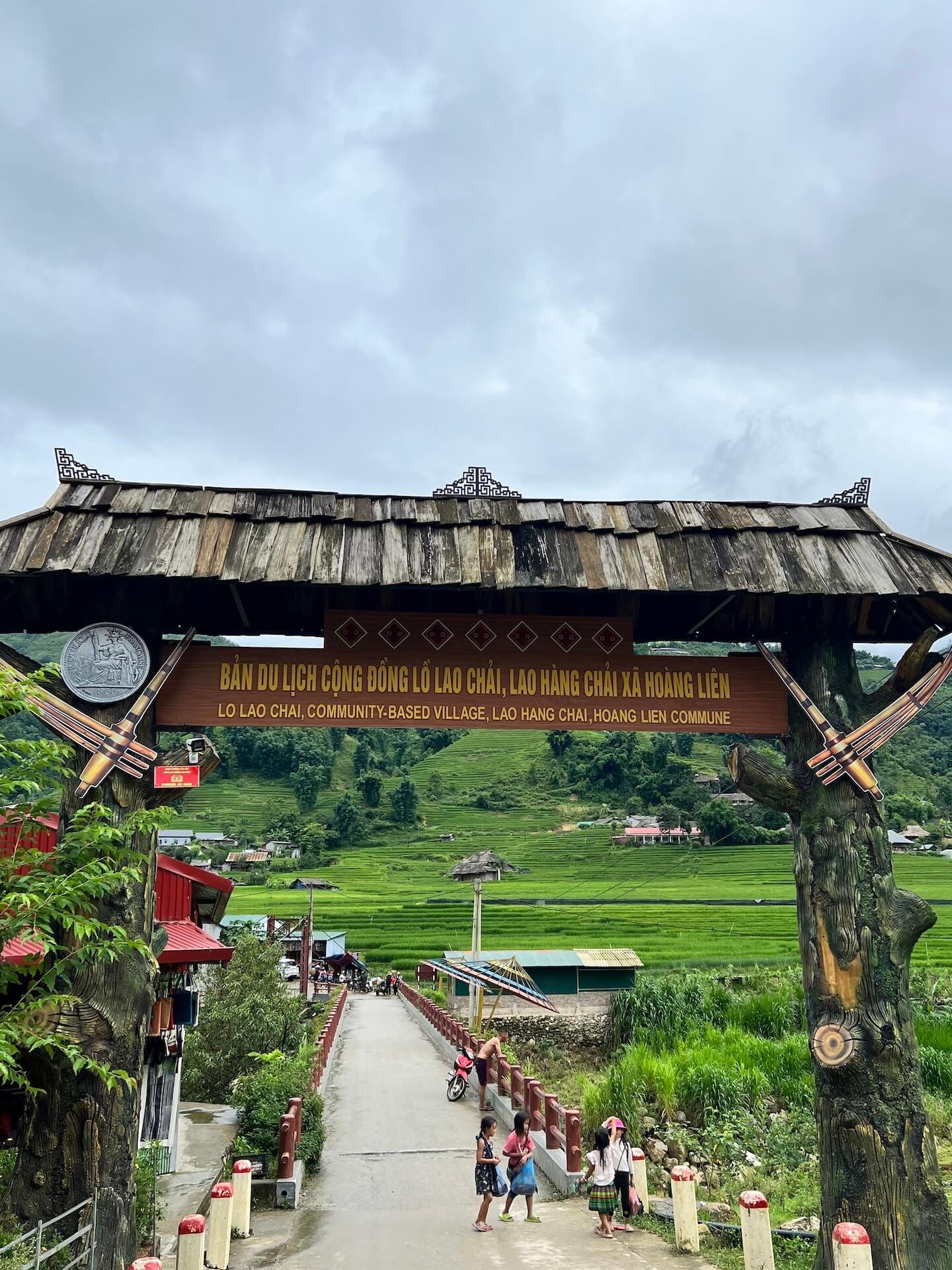
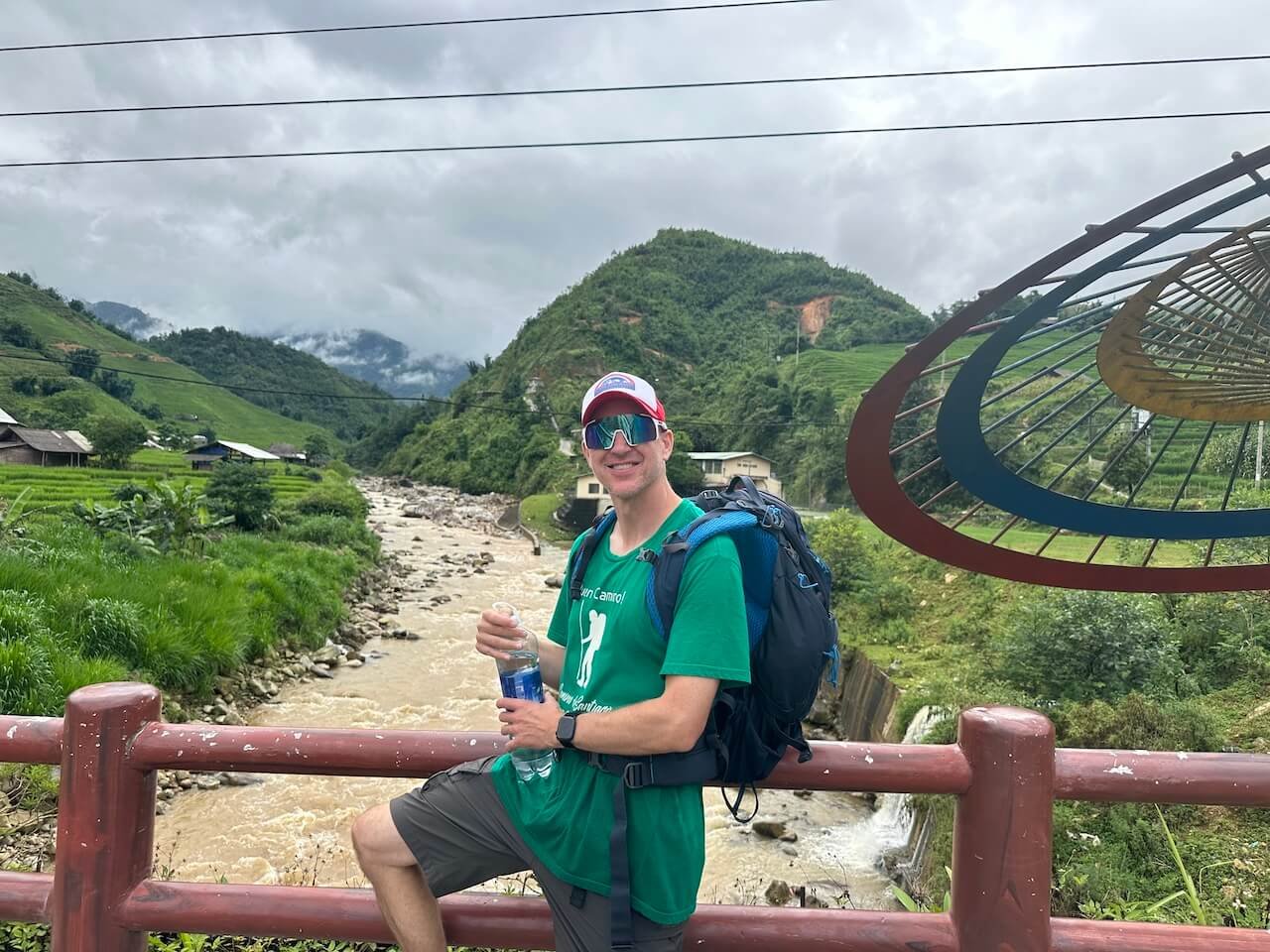
🎥 Watch: Take a walk around Lao Chai Village
How Long Does the Trek Take?
Plan for 6–8 hours total, depending on:
- 🚶 Your pace
- ☁️ Weather conditions
- 🧃 Breaks for food, rest, and views
You can shorten the route by hopping a Grab or bike taxi in Lao Chai if needed.
What to Wear & Pack for Trekking in Sapa
Footwear
- Hiking shoes or trail runners = ideal
- Chacos or hiking sandals = great in wet weather
- Waterproof boots = helpful, but not mandatory
Clothing
- Quick-dry layers
- Rain jacket (always)
- Extra warmth in cooler months (Dec–Feb)
Trekking Essentials
- Water + snacks
- Phone with offline maps
- Hat, sunscreen, insect repellent
- Small cash + translation app
Challenges to Expect on a Self-Guided Trek
- Overly persistent “guides” – Just be polite but firm
- Children selling trinkets – Avoid encouraging dependency
- Trail conditions – Muddy, steep, and slippery in places
Responsible Travel Tips
- Dress modestly in villages
- Don’t give money or candy to children
- Ask before taking photos of locals
- Support small vendors or homestays when possible
Safety Tips for Trekking Without a Guide
- Stick to well-traveled routes
- Download offline maps (Google Maps, Maps.me)
- Watch your footing on steep, muddy paths
- Have a Grab/taxi backup plan
- Carry small bills for emergencies
🚠 Day 2 – Fansipan Peak & Cable Car Adventure
If you’re not up for hiking Vietnam’s highest mountain the hard way, good news — you can still reach the summit of Fansipan (3,147 m / 10,324 ft), the Roof of Indochina, with a scenic ride on a combo of monorail + cable car + funicular.
We tackled Fansipan on our second full day in Sapa. It was misty, moody, and cold — but surprisingly uncrowded due to rainy season travel. While we didn’t get the jaw-dropping panoramic views, the fog and temples created a mystical vibe that made the experience totally worth it.
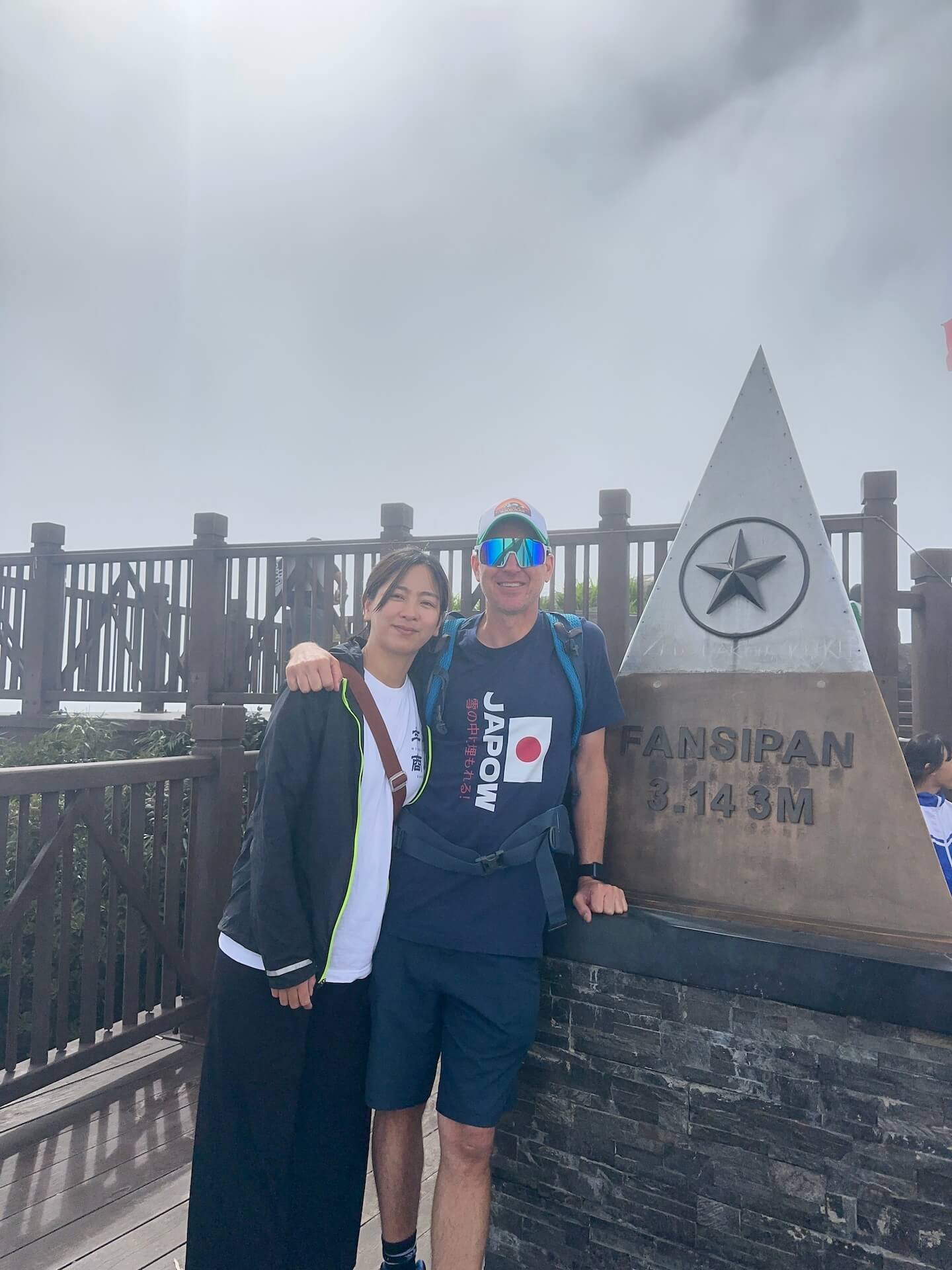
How to Get to the Fansipan Cable Car Station
You’ll start your ascent from Sapa Station, located inside the iconic Sun Plaza building in the center of town. From here:
- Take the Muong Hoa Monorail to Sun World Fansipan Legend (the base area)
- Then walk a short distance to the Fansipan Cable Car terminal
The signage here isn’t always clear, so ask someone if you’re unsure. We accidentally exited the complex and had to be let back in by security 😅.
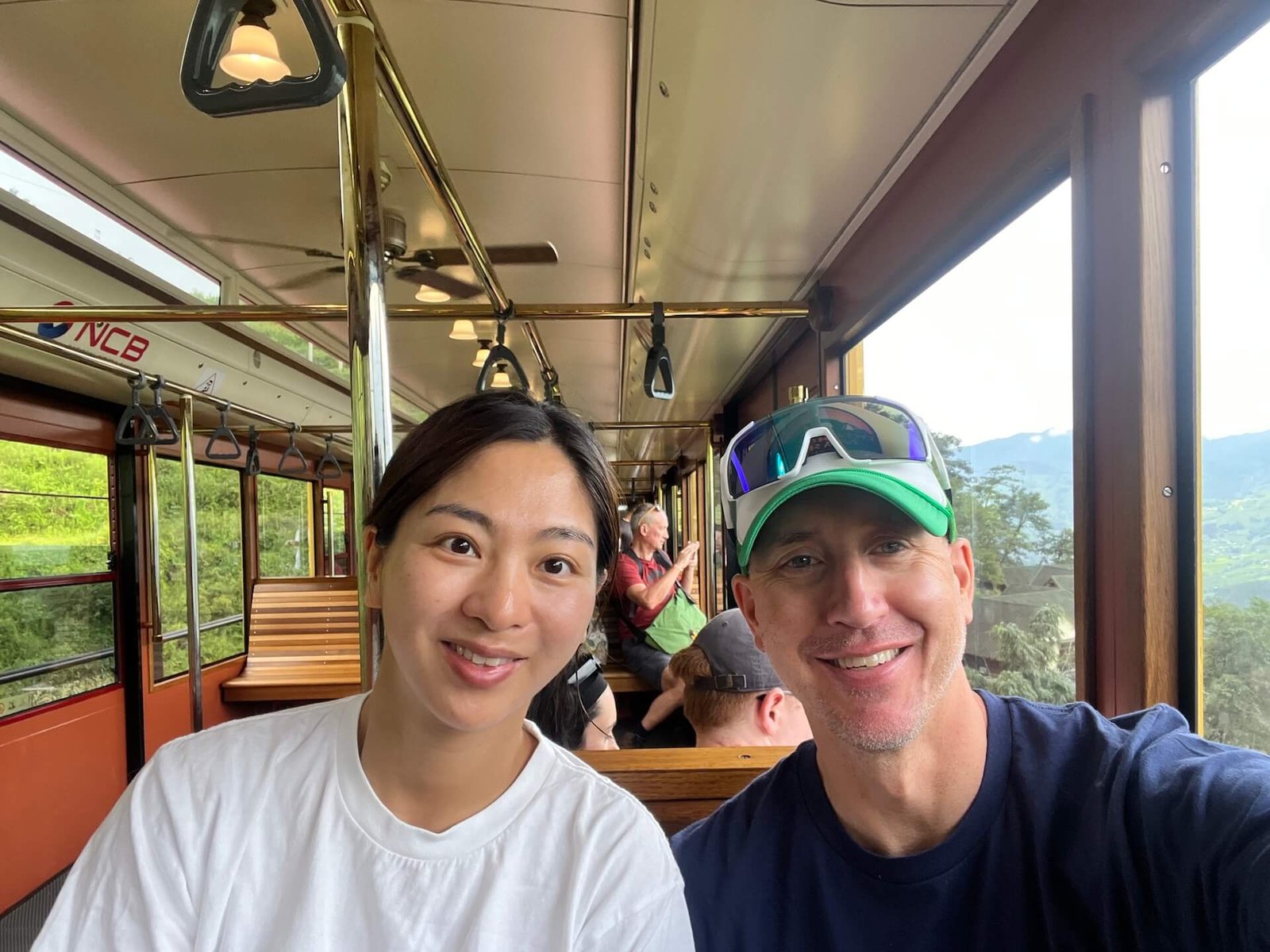
At the end of the monorail ride, you’ll arrive at Sun World Fansipan Legend, a sprawling tourist complex featuring beautifully landscaped gardens, restaurants, and shopping areas. From here, it’s a short walk to the cable car entrance—though signage isn’t always clear, so keep an eye out!
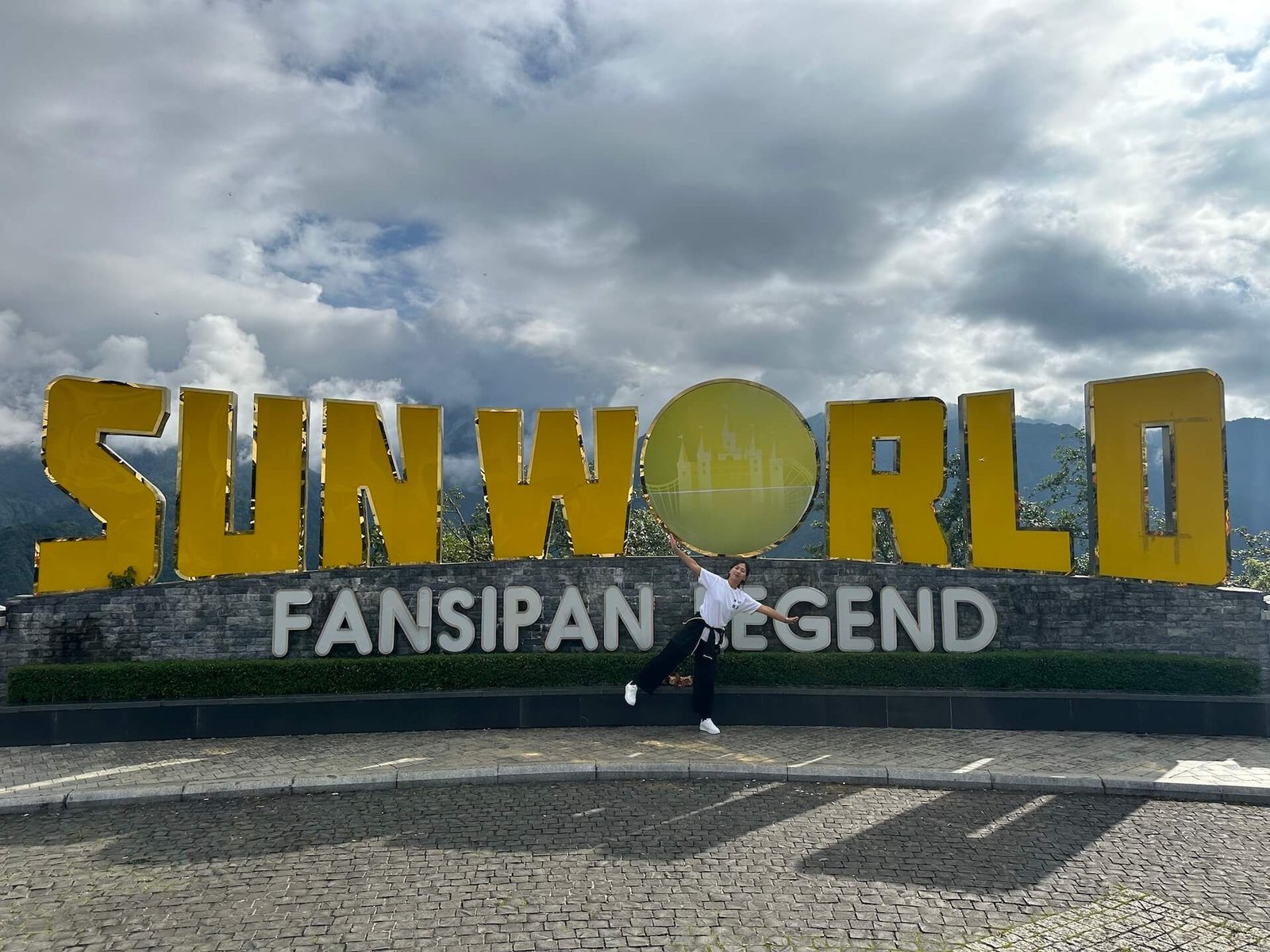
🎟️ Where to Buy Fansipan Cable Car Tickets
I highly recommend booking your tickets online via Klook, which we used throughout our Vietnam trip. It’s easy, fast, and gives you a barcode to scan at each checkpoint — no physical ticket pickup required.
💡 Best Ticket Combo to Choose:
👉 Fansipan Cable Car + Muong Hoa Monorail + Peak Funicular (One-Way Up)
💰 ~$44 USD on Klook
Pro Tip: You only need to ride the funicular up. On the way back down, walking the temple-lined stairways is part of the fun.
🚡 Fansipan Cable Car Ride: What to Expect
- Duration: ~15 minutes
- Distance: 6.3 km — one of the longest and highest cable car routes in the world
- Views: Rice terraces, valleys, and jungle-covered peaks (or clouds, if it’s foggy)
Thanks to the rainy season, we had the cable car to ourselves both directions. During peak season, expect to share with others and wait in lines — so aim for early or late rides if you’re visiting during high season.
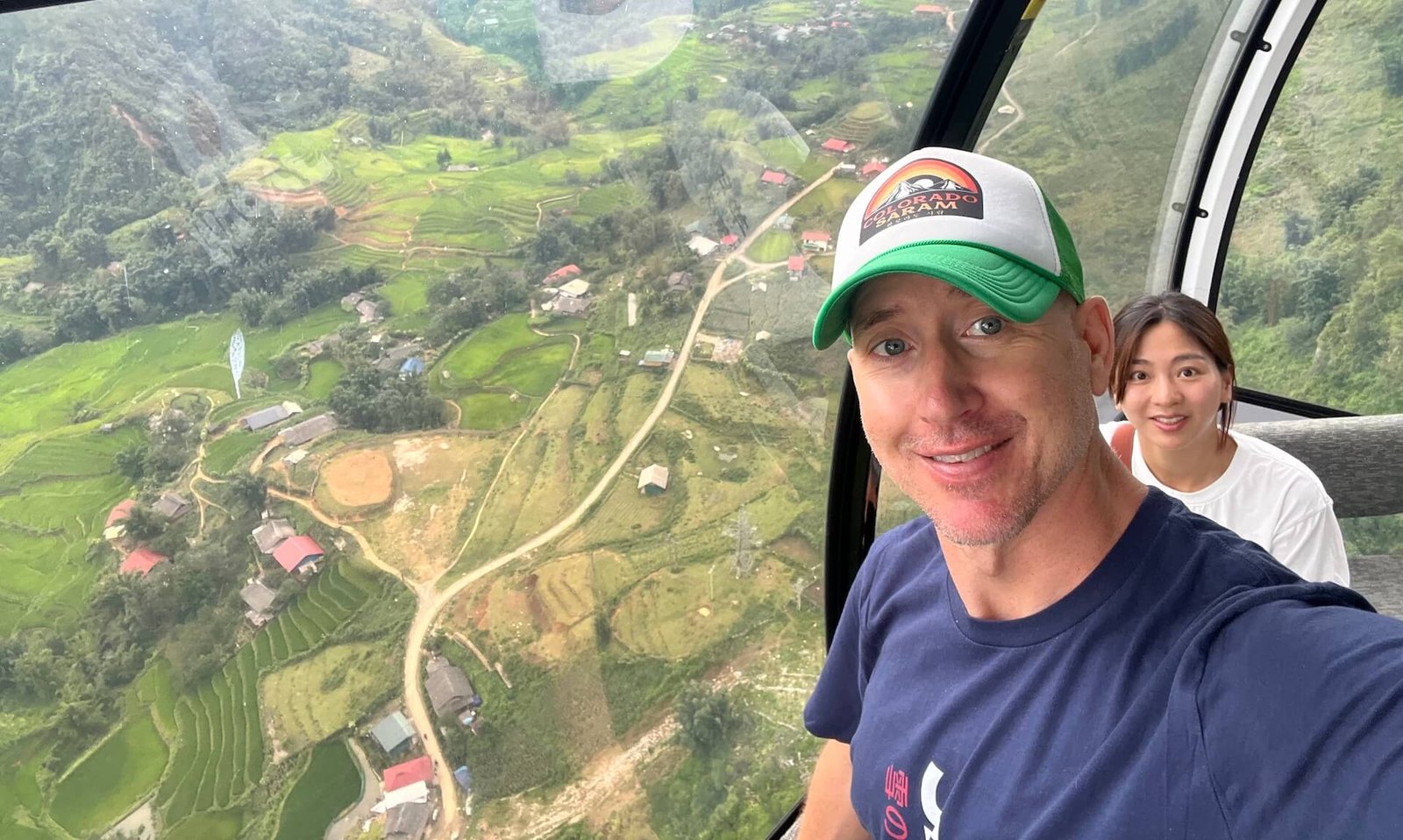
🏯 What to Do at the Top: Temples, Statues & Summit Views
Even if the summit is socked in with fog (like it was for us), the mountaintop complex is still worth exploring. Here’s what you’ll find:
- Fansipan Summit Marker – A popular photo spot with sweeping views when skies are clear.
- Buddhist Temples & Pagodas – Including a massive bronze seated Buddha and peaceful meditation halls.
- Pathways & Sculptures – Winding trails lined with stone lanterns, gates, and intricate carvings.
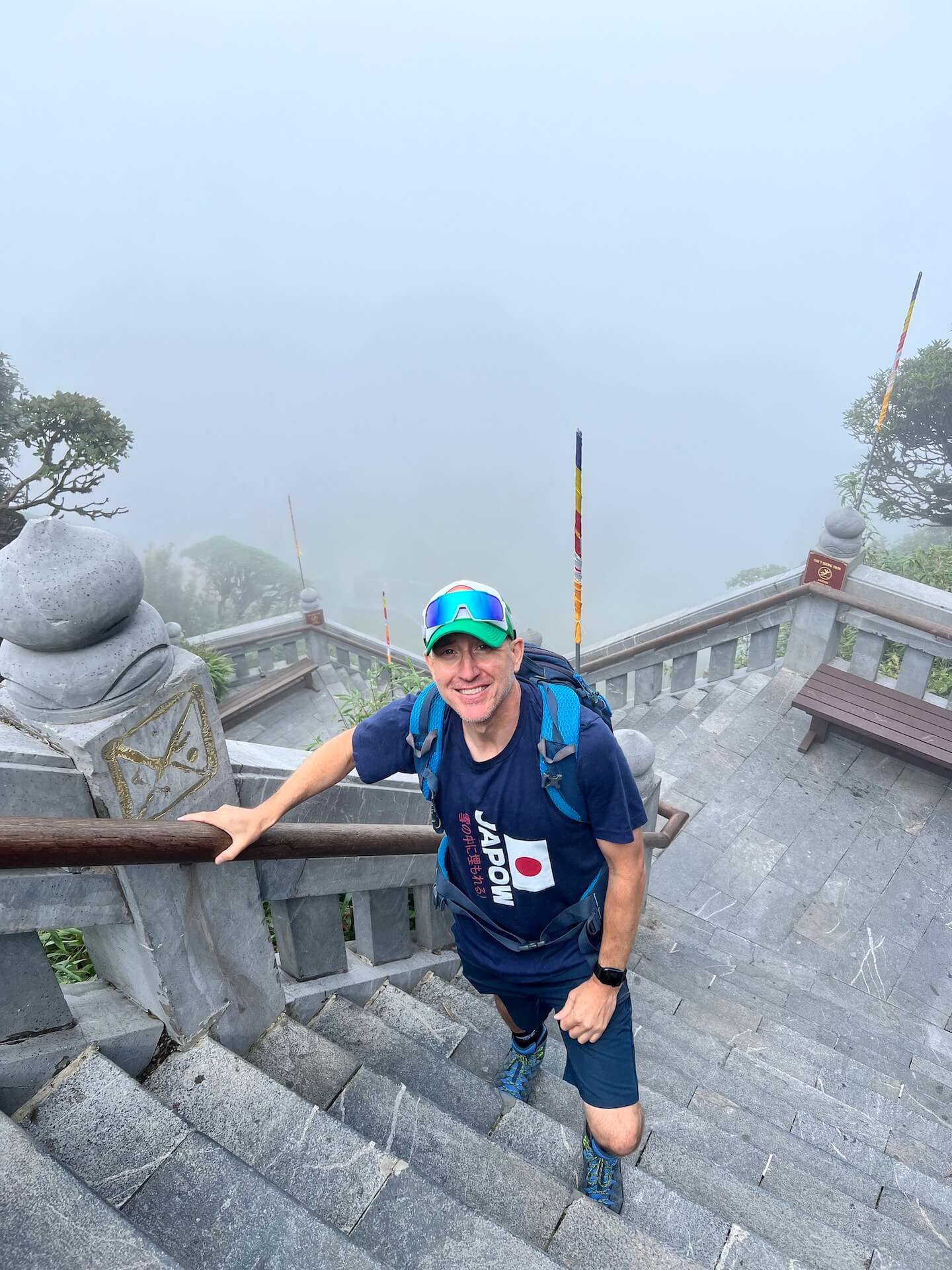
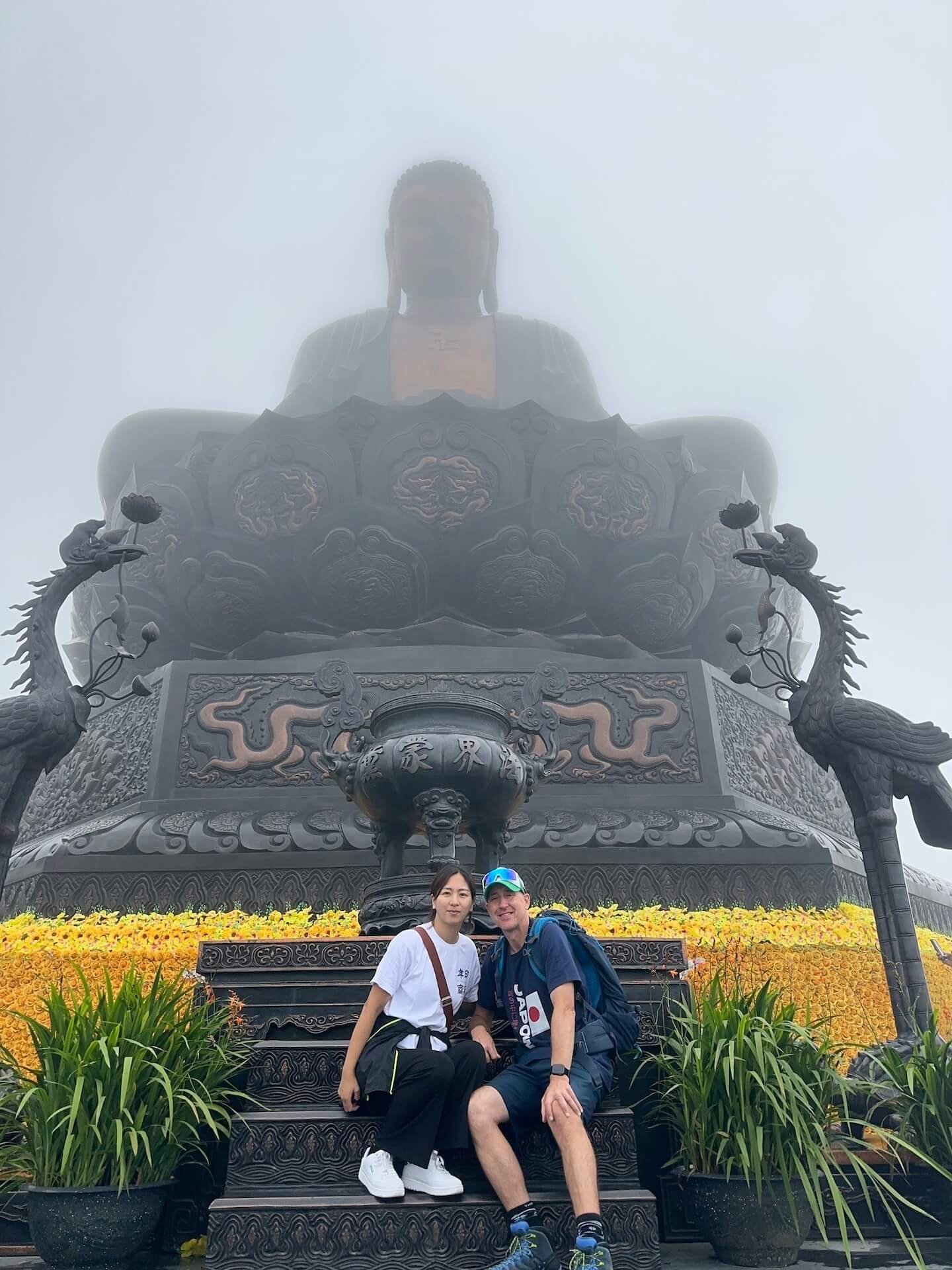
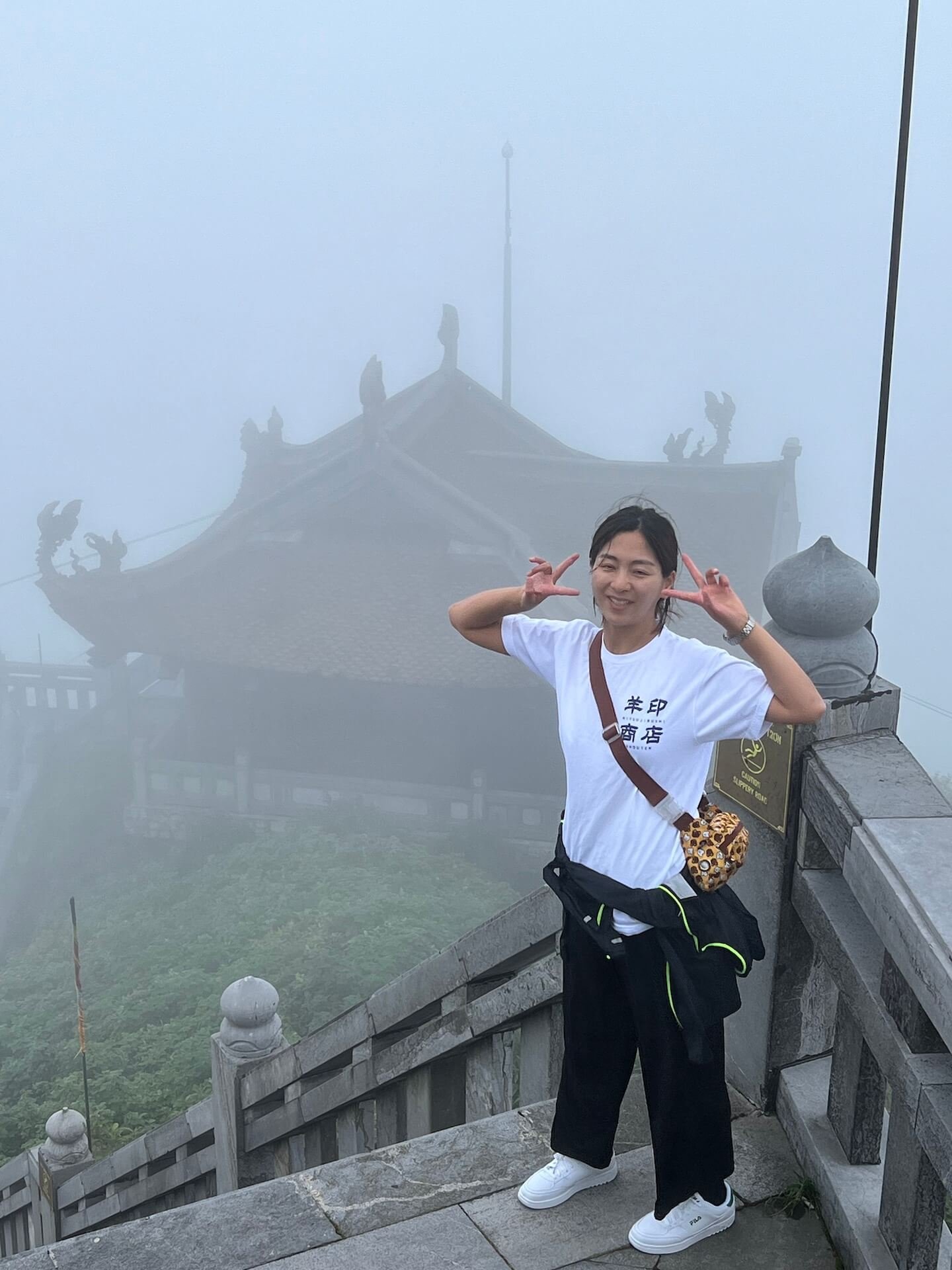
☕️ Food & Cafés at the Summit
Need to warm up? There are a few good spots to grab a bite or drink:
- Cafés – Hot tea, coffee, or in my case… ice cream in 50°F fog. No regrets 🙃
- Sit-down Restaurants – Serving Vietnamese noodle soups, rice dishes, and simple meals
Prices are slightly higher than in Sapa town, but not outrageous considering the altitude.

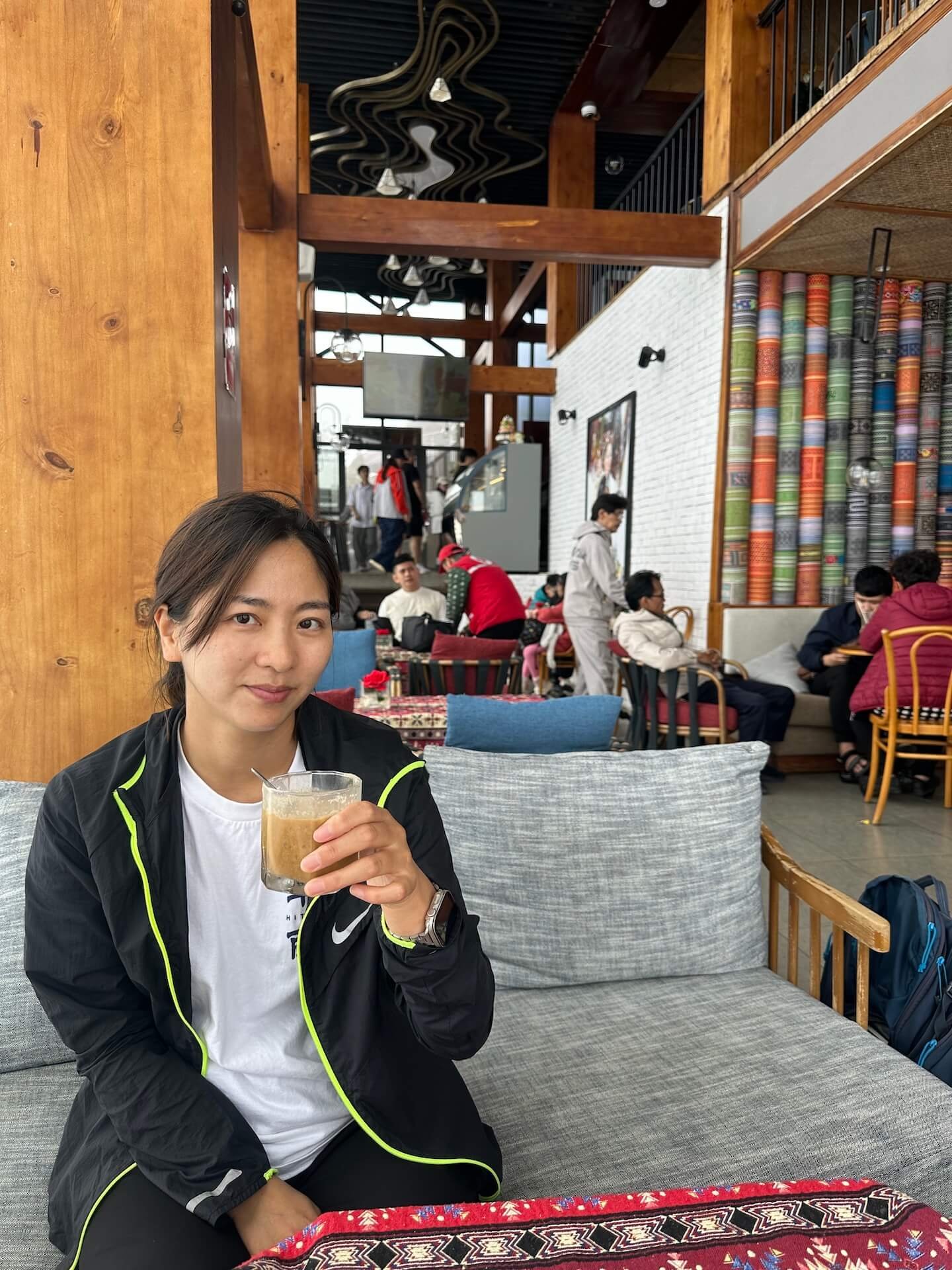
🧥 Fansipan Weather & Altitude Tips
Growing up in Colorado, I heard it all the time from my ski patrolman father:
“You can always take layers off, but you can’t put them on if you didn’t bring them.”
That advice definitely applies here.
Things to know:
- Colder Than Expected: Temps at the summit can be 10–15°C (18–27°F) colder than in town
- Altitude Effects: You may feel lightheaded or short of breath — take it slow
- Weather Variability: Fog, drizzle, and cold winds are common — check the forecast
- Footwear: Avoid flip-flops. Stairs and stone walkways can get slick
- Health Warning: If you have respiratory or heart issues, monitor how you feel — we saw a traveler getting help at the summit café
👘 Day 3 – Cat Cat Village & Traditional H’Mong Clothing Rental
Our final full day in Sapa was spent visiting Cat Cat Village, one of the most accessible ethnic minority villages in the region. Yes, it’s a bit touristy, but we still found it fun and photogenic — especially when my wife dressed up in full H’Mong attire for a rooftop photo shoot.
If you’re short on time or prefer an easier stroll over a muddy hike, Cat Cat is a great option. It offers well-paved trails, waterfalls, cafes, and a curated window into hill tribe life — albeit one built with tourists in mind.
Is Cat Cat Village Worth Visiting?
Short answer: Yes, as long as you manage your expectations.
Compared to remote villages like Lao Chai or Tả Van, Cat Cat is much more commercialized — but it still delivers:
- Scenic walking paths with mountain views
- Handicraft stalls and textile shops
- Cultural performances and photo ops galore
You’ll walk away with cool pictures, and if you’re lucky, a better appreciation for Black H’Mong culture.
📸 Case in point: my wife looked amazing in traditional dress. Me? Slightly less majestic.
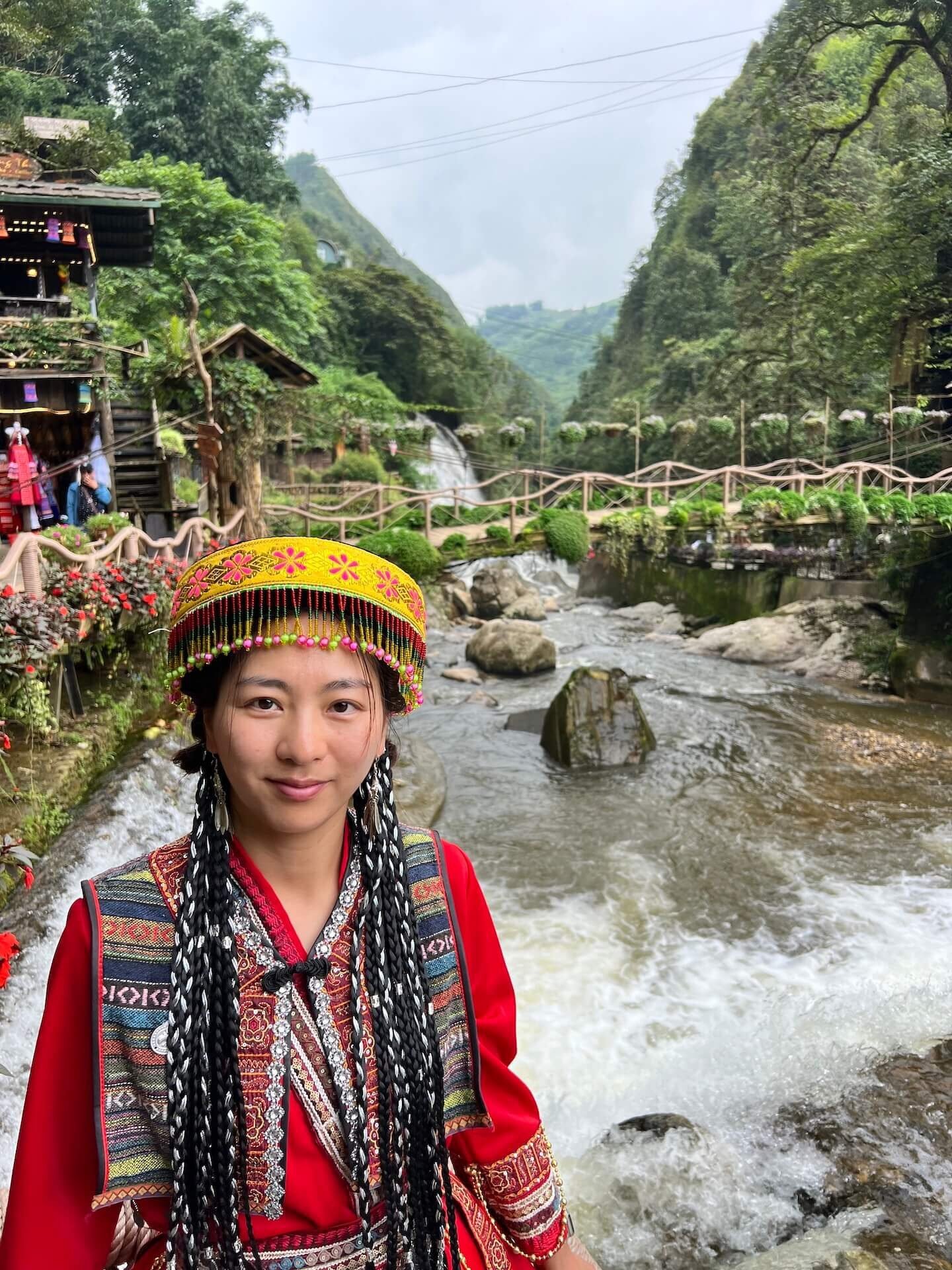

What to Expect in Cat Cat Village
- Paved loop trail through traditional-style homes and lush scenery
- Wooden bridges, streams, and mini waterfalls
- Dozens of souvenir shops selling handicrafts, snacks, and ethnic clothing
- Easy terrain — great for casual walkers and families
- Instagram-worthy viewpoints and curated photo spots
Cat Cat Entrance Fee & How to Get There
- 🎟 Entrance Fee: 50,000 VND (about $2 USD) — payable at the main gate
- 🚕 Getting There: We took a motorbike taxi (xe ôm) both ways. It’s fun, fast, and budget-friendly.
- 👟 Trekking Alternative: It’s walkable from Sapa town (about 3 km), but the return is uphill.
Want more structure? You can book a Cat Cat Village Half-Day Tour with hotel pickup and a guide for around $25 — available on platforms like Klook.
Renting Traditional H’Mong Clothing: A Cultural Photo Experience
One of the highlights of our Cat Cat visit was stopping by Peace’s House, a rental shop offering H’Mong and Red Dao-style outfits. It’s especially popular with Korean travelers — which might explain why we were there.
It was our last day in Sapa, so we wanted to do something fun and cultural to wrap up the trip. And yes — while I usually skip things like this, I’ll admit: it was way more fun than expected.
What to Expect When Renting Ethnic Clothing in Cat Cat Village
- Staff-assisted dressing – The team helped dress my wife in full H’Mong attire, including hair, jewelry, and makeup.
- Rooftop photo shoot – Before heading out, they snapped a few pro-style photos on their rooftop.
- Freedom to explore – She wore the outfit through the village, turning heads and getting compliments from strangers.
Meanwhile, I played the role of paparazzi husband — snapping candids and trying not to embarrass myself.
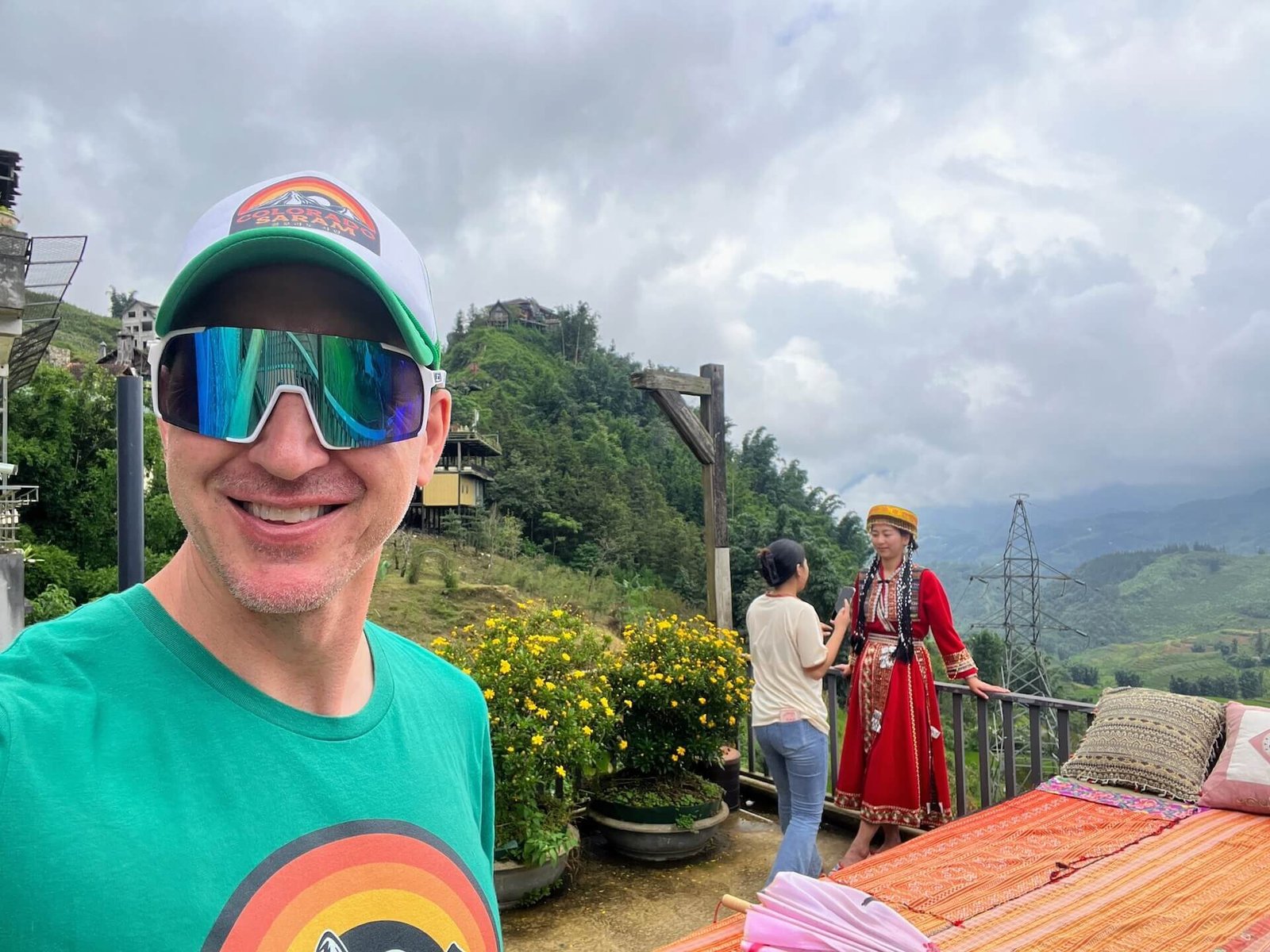
🎥 Watch: Rooftop H’Mong Photo Shoot in Cat Cat Village
Here’s a quick video from our visit to Peace’s House — behind the scenes of the dressing, rooftop shoot, and full Cat Cat glam session:
Final Thoughts on Our 3-Day Sapa Itinerary
If you’re headed to Sapa and want a balance of scenery, culture, and flexibility, this kind of DIY itinerary is hard to beat.
By skipping packaged tours and taking a self-guided approach, we were able to:
- Trek through misty valleys at our own pace
- Reach the top of Vietnam via cable car (without breaking a sweat)
- Rent traditional clothing and explore Cat Cat Village like locals (kind of)
Whether you follow our route exactly or mix and match days based on weather and energy levels, the key is flexibility. And with three nights and four days, you’ll have just enough time to soak in the beauty of this “town in the clouds” without feeling rushed.
Looking back, we wouldn’t change a thing — except maybe packing extra dry t-shirt for trekking day!
3-Day Sapa Itinerary at a Glance
| Day | Main Activity | Highlights |
|---|---|---|
| Day 1 | Self-Guided Trekking | Muong Hoa Valley, Lao Chai Village, scenic viewpoints, local lunch spots |
| Day 2 | Fansipan Peak by Cable Car | Muong Hoa Monorail, cable car views, mountaintop temples, summit photo ops |
| Day 3 | Cat Cat Village & Cultural Experience | H’Mong clothing rental, village walk, waterfalls, cafés, souvenir shopping |
🍜☕ Best Restaurants & Cafés in Sapa: Where to Eat
Sapa has a surprisingly diverse food scene, offering everything from hearty Vietnamese dishes to cozy cafés serving Western comfort food. Whether you’re after a scenic coffee spot, a steaming bowl of phở, or a hidden gem with a friendly dog, here are some of our favorite places to eat in Sapa.
☁️🍵 White Cloud Coffee & Restaurant – Best Views in Sapa
Tucked just off Fansipan Street, White Cloud Coffee & Restaurant is a laid-back café serving strong Vietnamese coffee, fresh teas, and a mix of local and Western dishes. The balcony seating offers stunning mountain views, making it the perfect place to unwind—and to flood your Instagram with scenic shots of your meal.
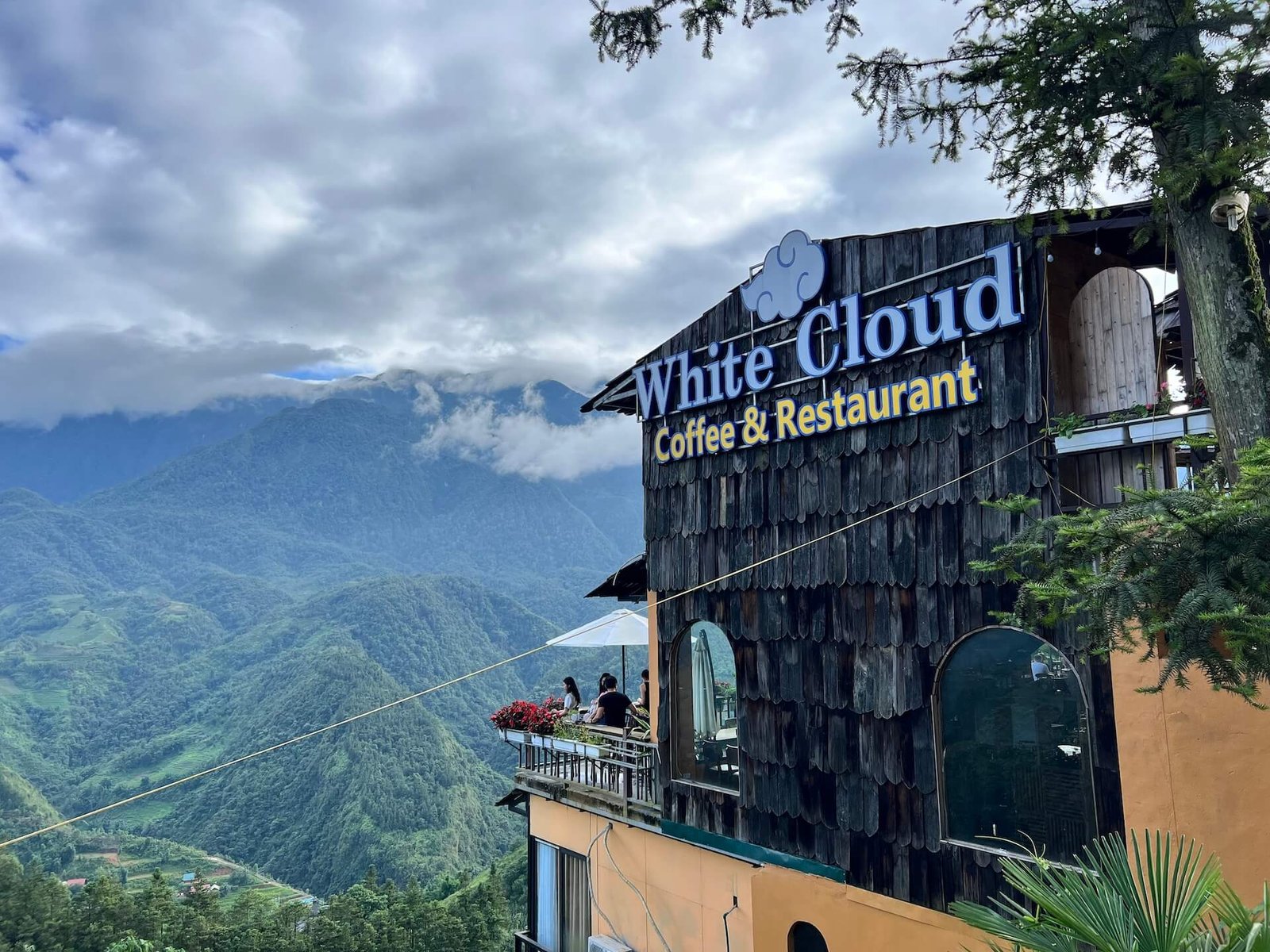
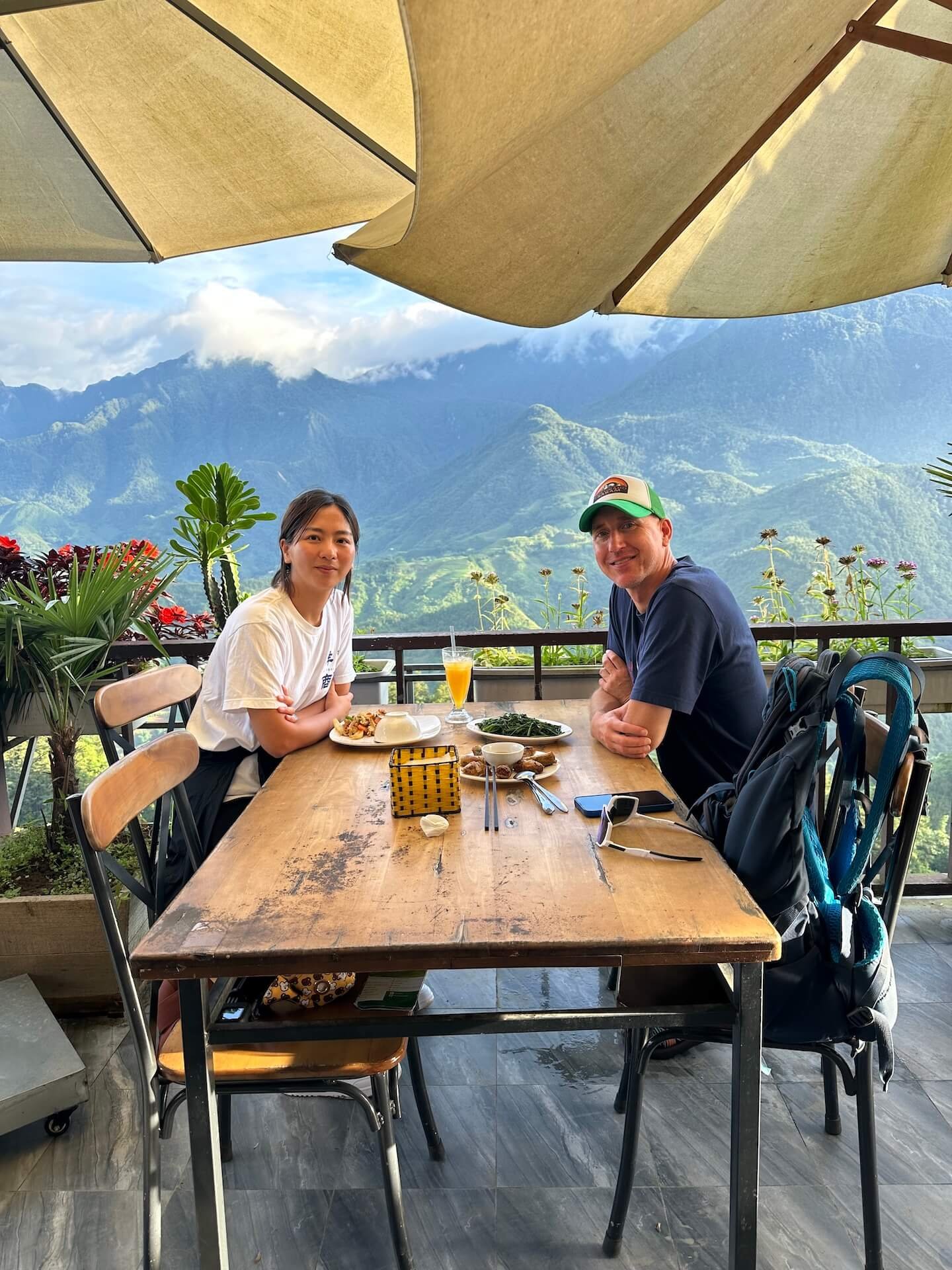
White Cloud is a short walk from Sapa’s central Stone Church. Just head downhill on Fansipan Street for about 700 meters, then turn onto a quieter side street where you’ll find both White Cloud and Good Morning Vietnam.
🍛🇻🇳 Good Morning Vietnam – Authentic Vietnamese Comfort Food
Just a few steps from White Cloud, Good Morning Vietnam Restaurant serves authentic Vietnamese cuisine in a cozy, no-fuss setting. There’s indoor seating, but we preferred the patio, where we could soak in the views and watch travelers navigate the hilly street.
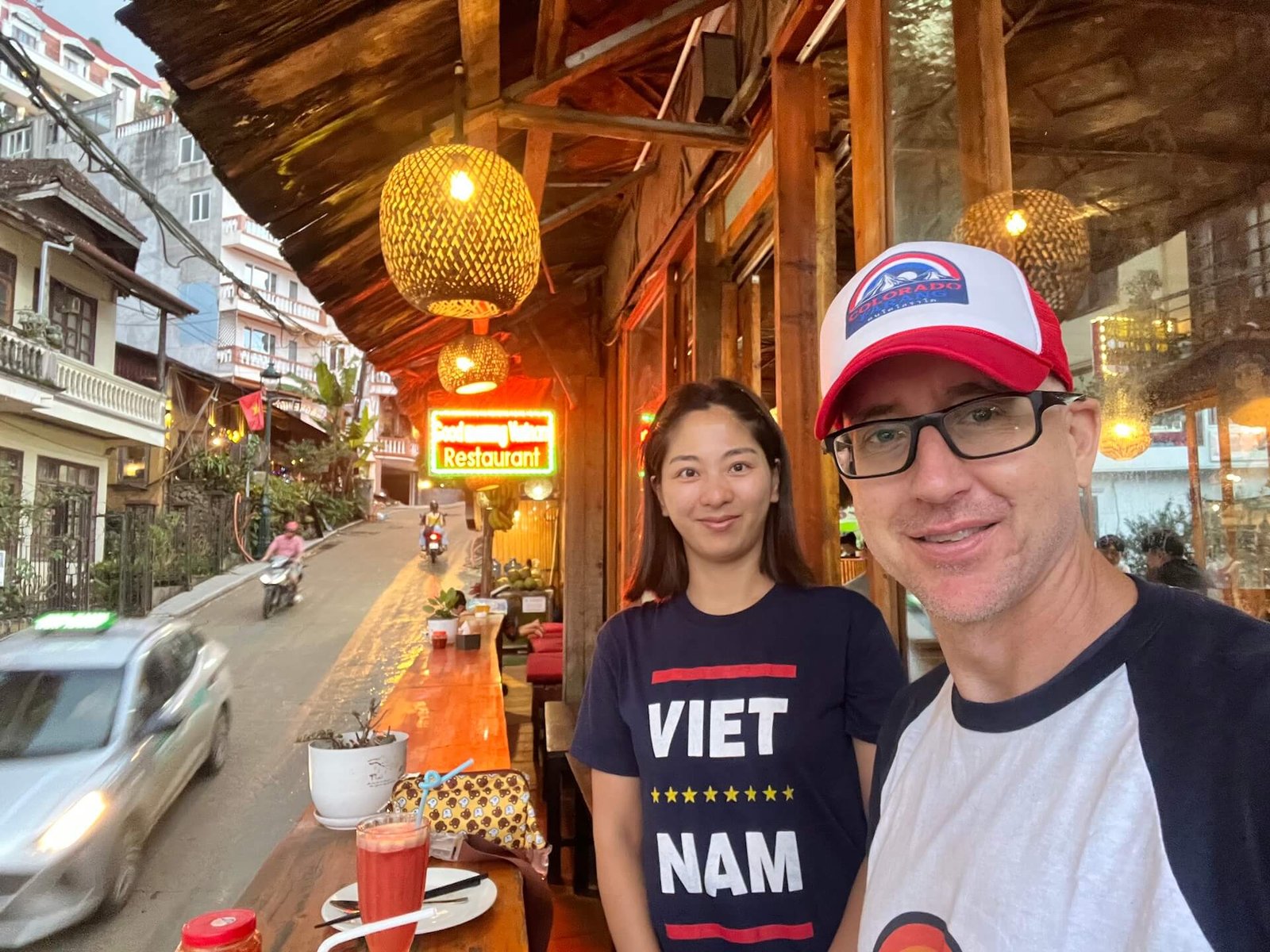
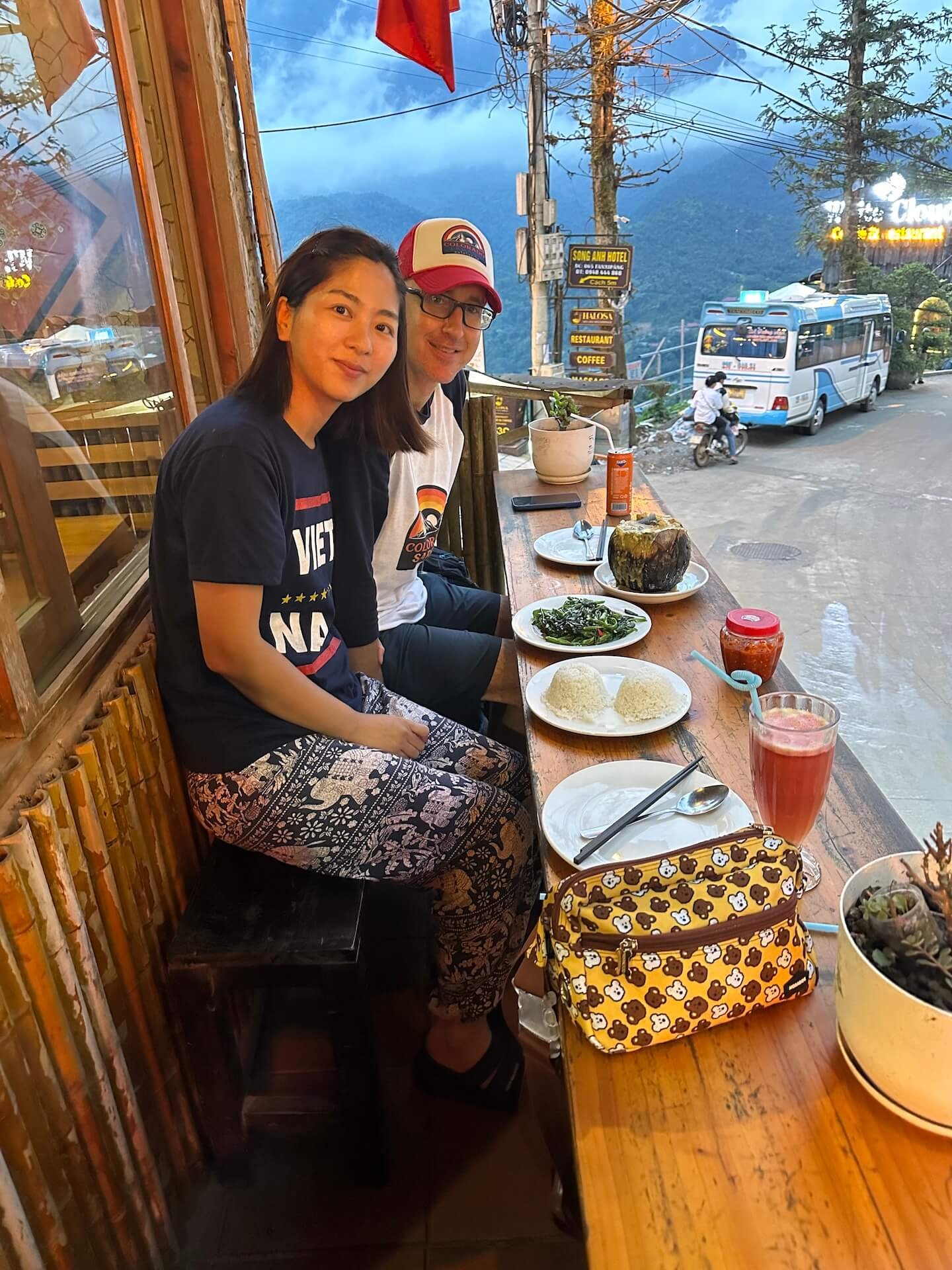
I ordered a Hawaiian pizza (don’t judge), and my wife had a rich, flavorful coconut curry—served right in a coconut. You’ll also find grilled pork, morning glory, and other local favorites on the menu. Affordable, filling, and full of local flavor.
🐶 The Hidden Café with the Friendly Golden Retriever
One of our favorite surprise finds in Sapa was a tiny hole-in-the-wall restaurant just up the street from Pao’s Hotel on the lower end of town. It didn’t have much signage—at least not that we noticed—so we just called it “the one with the adorable golden retriever.”

We didn’t eat there, but it seemed popular with budget travelers looking for cheap, home-cooked meals. The highlight? A very good boy named Chi, lounging out front and greeting every passerby like he owned the place.
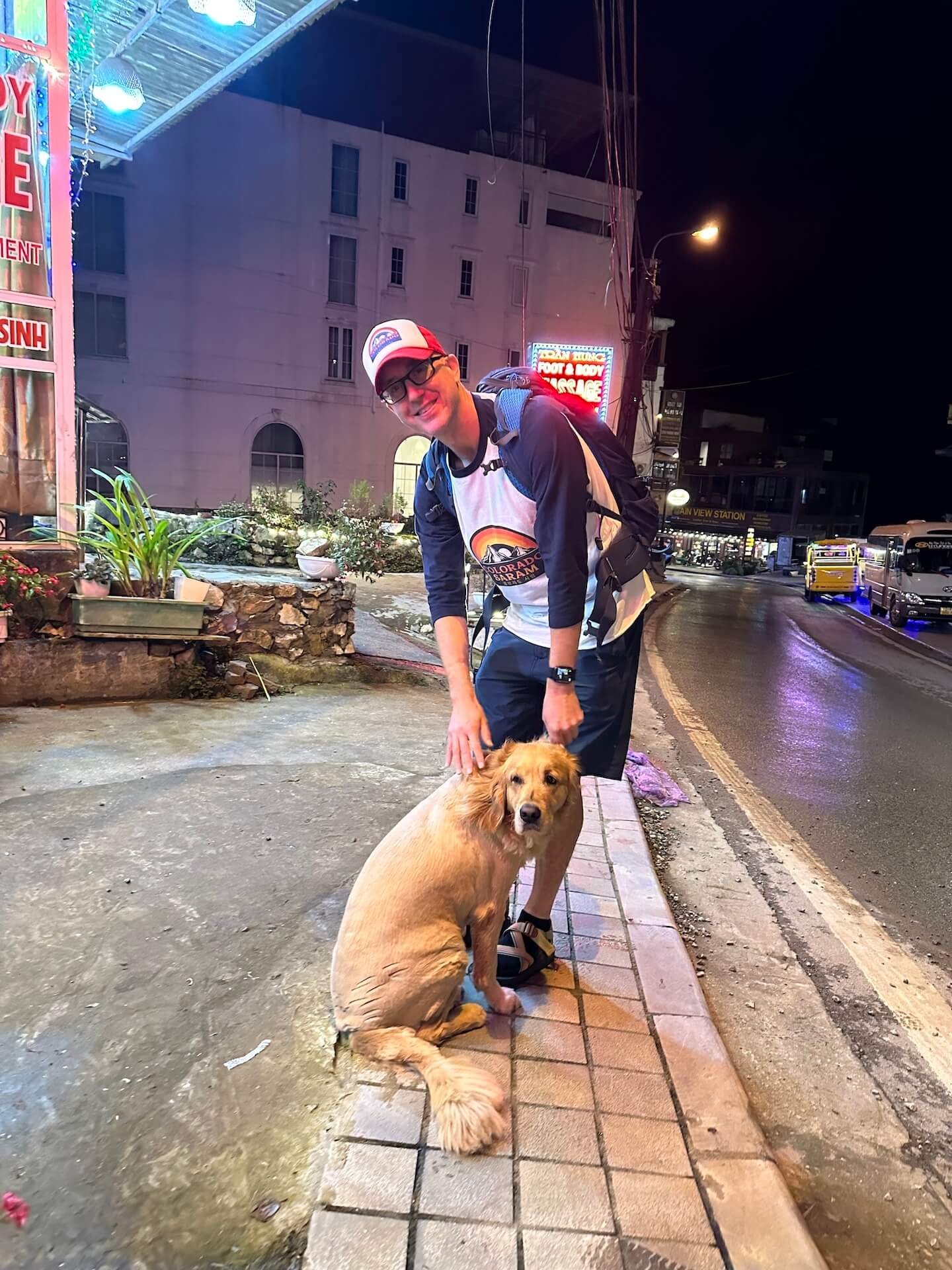

🍜 Yummy Restaurant – Casual, Budget-Friendly Eats
Located right on the main road near Pao’s Hotel, Yummy Restaurant is a reliable go-to for both Vietnamese and Western fare. We liked the outdoor seating for people-watching, but there’s also a rooftop area if you’re chasing a better view.
Service was fast, prices were great, and the menu had something for everyone—whether you’re craving noodle soup, pancakes, or a stir-fried rice bowl. A solid, no-fuss pick for casual meals in Sapa.
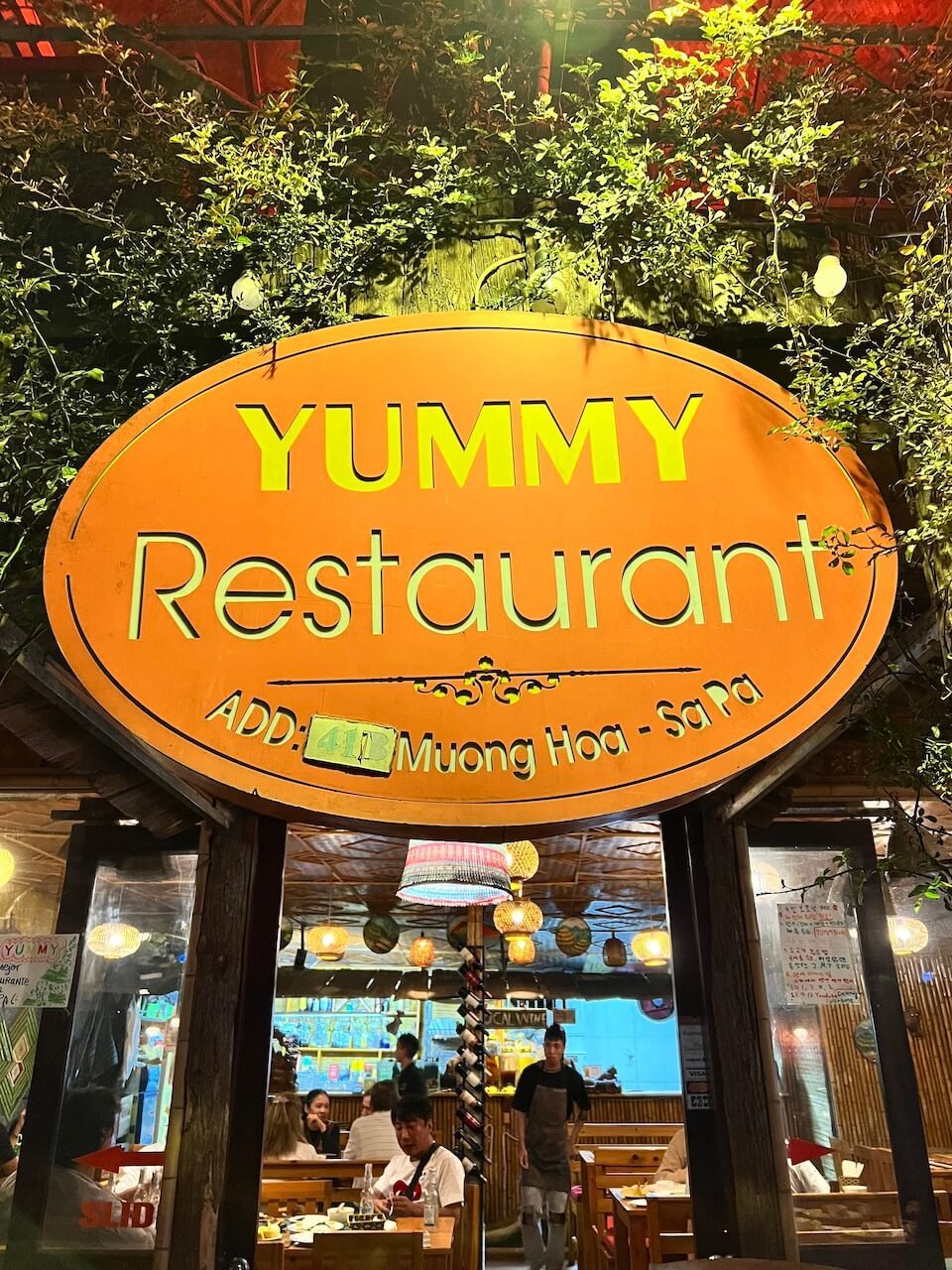
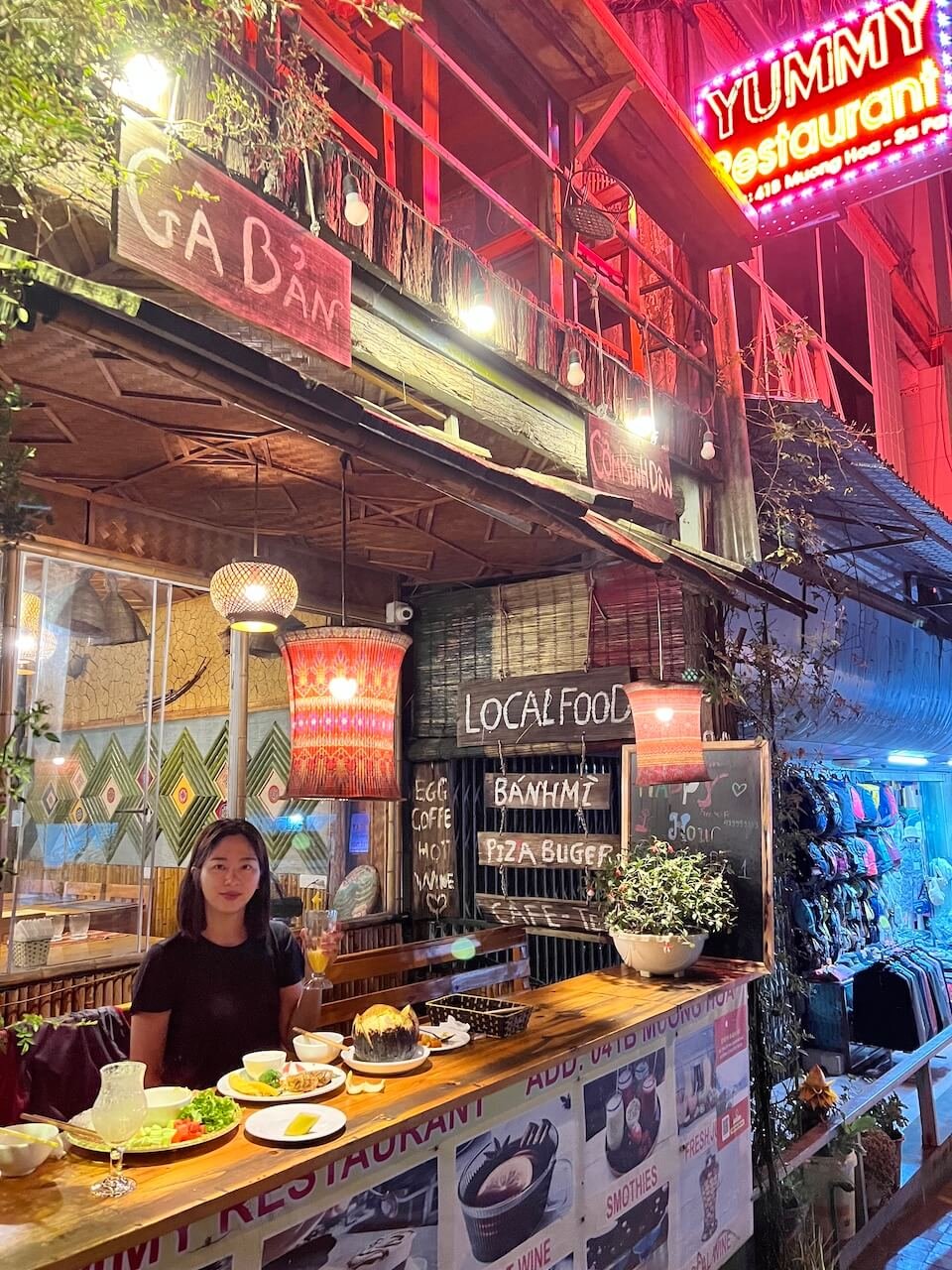
Our Favorite Places to Eat in Sapa – Quick Comparison Table
| Name | Best For | Price Range | Distance from Town Center |
|---|---|---|---|
| White Cloud Coffee & Restaurant | Balcony views & coffee | $$ | ~10–15 min walk |
| Good Morning Vietnam | Local dishes & quiet setting | $–$$ | Next to White Cloud |
| Hidden Café w/ Golden Retriever | Friendly vibes & pets | $ | Near Pao’s Sapa Hotel |
| Yummy Restaurant | Budget eats & variety | $ | Main road near Pao’s |
🤔 Final Thoughts on Exploring Sapa Without a Tour
Sapa is one of Vietnam’s most iconic destinations—and while many travelers opt for guided tours, exploring Sapa without a guide is not only possible, it can be incredibly rewarding.
We spent three nights and four days in Sapa, visiting during the rainy season, and tackled everything independently: a self-guided trek through the Muong Hoa Valley, a cable car trip to Fansipan Peak, a cultural walk through Cat Cat Village, and plenty of unhurried café time. Not once did we feel like we needed a tour to enjoy or understand the experience.
That said, self-guided travel isn’t for everyone. So here’s a quick rundown of the pros and cons.
Pros & Cons of Independent Travel in Sapa
✅ Pros:
- Total flexibility to explore on your own schedule
- Save money by skipping guide or tour fees
- Easy access to Sapa’s top attractions via foot, motorbike taxi, or Grab
- Book everything online in advance—no language barrier or haggling required
- More spontaneous, more personal, more satisfying
❌ Cons:
- Requires a bit more research and preparation
- Local guides offer deeper cultural insight, especially in ethnic minority villages
- Less support if something goes wrong on the trail or en route
- Not ideal if you want to explore harder-to-reach villages
Would I Visit Sapa Again Without a Guide?
Absolutely.
That’s not to say I wouldn’t ever consider hiring a guide—especially for a longer multi-day trek, or to learn more about the history and customs of the Black H’Mong or Red Dao people. But for a short trip where flexibility was key, our DIY approach was exactly what we needed.
We had the freedom to wake up when we wanted, linger at scenic spots, and take breaks without watching the clock. We still supported local businesses by booking accommodations, dining in family-run restaurants, and renting traditional clothing in Cat Cat Village. And thanks to online tools and offline maps, getting around was easy—even in the rain.
If you’re a confident traveler who enjoys figuring things out on your own, Sapa is one of the best places in Vietnam to do just that. And if you’re on the fence? Consider starting with one or two self-guided activities and mix in a half-day tour—it doesn’t have to be all or nothing.
Still Not Sure If You Should Explore Sapa Without a Guide?
Here’s the quick decision tree:
- You enjoy wandering, map apps, and a little uncertainty? → Go solo.
- You want cultural context, local stories, and a stress-free trek? → Book a guide.
- You want the best of both worlds? → Mix it up—do one day on your own, one with a guide.
- Sapa’s flexible like that.
❓ FAQs: Sapa, Vietnam Travel Guide
Is it possible to explore Sapa without a guide or tour?

Yes! Sapa is very doable as an independent traveler if you’re comfortable with a little DIY planning. You can trek between villages, ride the Fansipan cable car, and visit Cat Cat Village on your own. Booking transport and tickets online is simple, and you’ll find plenty of cafes and accommodations without needing a guide.
What’s the best way to travel from Hanoi to Sapa?

It depends on your priorities:
Comfort & convenience: Shared mini-van (~$20, 5–6 hours)
Budget option: Sleeper buses (~$10–$15, 6–7 hours)
Scenic & nostalgic: Overnight train (~$30–$100, 8+ hours) to Lao Cai, then a shuttle to Sapa
Do I need to book Fansipan Cable Car tickets in advance?

Not mandatory, but highly recommended. Booking in advance on Klook saves time, secures your spot, and gives you a scannable barcode for fast entry. Tickets are also sold at the Sun Plaza booth in Sapa, but lines can get long—especially in high season.
Is Sapa worth visiting in the rainy season?
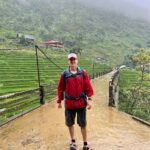
Definitely—if you’re prepared for rain and muddy trails. The rice terraces are at their most vibrant, and there are fewer tourists. Bring waterproof gear and a flexible mindset, and you’ll have an amazing time despite the weather.
How long does a self-guided trek from Sapa to Lao Chai take?
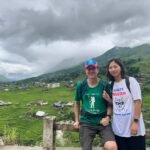
Expect 6–8 hours total, including rest stops. Your pace, weather, and photo breaks will affect the time. If needed, you can take a Grab or motorbike taxi back from Lao Chai.
What should I pack for a self-guided trek in Sapa?

Essentials include:
– Hiking shoes or sandals with good grip
– A waterproof jacket
– Water, snacks, sunscreen, and insect repellent
– Phone with offline maps (Google Maps or Maps.me)
– Small cash for food or transportation
Is Cat Cat Village worth visiting without a guide?
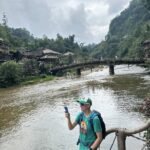
Yes, especially for first-timers or travelers short on time. It’s more touristy than remote villages like Lao Chai or Tả Van, but it still offers scenic views, photo opportunities, and cultural performances. Just expect crowds and lots of souvenir stalls.
What are the best places to eat in Sapa?
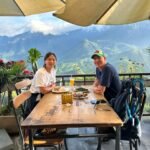
Here are a few of our personal favorites:
White Cloud Coffee & Restaurant – Best views and chill vibes
Good Morning Vietnam – Delicious local dishes
Yummy Restaurant – Affordable and tasty
The Café with the Golden Retriever – No name, just a friendly pup and budget eats 🐶
What’s the best place to stay in Sapa?
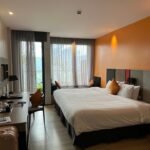
Luxury or midrange: Pao’s Sapa Leisure Hotel – modern comfort with amazing views
Budget: Pea Hostel or Eco Rice Fields House
Authentic experience: Village homestays in Lao Chai or Tả Van
What’s the altitude at Fansipan Peak, and do I need to prepare for it?
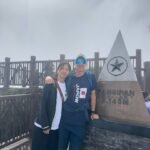
Fansipan is 3,147 meters (10,324 feet) above sea level. Most travelers won’t experience severe altitude sickness, but you may feel a bit light-headed. Dress warmly, take your time, and stay hydrated at the summit.
🛒 Custom “Town in the Clouds” T-Shirt – A Unique Sapa Souvenir
Looking for a cool Sapa souvenir that isn’t just another mass-produced fridge magnet? I design custom travel T-shirts for destinations I visit—especially for places where it’s hard to find stylish merch that doesn’t scream tourist trap.
This “Town in the Clouds” Sapa tee was inspired by the misty mountain views and laid-back vibe that made Sapa one of our favorite stops in Vietnam.
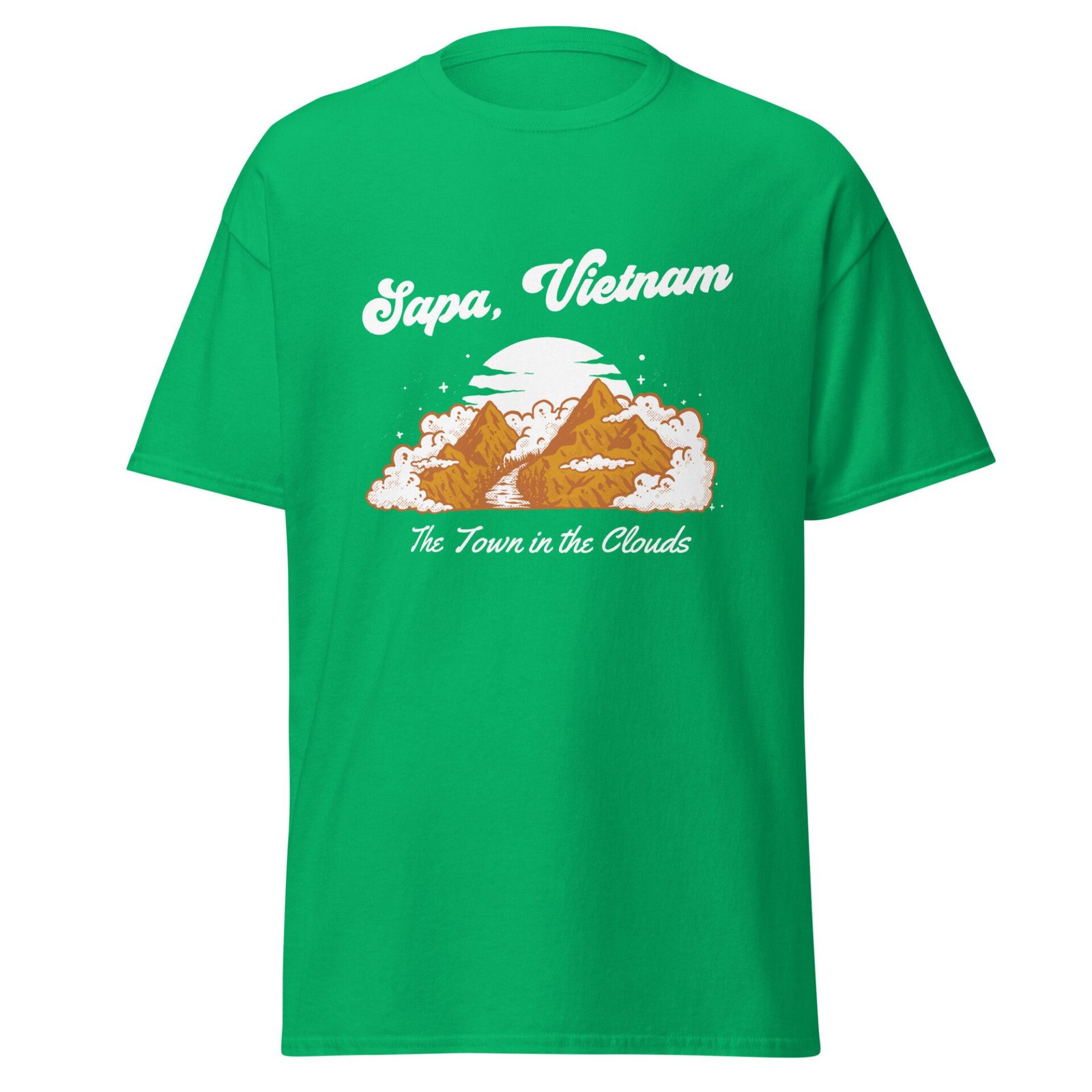
🌴 Next Stop: Phu Quoc Island – Beach Time After the Mountains
After three misty, mountainous days in Sapa, we headed south to chase the sun—and landed on Vietnam’s largest island paradise. Phu Quoc offered a totally different vibe: motorbiking the coast, hopping between beach bars, and hunting for hidden coves between rain showers and bursts of dry season sun.
If you’re planning to pair Sapa with a beach escape, Phu Quoc is a great contrast to the cool highlands of the north.
👉 Read next: Phu Quoc Dry vs Rainy Season – A Firsthand Travel Guide
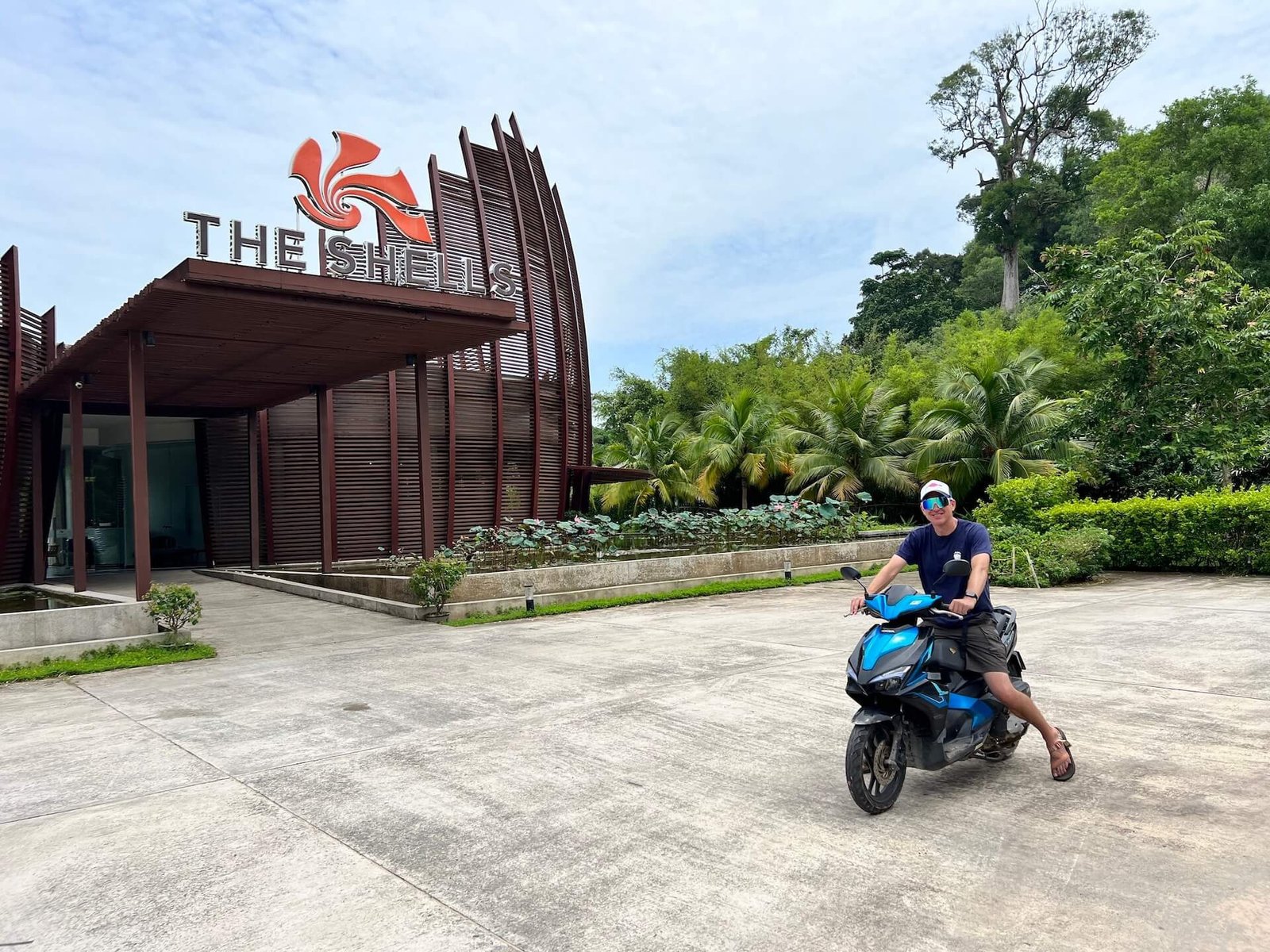
🧭 Need Help Planning Your Adventure?
Feeling a little overwhelmed piecing it all together — when to go, which trek to pick, where to stay, or how to link it with the rest of your Asia plans?
I’m running a free pilot program offering one-on-one planning support for curious, independent travelers heading to Asia. There’s no catch — just real help from someone who’s been there, minus the hard sell or tour package pressure.
Whether you’re torn between treks or figuring out how to build a bigger adventure around it, I’ll help you map it out with personalized advice and practical tools.
👉 Learn more and get free help with your trip planning →
-or-


